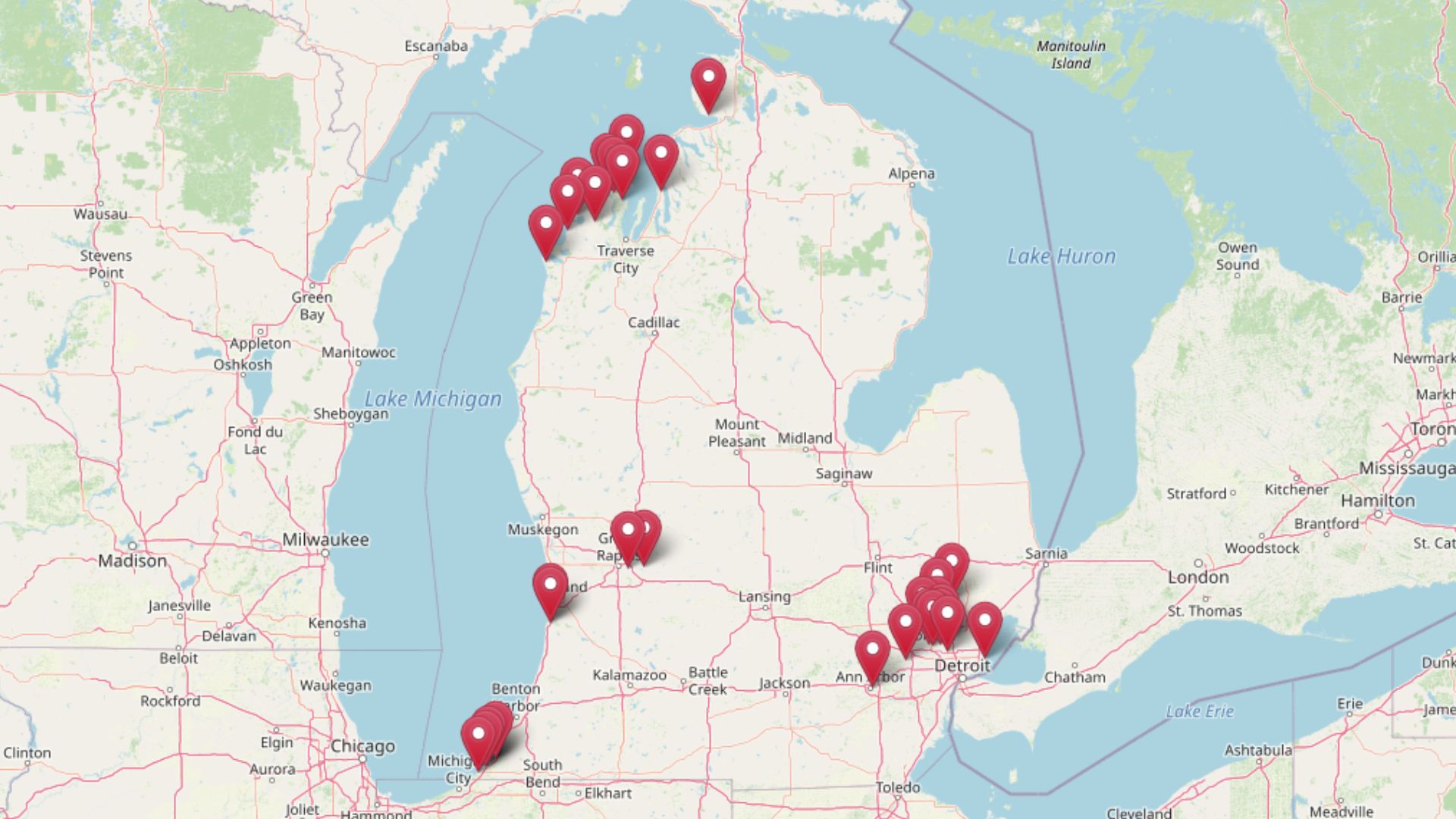
Using the latest Zillow Home Value Index data, we’ve identified the 30 most expensive towns in Michigan based on current home prices. These communities represent more than just high costs—they reflect decades of growth, strategic location advantages, and unique lifestyle offerings that continue to draw buyers willing to pay premium prices.
From historic lakefront villages to exclusive suburban enclaves, each town on this list has carved out its own identity in Michigan’s competitive housing market. The data reveals fascinating patterns of growth, resilience through economic changes, and the enduring appeal of waterfront living throughout the Great Lakes State.
30. Frankfort – 115.3% Home Price Increase Since 2010
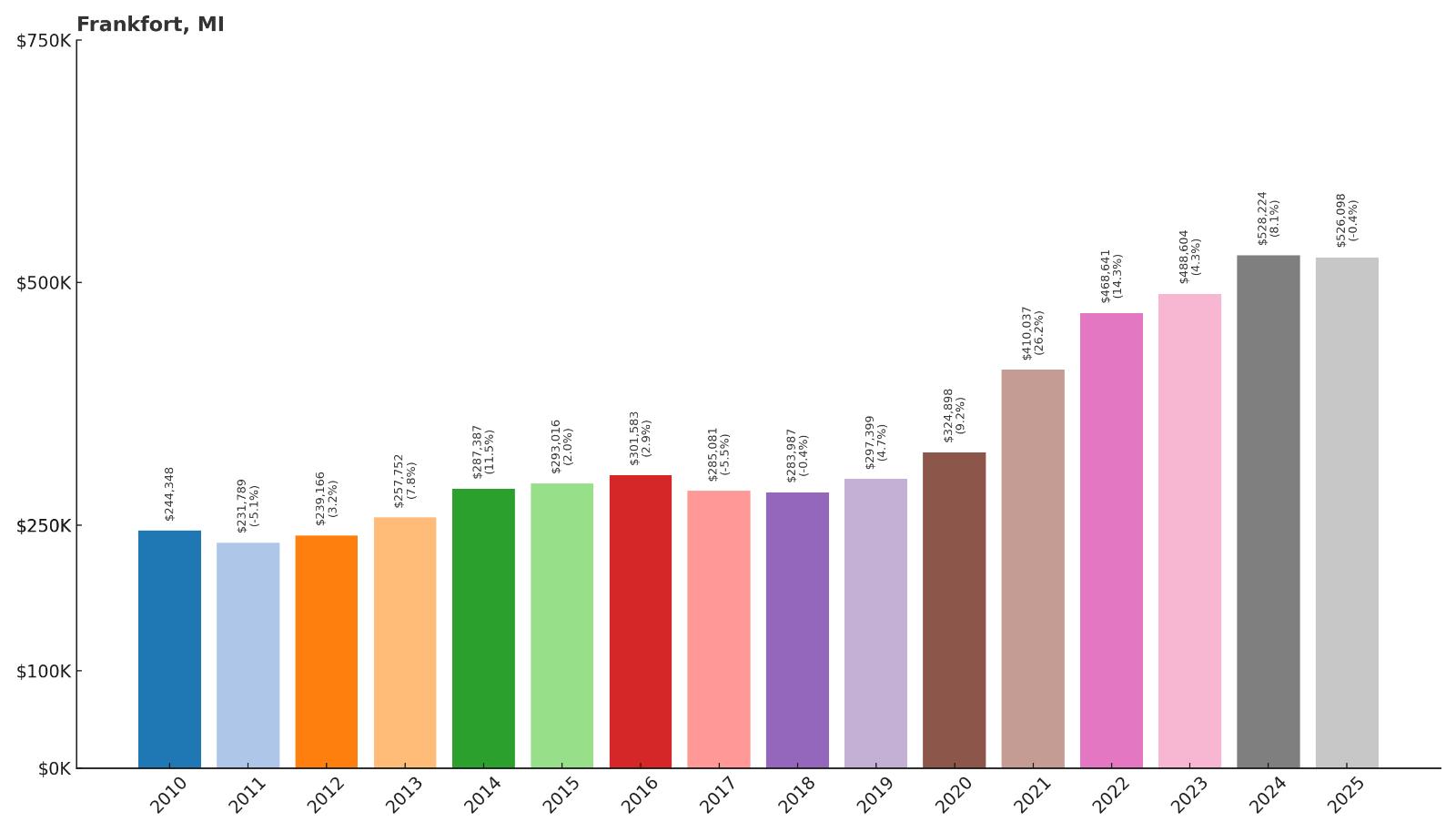
- 2010: $244,348
- 2011: $231,789
- 2012: $239,166
- 2013: $257,752
- 2014: $287,387
- 2015: $293,016
- 2016: $301,583
- 2017: $285,081
- 2018: $283,987
- 2019: $297,399
- 2020: $324,898
- 2021: $410,037
- 2022: $468,641
- 2023: $488,604
- 2024: $528,224
- 2025: $526,098
Frankfort’s housing values more than doubled over 15 years, with the most dramatic growth occurring during the pandemic years. The town weathered some volatility in 2017-2018, but consistent demand has pushed median prices above $526,000 by 2025. This lakefront community on Lake Michigan has benefited from the broader trend of buyers seeking scenic, smaller towns with recreational opportunities.
Why Frankfort?
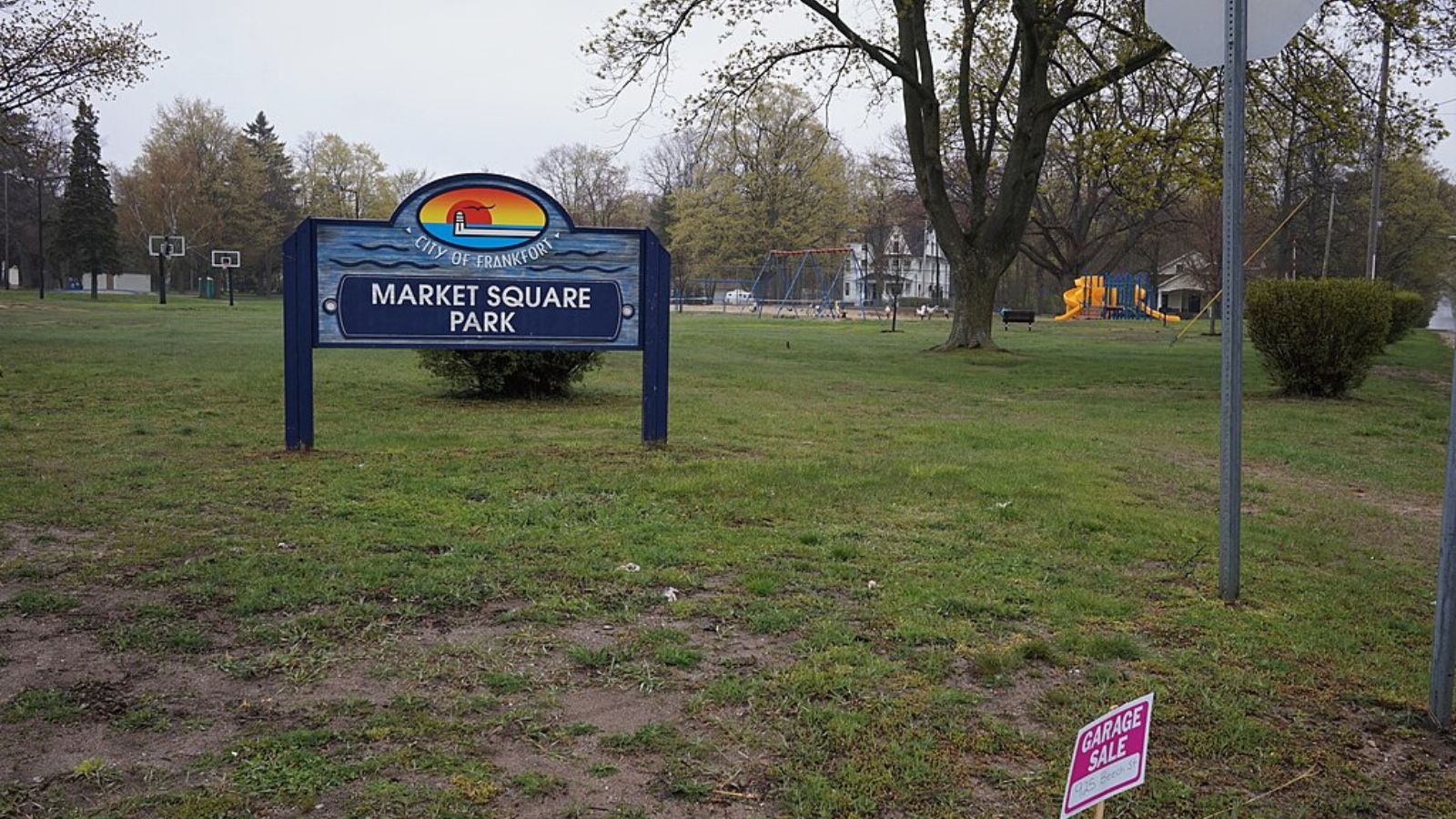
Why are people willing to pay so much to live here? What’s special about it?
Frankfort sits perfectly positioned on the shores of Lake Michigan, offering residents both stunning sunsets and access to Sleeping Bear Dunes National Lakeshore. The town maintains a working lighthouse, pristine beaches, and a charming downtown area that feels authentically Michigan without being overly commercialized. Buyers are drawn to the combination of natural beauty, outdoor recreation, and the peaceful pace of a small lakefront community.
The town’s location at the mouth of Betsie Lake creates a unique dual-water environment that appeals to boaters and water sports enthusiasts. Quality schools, low crime rates, and proximity to other Leelanau Peninsula destinations make it attractive for families seeking a premium but relaxed lifestyle along Michigan’s coast.
How Frankfort Rose to Prominence
Frankfort began as a lumber town in the 1860s, taking advantage of its natural harbor where Betsie Lake meets Lake Michigan. The town became an important shipping point for timber and later transformed into a resort destination as wealthy visitors from Chicago and Detroit discovered its scenic beauty. The construction of the Frankfort North Breakwater Light in 1873 established the town’s maritime identity.
As the lumber industry declined, Frankfort reinvented itself around tourism and recreation, capitalizing on its location along what would become the famous M-22 scenic highway. The town’s inclusion near Sleeping Bear Dunes National Lakeshore in the 1970s further elevated its profile as a destination for outdoor enthusiasts and summer residents seeking a more authentic Michigan experience.
3 Interesting Tidbits
1. Lighthouse Legacy – Frankfort’s North Breakwater Light, built in 1912, is one of the most photographed lighthouses in Michigan and serves as the town’s unofficial symbol.
2. Betsie Bay Connection – The town sits where Betsie Lake connects to Lake Michigan, creating a unique “two-lake” environment that offers both calm inland waters and dramatic Great Lakes shoreline.
3. Film Fame – Parts of the town have appeared in several Michigan-made films, including scenes that showcase its authentic small-town character and stunning lakefront setting.
29. Ann Arbor – 128.8% Home Price Increase Since 2010
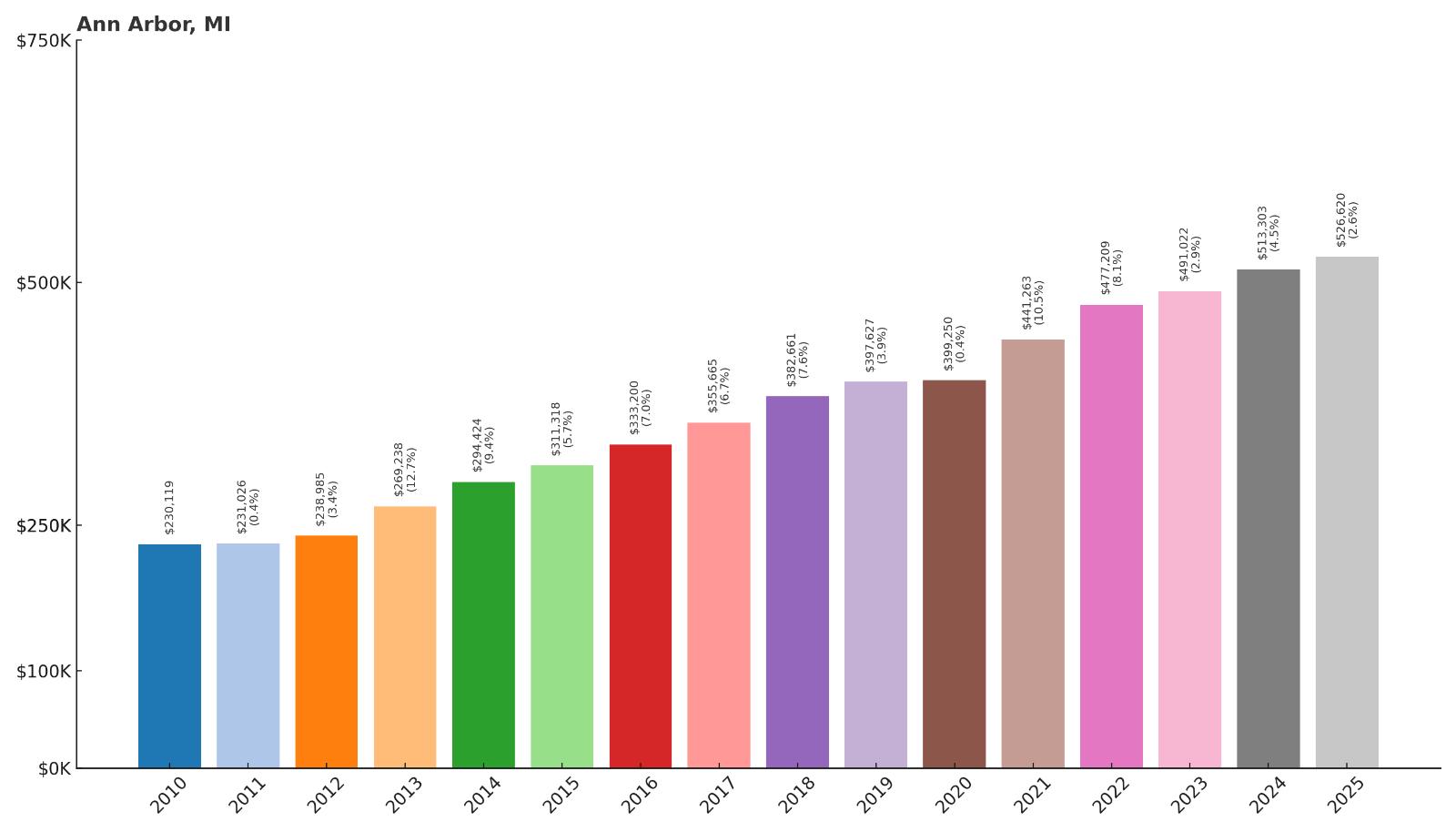
- 2010: $230,119
- 2011: $231,026
- 2012: $238,985
- 2013: $269,238
- 2014: $294,424
- 2015: $311,318
- 2016: $333,200
- 2017: $355,665
- 2018: $382,661
- 2019: $397,627
- 2020: $399,250
- 2021: $441,263
- 2022: $477,209
- 2023: $491,022
- 2024: $513,303
- 2025: $526,620
Ann Arbor shows steady, consistent growth with home values climbing steadily each year since 2010. The town avoided major dips even during economic uncertainty, reflecting the stability that comes with being home to the University of Michigan. Current median prices at $526,620 represent sustained demand from professionals, academics, and families drawn to this college town’s amenities.
Why Ann Arbor?

Why are people willing to pay so much to live here? What’s special about it?
Ann Arbor combines the intellectual energy of a major research university with the cultural amenities of a much larger city. The University of Michigan provides world-class healthcare through its medical system, top-rated schools, and a constant stream of cultural events, from concerts at Hill Auditorium to major college athletics. The downtown area buzzes with restaurants, theaters, and boutique shopping that rivals cities many times its size.
Beyond the university connection, Ann Arbor attracts tech professionals and healthcare workers who appreciate the city’s progressive atmosphere and educated population. The combination of job opportunities, cultural richness, and strong public services creates a quality of life that many residents find worth paying premium housing costs to maintain.
How Ann Arbor Rose to Prominence
Ann Arbor was founded in 1824 and selected as the home of the University of Michigan in 1837, when the state was still frontier territory. This early decision to locate the state university here shaped everything that followed, as the town grew around the educational institution. The university’s expansion through the 19th and 20th centuries brought national recognition and attracted top faculty and students.
The city’s evolution into a technology and healthcare hub occurred gradually, as university research led to spin-off companies and medical facilities. The development of the University of Michigan Health System into one of the nation’s top medical centers further elevated Ann Arbor’s profile, creating a sustainable economy that extends well beyond traditional college town boundaries.
3 Interesting Tidbits
1. Hash Bash Heritage – Ann Arbor hosts the annual Hash Bash, a marijuana reform rally that has taken place since 1972, reflecting the city’s long-standing progressive culture.
2. Arts Festival Fame – The Ann Arbor Art Fair, held each July, is one of the largest outdoor art fairs in the United States, drawing hundreds of thousands of visitors and featuring over 1,000 artists.
3. Presidential Debates – The University of Michigan has hosted multiple presidential debates, including the famous 1976 Carter-Ford debate and the 2020 Democratic primary debate.
28. Harbor Springs – 114.3% Home Price Increase Since 2010
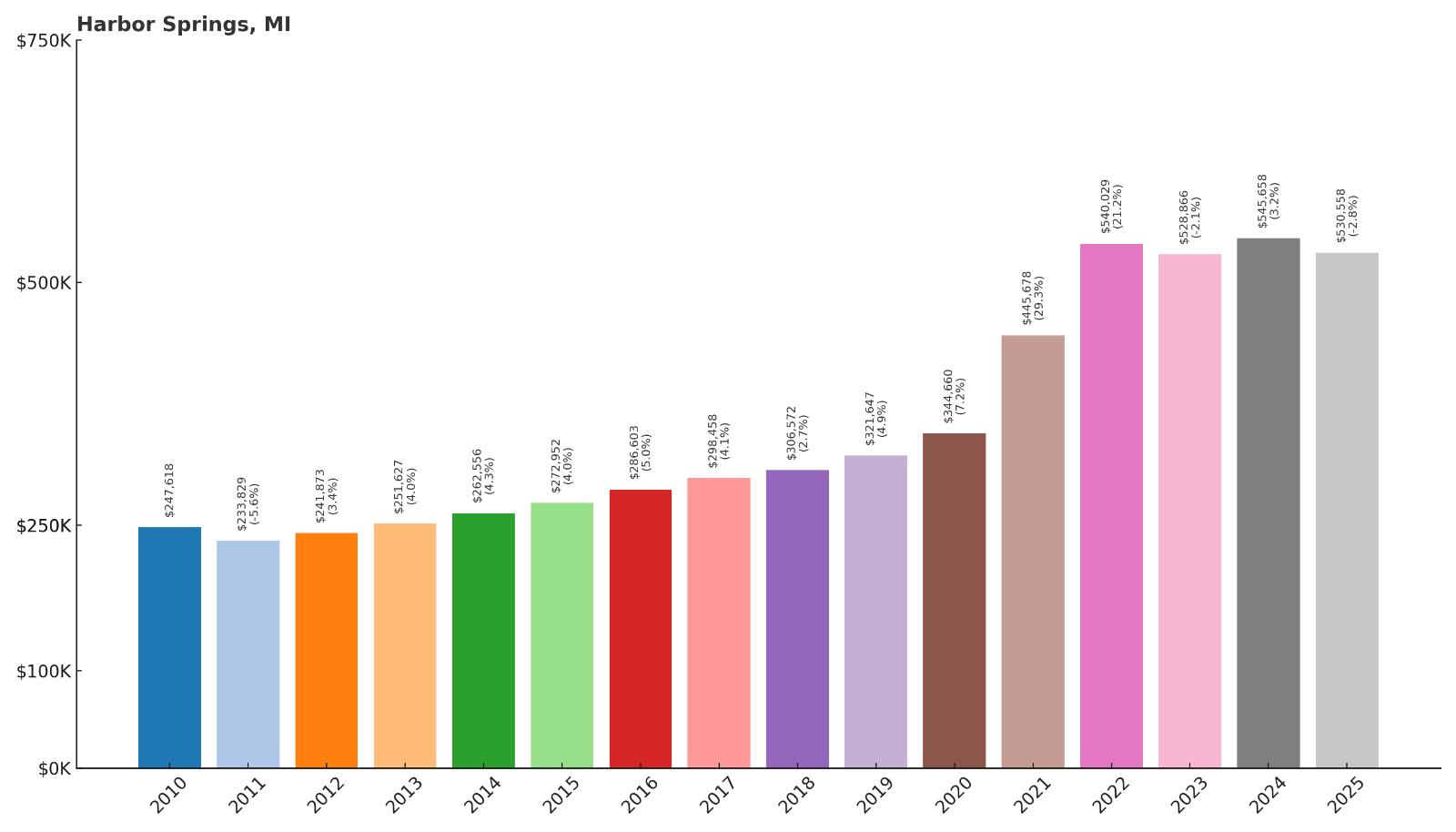
- 2010: $247,618
- 2011: $233,829
- 2012: $241,873
- 2013: $251,627
- 2014: $262,556
- 2015: $272,952
- 2016: $286,603
- 2017: $298,458
- 2018: $306,572
- 2019: $321,647
- 2020: $344,660
- 2021: $445,678
- 2022: $540,029
- 2023: $528,866
- 2024: $545,658
- 2025: $530,558
Harbor Springs experienced steady growth through 2021, followed by a sharp jump to over $540,000 in 2022. Values have stabilized around $530,000, showing this northern Michigan resort town has found its pricing equilibrium. The dramatic increase during 2021-2022 reflects the broader pandemic-driven migration to scenic, recreation-focused communities.
Why Harbor Springs?
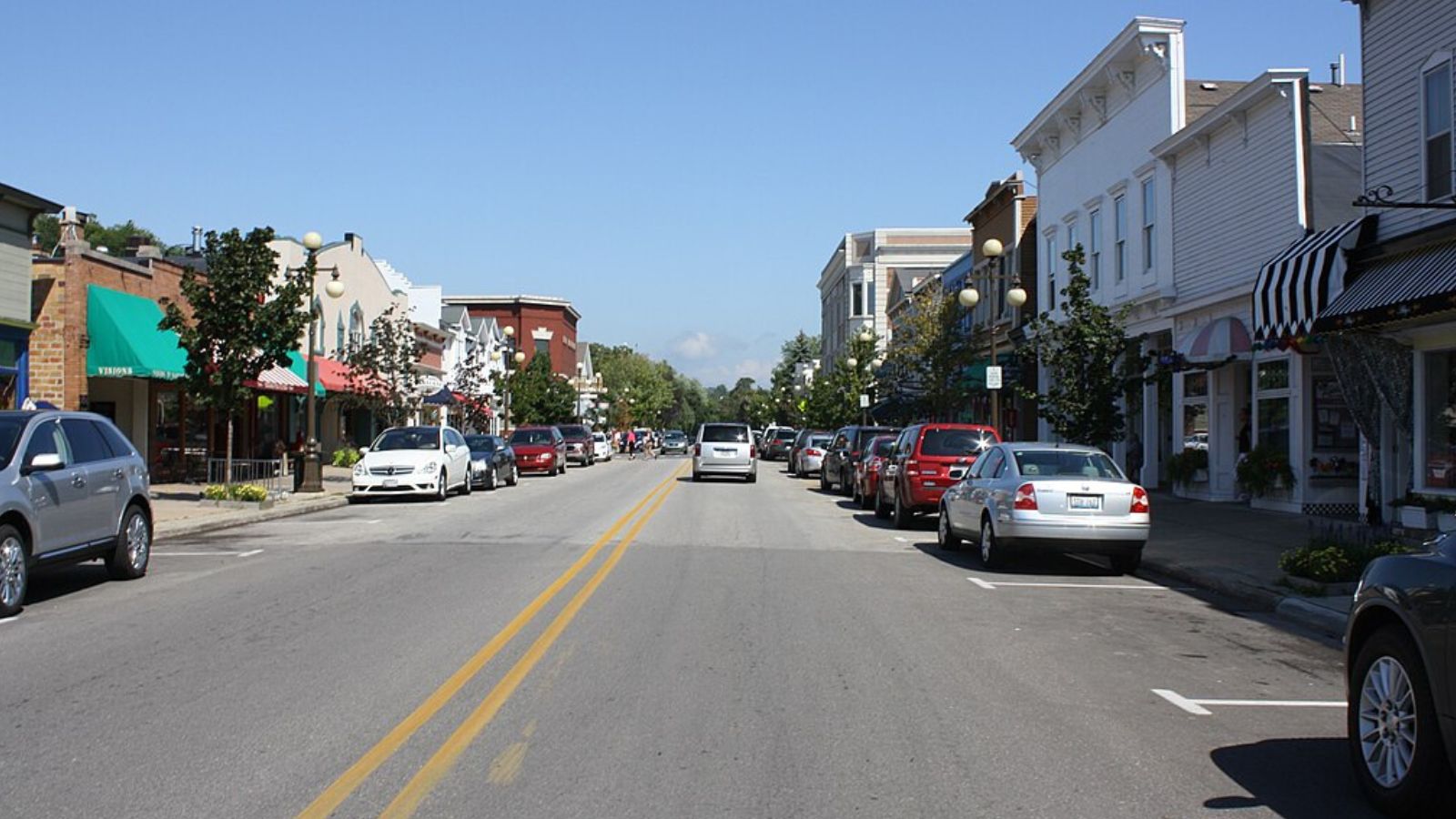
Why are people willing to pay so much to live here? What’s special about it?
Harbor Springs offers the quintessential northern Michigan experience with Victorian-era charm and modern resort amenities. The town sits on Little Traverse Bay with stunning water views, world-class golf courses, and proximity to some of Michigan’s best ski resorts including Boyne Highlands and Nub’s Nob. The historic downtown maintains its 19th-century character while offering upscale dining and shopping.
Buyers are attracted to the four-season recreation opportunities and the town’s reputation as a refined but unpretentious resort community. Harbor Springs avoids the overcrowding of some resort areas while still providing luxury amenities, making it appealing to affluent families seeking a sophisticated but relaxed northern retreat.
How Harbor Springs Rose to Prominence
Harbor Springs began as a Native American settlement and became a lumber town in the 1870s, taking advantage of its protected harbor on Little Traverse Bay. As the lumber industry declined, wealthy families from Chicago, Detroit, and other Midwest cities began building summer cottages here in the 1880s and 1890s. The construction of grand Victorian homes along the bluffs established the town’s reputation for elegance.
The development of nearby ski resorts in the mid-20th century transformed Harbor Springs from a summer-only destination to a year-round resort community. The combination of water activities, golf courses, and winter sports created a diversified recreation economy that has sustained the town’s high property values and exclusive reputation.
3 Interesting Tidbits
1. Hemingway Connection – Ernest Hemingway spent summers in the area as a young man and used northern Michigan as the setting for several of his Nick Adams stories, including parts set near Harbor Springs.
2. Historic Preservation – The town has one of Michigan’s largest collections of Victorian-era homes, many of which have been meticulously preserved and continue to serve as summer retreats for wealthy families.
3. Golf Legacy – Harbor Springs is home to several championship golf courses, including the Heather and Moor courses at Boyne Highlands, designed by some of the sport’s most renowned architects.
27. Huntington Woods – 118.2% Home Price Increase Since 2010
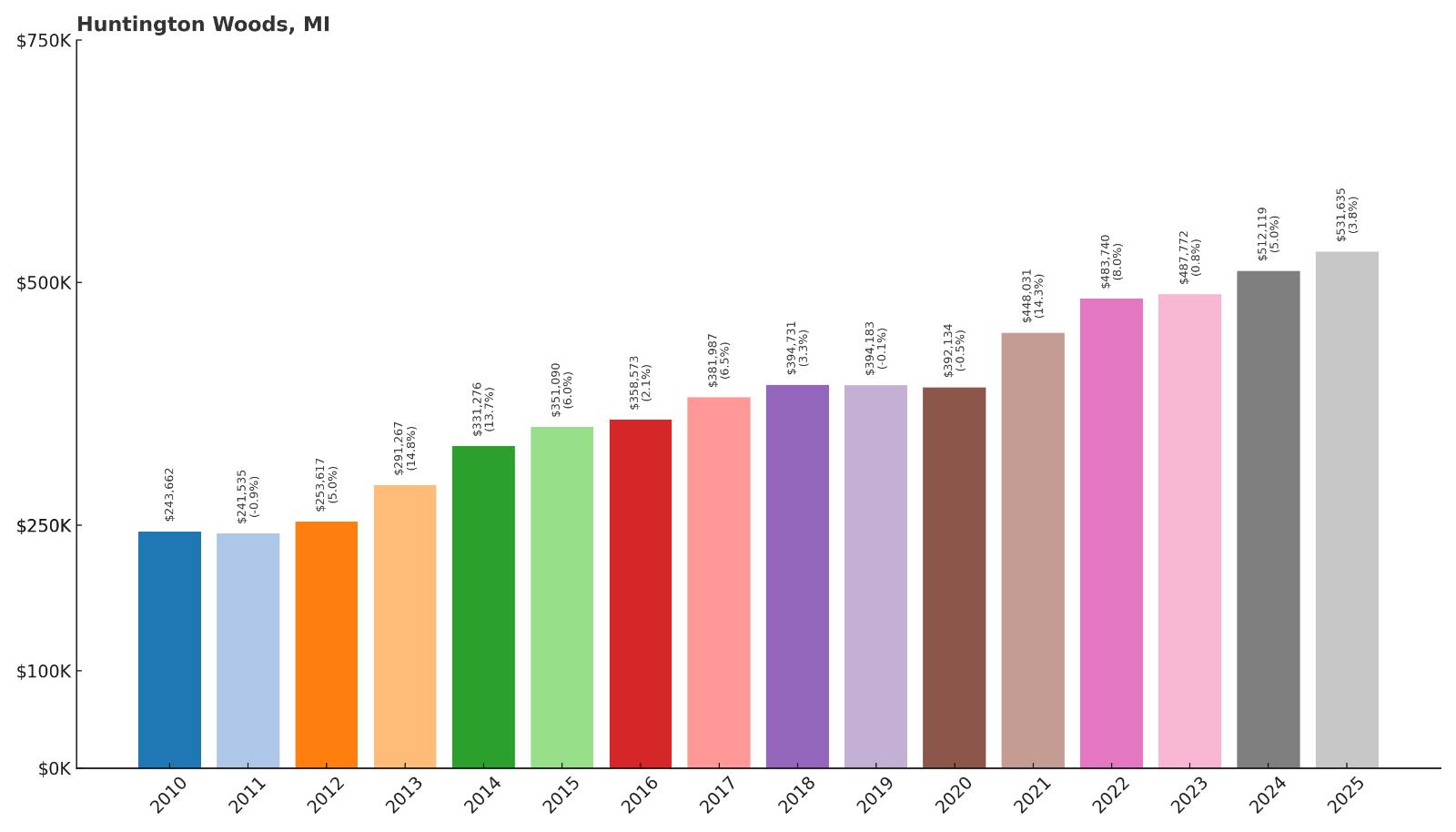
- 2010: $243,662
- 2011: $241,535
- 2012: $253,617
- 2013: $291,267
- 2014: $331,276
- 2015: $351,090
- 2016: $358,573
- 2017: $381,987
- 2018: $394,731
- 2019: $394,183
- 2020: $392,134
- 2021: $448,031
- 2022: $483,740
- 2023: $487,772
- 2024: $512,119
- 2025: $531,635
Huntington Woods shows consistent upward movement in home values, more than doubling since 2010. The city experienced particularly strong growth from 2013-2015 and again during the pandemic years. At $531,635, this Oakland County suburb reflects the premium buyers place on excellent schools, mature neighborhoods, and proximity to Detroit’s job centers.
Why Huntington Woods?
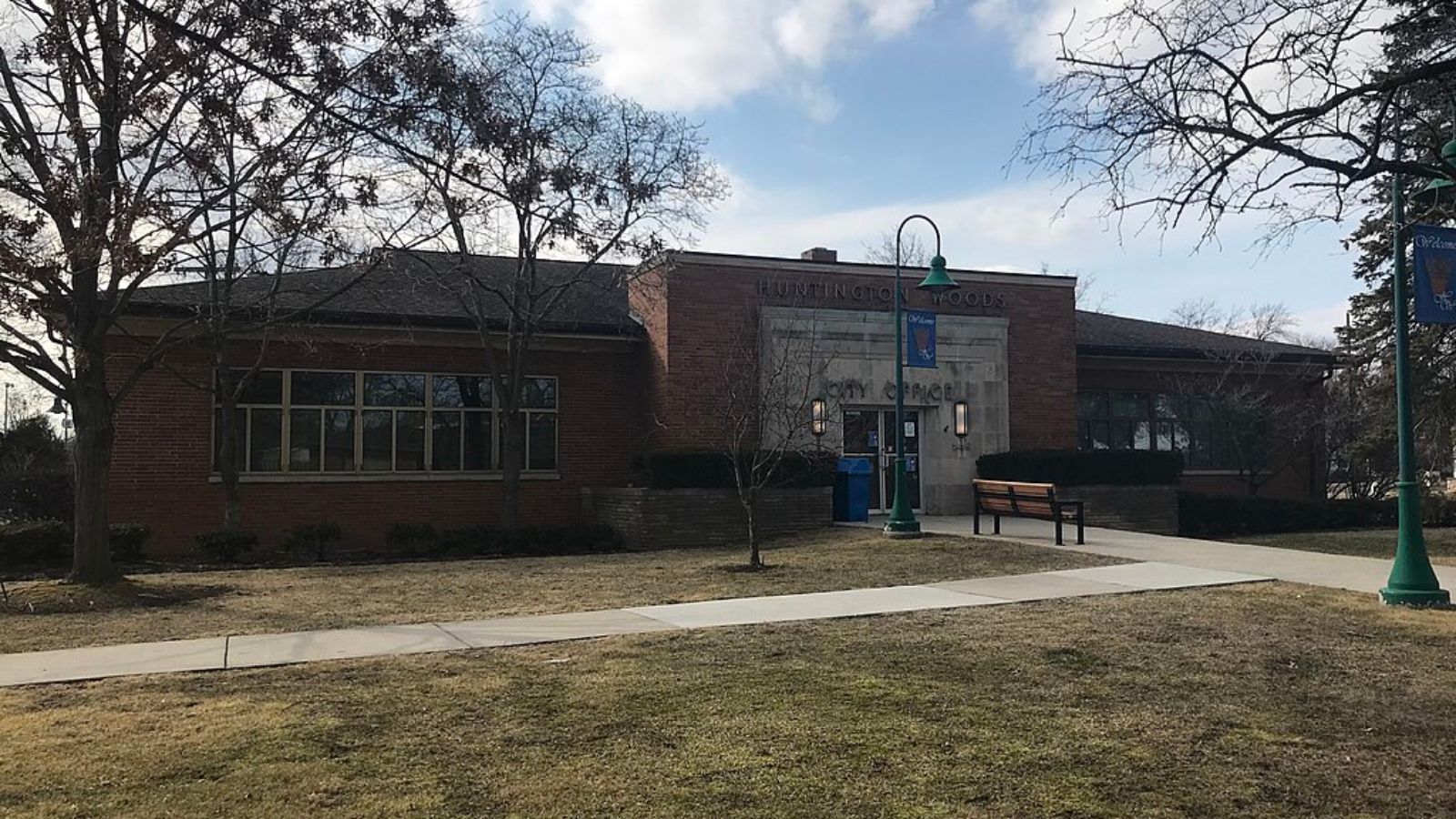
Why are people willing to pay so much to live here? What’s special about it?
Huntington Woods offers the rare combination of small-town character within a major metropolitan area. The city is known for its tree-lined streets, well-maintained homes, and strong sense of community, all while being just minutes from downtown Detroit and major employment centers. The school system consistently ranks among Oakland County’s best, making it particularly attractive to families.
The city maintains an active recreation program and numerous parks, creating a suburban lifestyle that feels more like a close-knit community than a typical subdivision. Low crime rates, stable city services, and proximity to shopping and cultural attractions in the broader Detroit area make it appealing to professionals who want suburban amenities without sacrificing urban conveniences.
How Huntington Woods Rose to Prominence
Huntington Woods was incorporated in 1926 as one of Oakland County’s early planned suburban communities. The city was developed with careful attention to creating a residential atmosphere, with curved streets and ample green space that differed from the grid pattern of many older cities. Post-World War II suburban growth brought many young families seeking new homes with modern amenities.
The city’s location between Detroit and the growing northern Oakland County suburbs positioned it perfectly to benefit from both downtown employment and suburban development. Investment in schools, parks, and city services helped maintain property values and attract residents who valued community involvement and municipal excellence.
3 Interesting Tidbits
1. Tree City Recognition – Huntington Woods has been designated a Tree City USA community for decades, reflecting its commitment to maintaining the urban forest that gives the city its distinctive character.
2. Tiny Territory – At just over one square mile, Huntington Woods is one of Oakland County’s smallest cities, contributing to its tight-knit community atmosphere.
3. Recreation Focus – The city operates one of the most comprehensive recreation programs in the region, with activities for all ages that help build the strong community bonds residents value.
26. Beverly Hills – 151.0% Home Price Increase Since 2010

- 2010: $226,853
- 2011: $229,038
- 2012: $250,330
- 2013: $294,359
- 2014: $330,008
- 2015: $335,624
- 2016: $348,825
- 2017: $372,538
- 2018: $393,618
- 2019: $404,254
- 2020: $411,506
- 2021: $470,908
- 2022: $518,815
- 2023: $520,462
- 2024: $546,409
- 2025: $569,359
Beverly Hills achieved remarkable growth of over 151% since 2010, with particularly strong increases during 2013-2014 and steady appreciation thereafter. Current median prices at $569,359 reflect this Oakland County community’s desirability among affluent suburban buyers. The consistent year-over-year growth demonstrates sustained demand in this upscale market.
Why Beverly Hills?
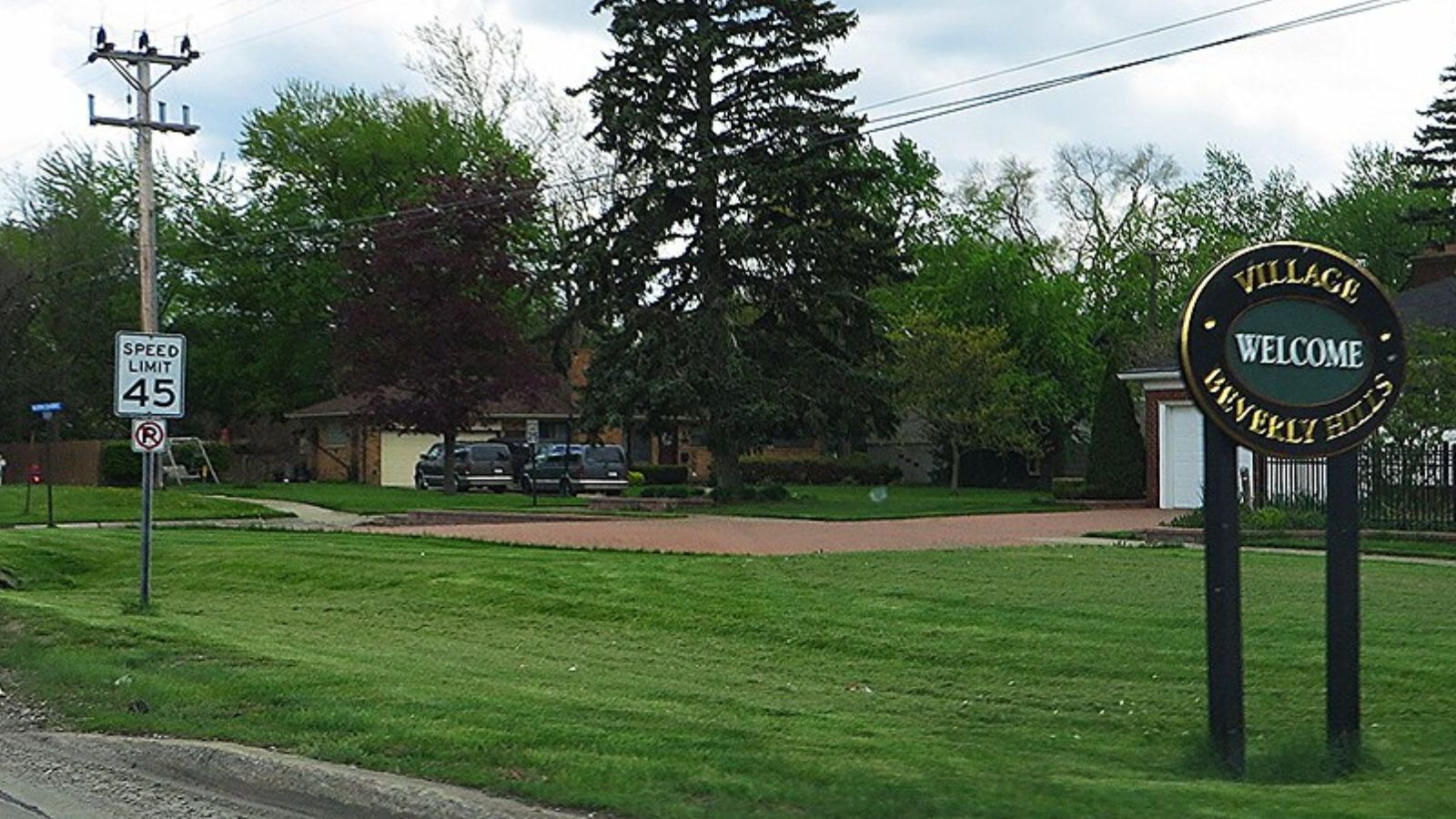
Why are people willing to pay so much to live here? What’s special about it?
Beverly Hills delivers the prestige and amenities its name suggests, with elegant homes, manicured neighborhoods, and proximity to Birmingham’s shopping and dining district. The village offers a small-town feel with big-city conveniences, including excellent schools and easy access to major employment centers. Residents enjoy tree-lined streets, well-maintained parks, and a strong sense of community pride.
The combination of location, school quality, and neighborhood character creates a lifestyle that appeals to successful professionals and business owners. Beverly Hills provides the security and status of an established, affluent community while maintaining the personal touches of a smaller municipality.
How Beverly Hills Rose to Prominence
Beverly Hills was incorporated as a village in 1958, carved out of what was previously part of Southfield Township. The community was developed as an upscale suburban destination, attracting residents who wanted newer homes with modern amenities in a prestigious location. The proximity to Birmingham’s established commercial district provided shopping and services without compromising the residential character.
Growth accelerated through the 1960s and 1970s as Detroit’s suburban expansion reached its peak. The village’s careful planning and commitment to maintaining high standards helped it avoid the decline that affected some nearby communities, instead establishing Beverly Hills as a stable, desirable address that continues to appreciate in value.
3 Interesting Tidbits
1. Village Character – Despite being surrounded by larger cities, Beverly Hills maintains its village government structure, allowing for more personalized municipal services and community involvement.
2. Park Preservation – The village has preserved significant green space, including Beverly Park, which serves as a community gathering place and recreational hub for residents of all ages.
3. School Excellence – Beverly Hills students attend Birmingham Public Schools, consistently ranked among Michigan’s top school districts, which significantly contributes to property values and family attraction to the area.
25. Northville – 120.6% Home Price Increase Since 2010
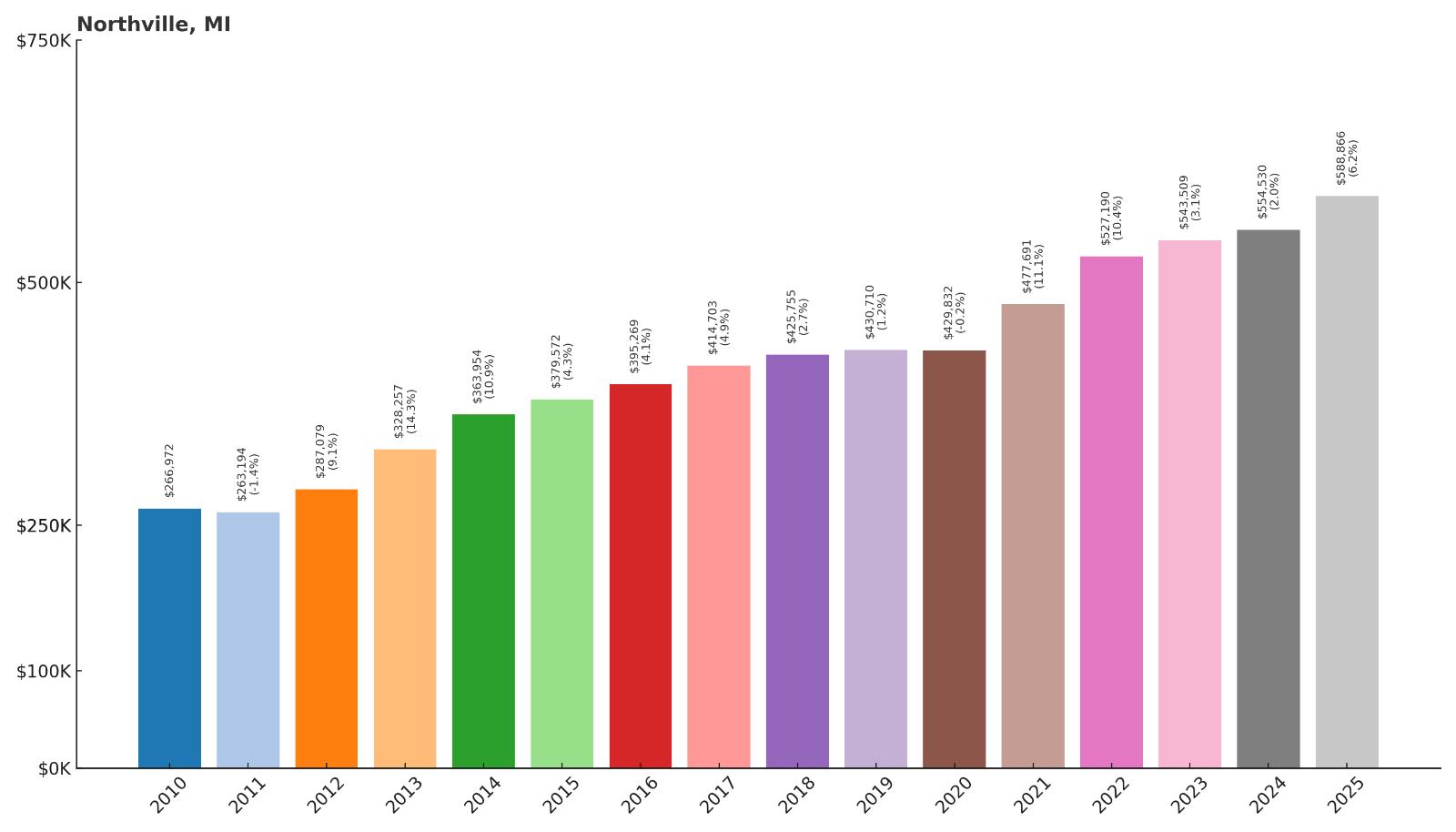
- 2010: $266,972
- 2011: $263,194
- 2012: $287,079
- 2013: $328,257
- 2014: $363,954
- 2015: $379,572
- 2016: $395,269
- 2017: $414,703
- 2018: $425,755
- 2019: $430,710
- 2020: $429,832
- 2021: $477,691
- 2022: $527,190
- 2023: $543,509
- 2024: $554,530
- 2025: $588,866
Northville demonstrated steady value appreciation throughout the period, starting from a higher base of nearly $267,000 in 2010. The community experienced particularly strong growth from 2012-2015 and again during the pandemic years. At $588,866, Northville reflects the premium placed on historic charm combined with modern suburban amenities.
Why Northville?
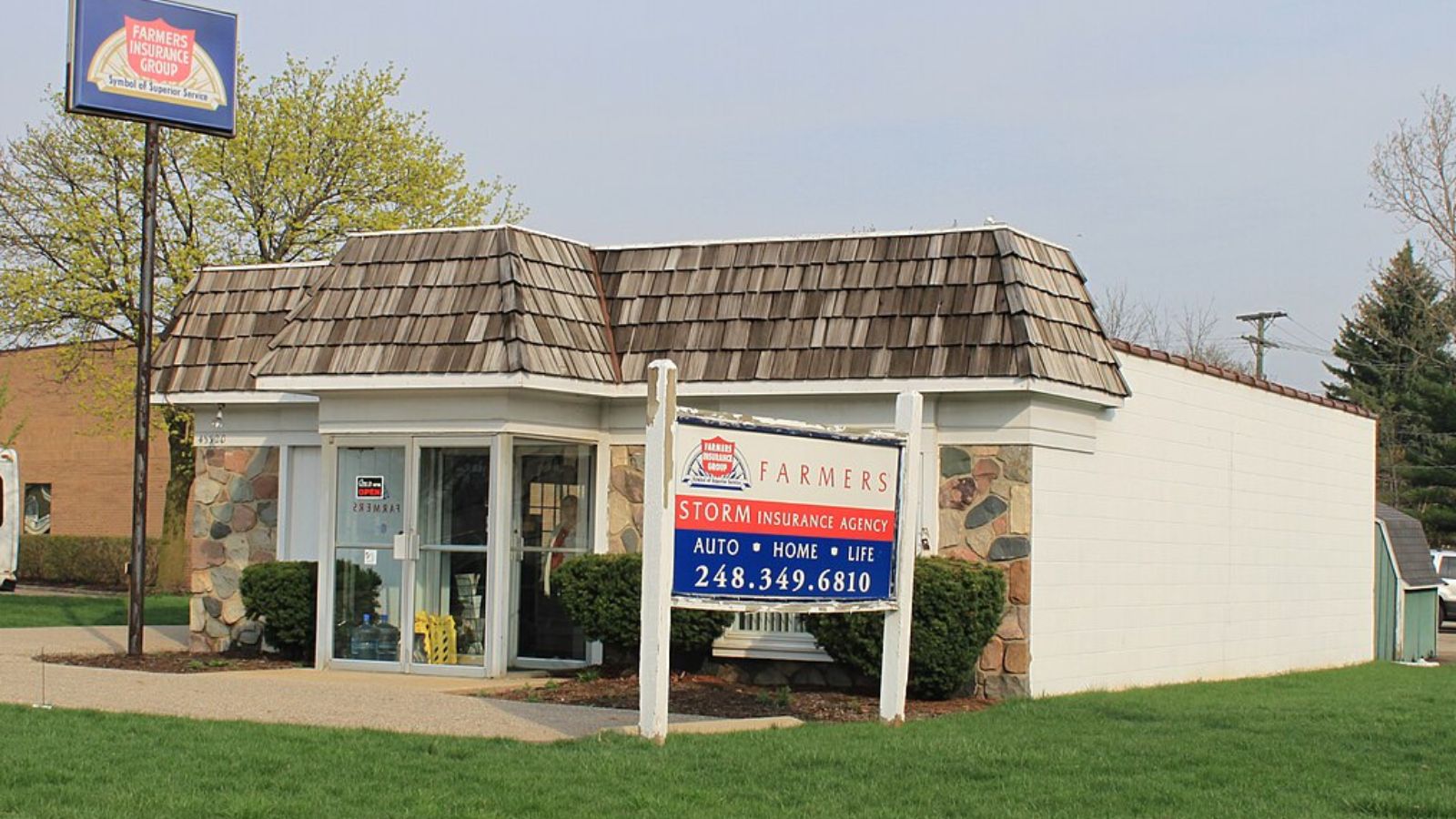
Why are people willing to pay so much to live here? What’s special about it?
Northville seamlessly blends historic small-town charm with modern suburban convenience, featuring a walkable downtown filled with unique shops, restaurants, and community events. The city offers excellent schools, abundant parks, and the scenic Mill Race Village historic area that provides a connection to Michigan’s past. Residents enjoy easy access to both Detroit employment opportunities and the recreational activities of nearby Maybury State Park.
The combination of character, convenience, and community makes Northville particularly appealing to families and professionals who want more than just another suburban subdivision. The city’s commitment to preserving its historic downtown while supporting quality development throughout creates a distinctive identity that commands premium prices.
How Northville Rose to Prominence
Northville was founded in 1825 and grew as a mill town along the Middle Rouge River, with the dam and millpond becoming central features that remain today. The arrival of the Detroit, Lansing & Northern Railroad in 1871 connected the community to broader markets and brought new residents. The town’s location between Detroit and Lansing made it an important stop for travelers and commerce.
In the 20th century, Northville evolved from a rural community to a sought-after suburb while preserving its historic core. The development of the automotive industry brought prosperity to the region, and Northville’s strategic location and commitment to maintaining its character attracted residents seeking a balance between urban access and small-town living.
3 Interesting Tidbits
1. Mill Race Legacy – The historic Mill Race Village preserves several 19th-century buildings that were moved to create a living history museum showcasing life in early Michigan.
2. Victorian Festival – The annual Victorian Festival transforms downtown into a 19th-century celebration, drawing thousands of visitors and reflecting the community’s commitment to its historic identity.
3. Ford Connection – The area was home to a Ford valve plant for decades, and the redevelopment of that site into mixed-use development represents Northville’s successful transition from manufacturing to a diverse economy.
24. Bingham Farms – 110.5% Home Price Increase Since 2010
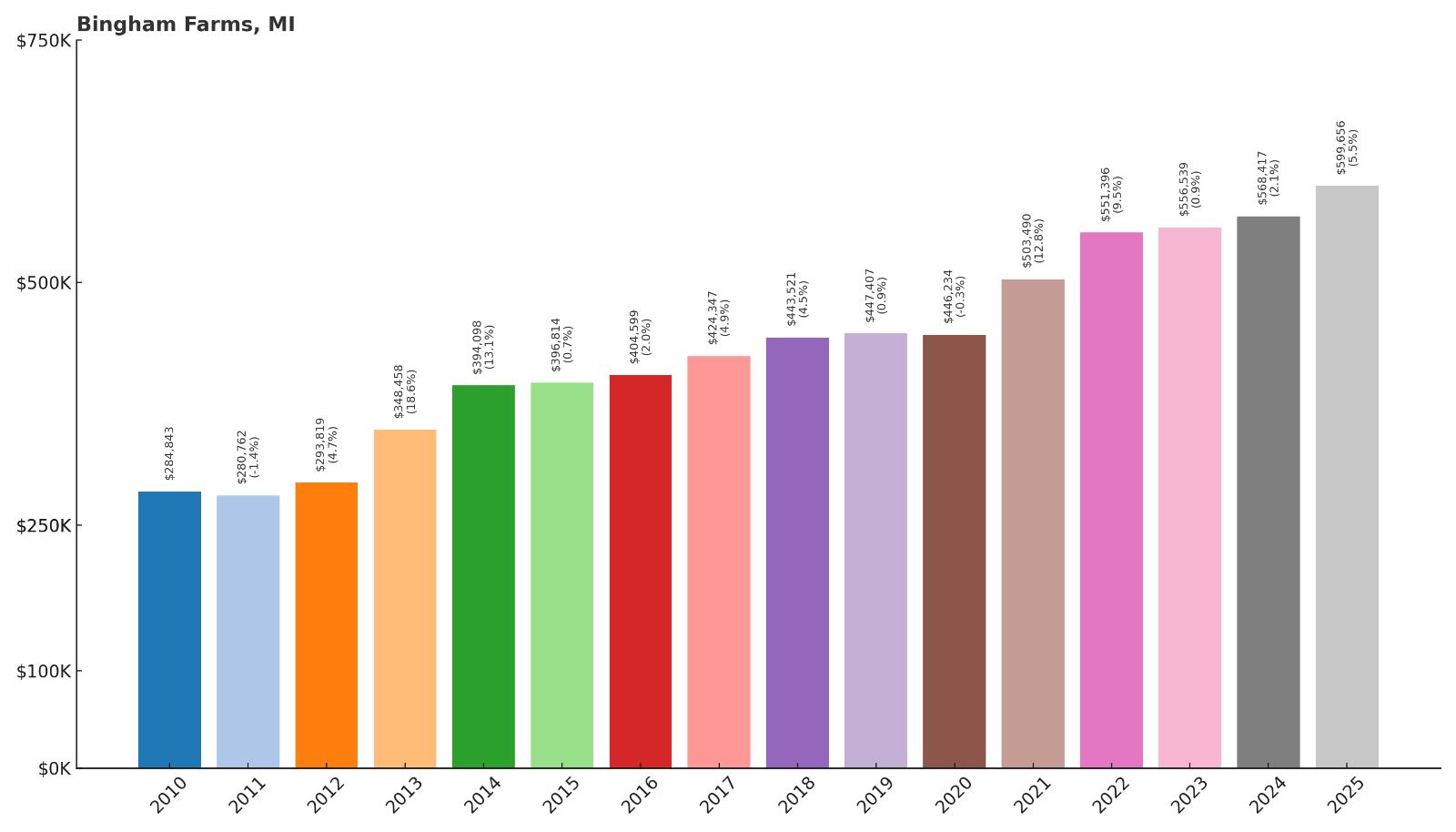
- 2010: $284,843
- 2011: $280,762
- 2012: $293,819
- 2013: $348,458
- 2014: $394,098
- 2015: $396,814
- 2016: $404,599
- 2017: $424,347
- 2018: $443,521
- 2019: $447,407
- 2020: $446,234
- 2021: $503,490
- 2022: $551,396
- 2023: $556,539
- 2024: $568,417
- 2025: $599,656
Bingham Farms started the period at a relatively high $284,843 and more than doubled by 2025. The village experienced significant growth from 2012-2014 and steady appreciation since. Current values at nearly $600,000 reflect the premium for this small, exclusive Oakland County community that offers rural character within a metropolitan setting.
Why Bingham Farms?

Why are people willing to pay so much to live here? What’s special about it?
Bingham Farms offers the unique combination of rural character and suburban convenience in one of Oakland County’s most exclusive small communities. The village maintains large lot sizes, mature trees, and a country-like atmosphere while being just minutes from major employment centers and shopping districts. Residents enjoy privacy and tranquility that’s increasingly rare in the metropolitan Detroit area.
The community’s small size creates an intimate atmosphere where neighbors know each other and civic involvement is common. Bingham Farms attracts successful professionals and executives who value discretion, natural beauty, and the prestige that comes with living in one of the area’s most selective residential communities.
How Bingham Farms Rose to Prominence
Bingham Farms was incorporated in 1955 from rural farmland in Oakland County, designed from the beginning as an exclusive residential community. The village was planned to preserve the area’s natural character while providing upscale housing for Detroit’s growing professional class. Large minimum lot sizes and strict zoning maintained the rural feel that original residents sought.
As suburban development spread throughout Oakland County, Bingham Farms’ commitment to preserving green space and limiting density made it increasingly valuable. The village’s location near major commercial corridors like Telegraph Road provided convenient access to employment and shopping while maintaining its distinct character.
3 Interesting Tidbits
1. Exclusive Size – At less than three square miles, Bingham Farms is one of Oakland County’s smallest incorporated communities, with just over 1,100 residents.
2. Green Preservation – The village has maintained extensive green space and large lot requirements that preserve its rural character despite being surrounded by more densely developed areas.
3. Corporate Neighbors – Several major corporate headquarters are located nearby, making Bingham Farms attractive to executives who want minimal commute times to prestigious employment centers.
23. Saugatuck – 145.5% Home Price Increase Since 2010
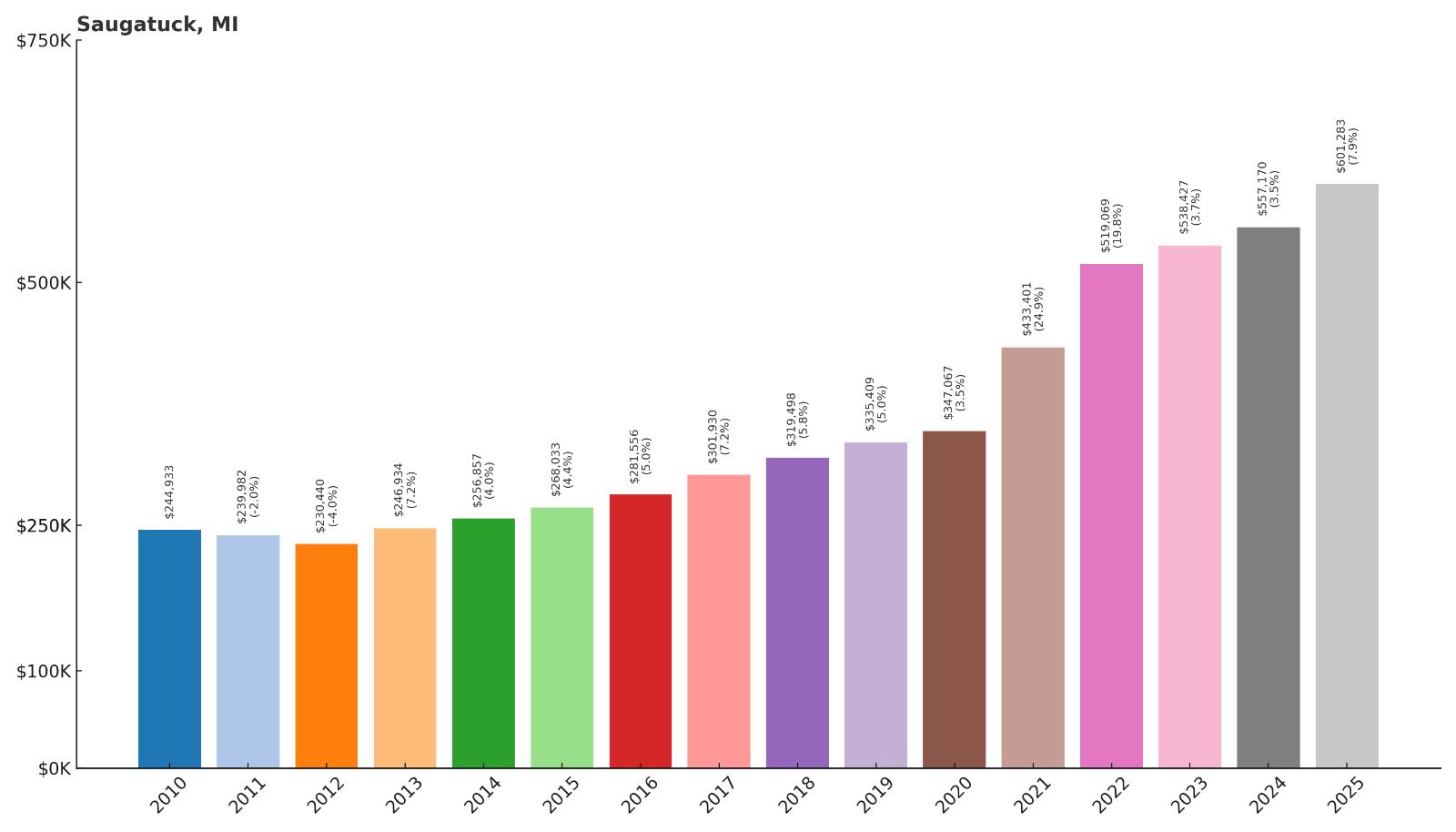
- 2010: $244,933
- 2011: $239,982
- 2012: $230,440
- 2013: $246,934
- 2014: $256,857
- 2015: $268,033
- 2016: $281,556
- 2017: $301,930
- 2018: $319,498
- 2019: $335,409
- 2020: $347,067
- 2021: $433,401
- 2022: $519,069
- 2023: $538,427
- 2024: $557,170
- 2025: $601,283
Saugatuck experienced a remarkable transformation, with values rising from around $245,000 to over $601,000. The town saw steady growth through 2020, followed by explosive increases during the pandemic years. This Lake Michigan resort community has clearly benefited from the trend toward scenic, recreation-focused destinations that offer both natural beauty and cultural amenities.
Why Saugatuck?
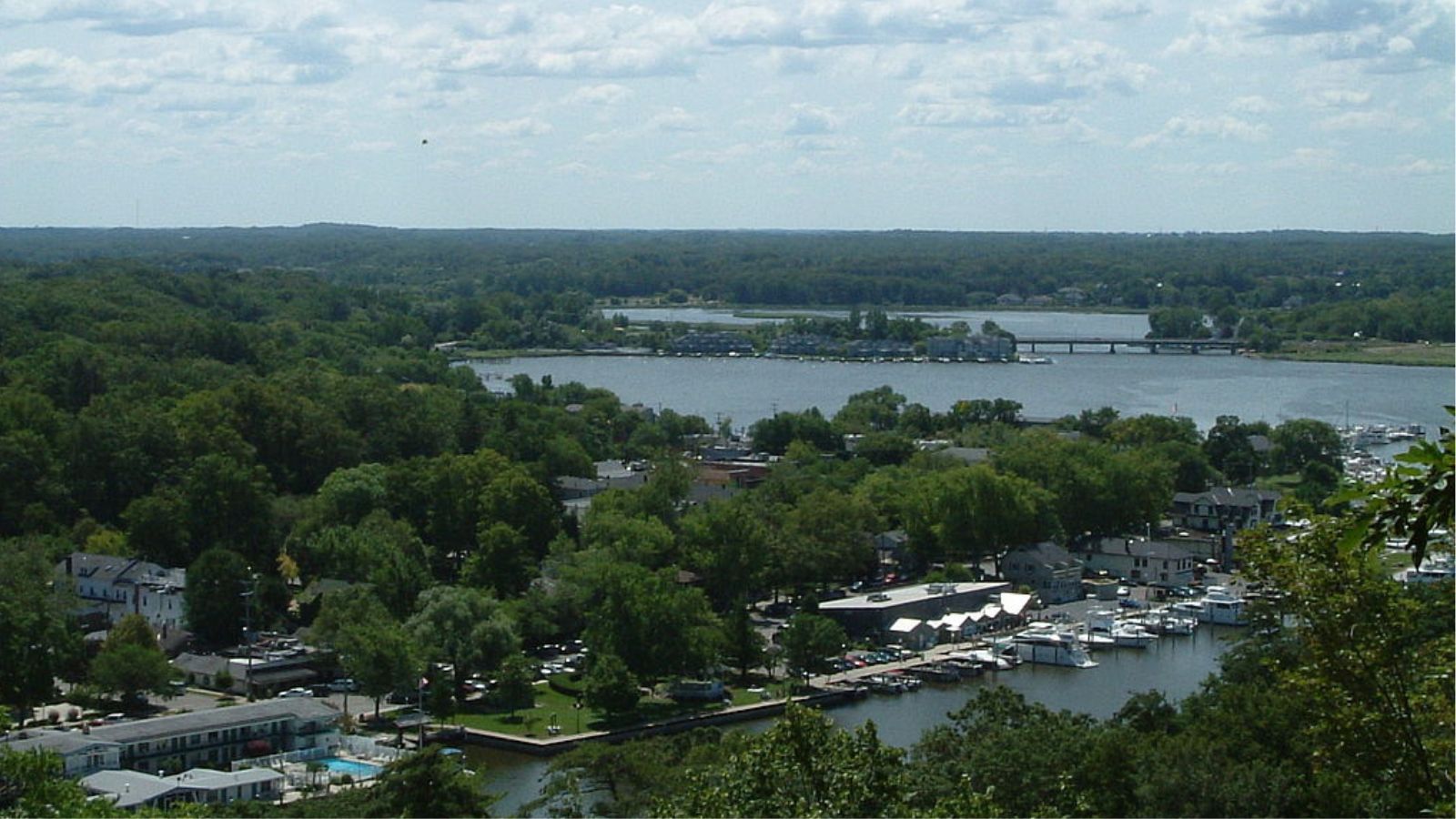
Why are people willing to pay so much to live here? What’s special about it?
Saugatuck combines stunning Lake Michigan beaches with a thriving arts scene and distinctive Victorian architecture that creates one of Michigan’s most desirable resort communities. The town offers world-class galleries, unique boutique shopping, and restaurants that rival major cities, all within walking distance of beautiful sandy beaches and scenic harbor areas. The combination of natural beauty and cultural sophistication is rare in smaller communities.
Buyers are attracted to Saugatuck’s year-round appeal, from summer beach activities to fall color tours and cozy winter retreats. The town’s long-standing reputation as an artists’ colony and LGBTQ-friendly destination creates a welcoming, creative atmosphere that appeals to diverse buyers seeking an authentic, vibrant community experience.
How Saugatuck Rose to Prominence
Saugatuck began as a lumber town in the 1860s, taking advantage of its deep harbor on Lake Michigan and the Kalamazoo River. As the timber industry declined, the town reinvented itself as an artists’ colony in the early 1900s, when the Chicago Art Institute established a summer school here. This artistic foundation attracted creative individuals and eventually evolved into a thriving gallery district.
The town’s transformation into a premier resort destination accelerated in the mid-20th century as visitors discovered its unique combination of natural beauty, artistic culture, and welcoming atmosphere. The development of the Saugatuck Dunes State Park and careful preservation of the historic downtown helped establish Saugatuck as one of Michigan’s most distinctive coastal communities.
3 Interesting Tidbits
1. Chain Ferry Legacy – Saugatuck operates one of the last hand-cranked chain ferries in the United States, connecting the town to its beaches across the Kalamazoo River since 1838.
2. Art Colony History – The town has been attracting artists for over a century, with the original Art Institute of Chicago summer program helping establish its reputation as a creative haven.
3. Dune Climbing – Mount Baldhead, accessible from downtown Saugatuck, offers panoramic views of Lake Michigan and has been a popular climbing destination for visitors since the early 1900s.
22. Maple City – 154.9% Home Price Increase Since 2010

- 2010: $242,033
- 2011: $263,488
- 2012: $272,995
- 2013: $281,393
- 2014: $294,242
- 2015: $311,002
- 2016: $303,370
- 2017: $349,702
- 2018: $373,314
- 2019: $370,422
- 2020: $388,009
- 2021: $485,065
- 2022: $572,165
- 2023: $591,538
- 2024: $608,014
- 2025: $616,933
Maple City achieved the second-highest growth rate on this list, with values increasing nearly 155% since 2010. The community experienced steady growth through 2020, then dramatic increases during the pandemic years that pushed median prices above $616,000. This northern Michigan community has clearly benefited from the surge in demand for scenic, rural properties with recreational access.
Why Maple City?
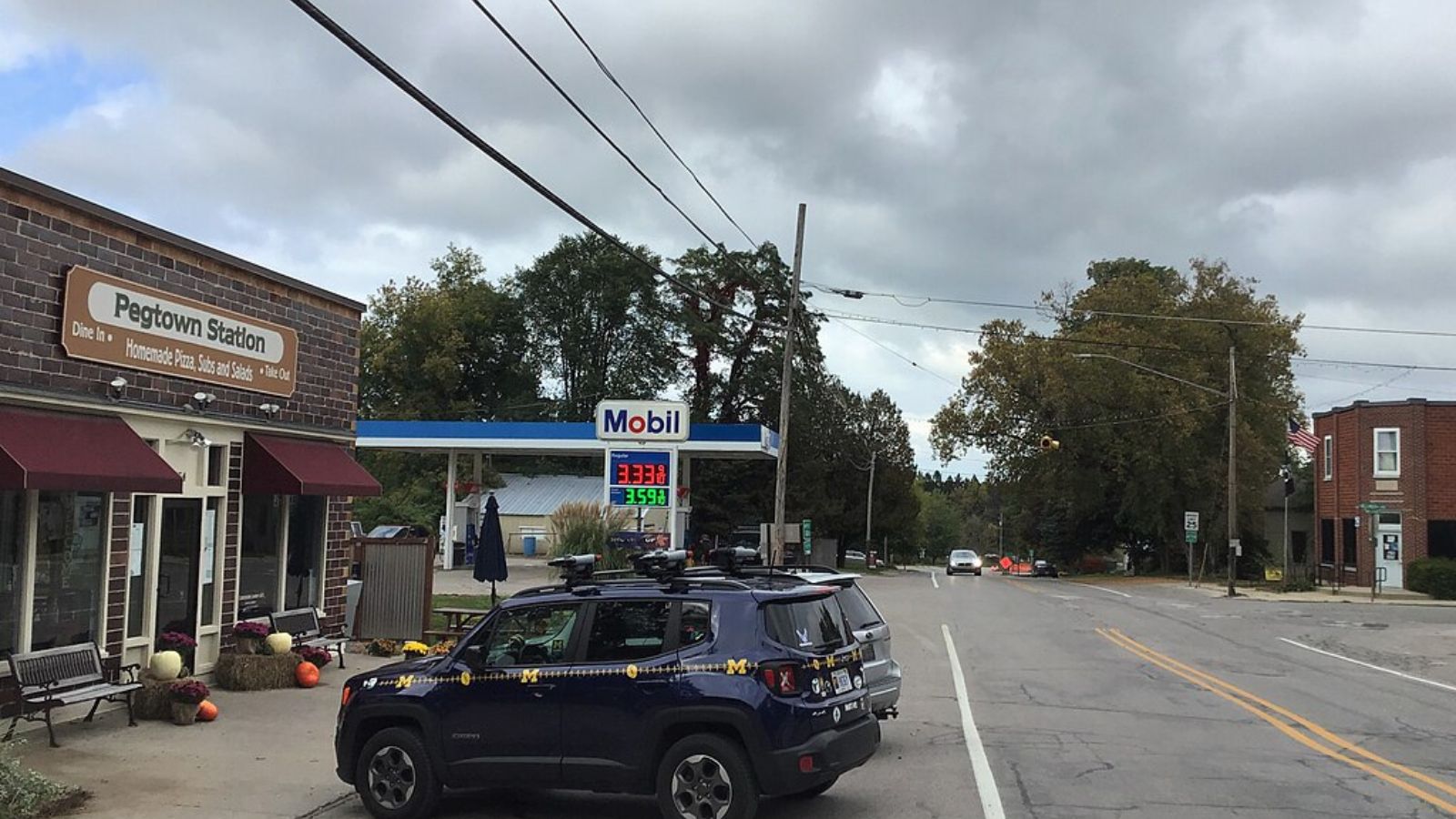
Why are people willing to pay so much to live here? What’s special about it?
Maple City offers the perfect blend of rural tranquility and proximity to northern Michigan’s most sought-after destinations including Sleeping Bear Dunes and Lake Michigan beaches. The community provides a peaceful, wooded setting with larger properties and newer construction that appeals to buyers seeking privacy and natural beauty. Easy access to Traverse City’s amenities and employment opportunities adds practical appeal to the scenic location.
Buyers are drawn to the four-season recreational opportunities, from hiking and lake activities in summer to skiing and winter sports nearby. The area’s growing reputation as a year-round destination, rather than just a summer retreat, has increased demand among both permanent residents and second-home buyers seeking a premium northern Michigan experience.
How Maple City Rose to Prominence
Maple City began as a logging community in the late 1800s, taking advantage of the area’s dense forests and access to transportation routes. The town was named for the abundant maple trees that provided both lumber and maple syrup production. As the lumber industry declined, the community remained small and rural for decades.
The transformation began in the 1970s with the establishment of Sleeping Bear Dunes National Lakeshore, which brought increased tourism and attention to the broader Leelanau Peninsula. Maple City’s location between the national lakeshore and growing Traverse City made it attractive for development, while its rural character appealed to buyers seeking larger properties and privacy.
3 Interesting Tidbits
1. Syrup Heritage – The town’s name reflects its original economy based on maple syrup production, and several local producers still tap maple trees each spring to continue this sweet tradition.
2. Dunes Gateway – Maple City serves as a gateway community to Sleeping Bear Dunes National Lakeshore, making it a strategic location for outdoor enthusiasts and nature lovers.
3. Wine Country Connection – The area has become part of northern Michigan’s emerging wine region, with several vineyards and tasting rooms taking advantage of the favorable microclimate near Lake Michigan.
21. Glen Arbor – 77.9% Home Price Increase Since 2010
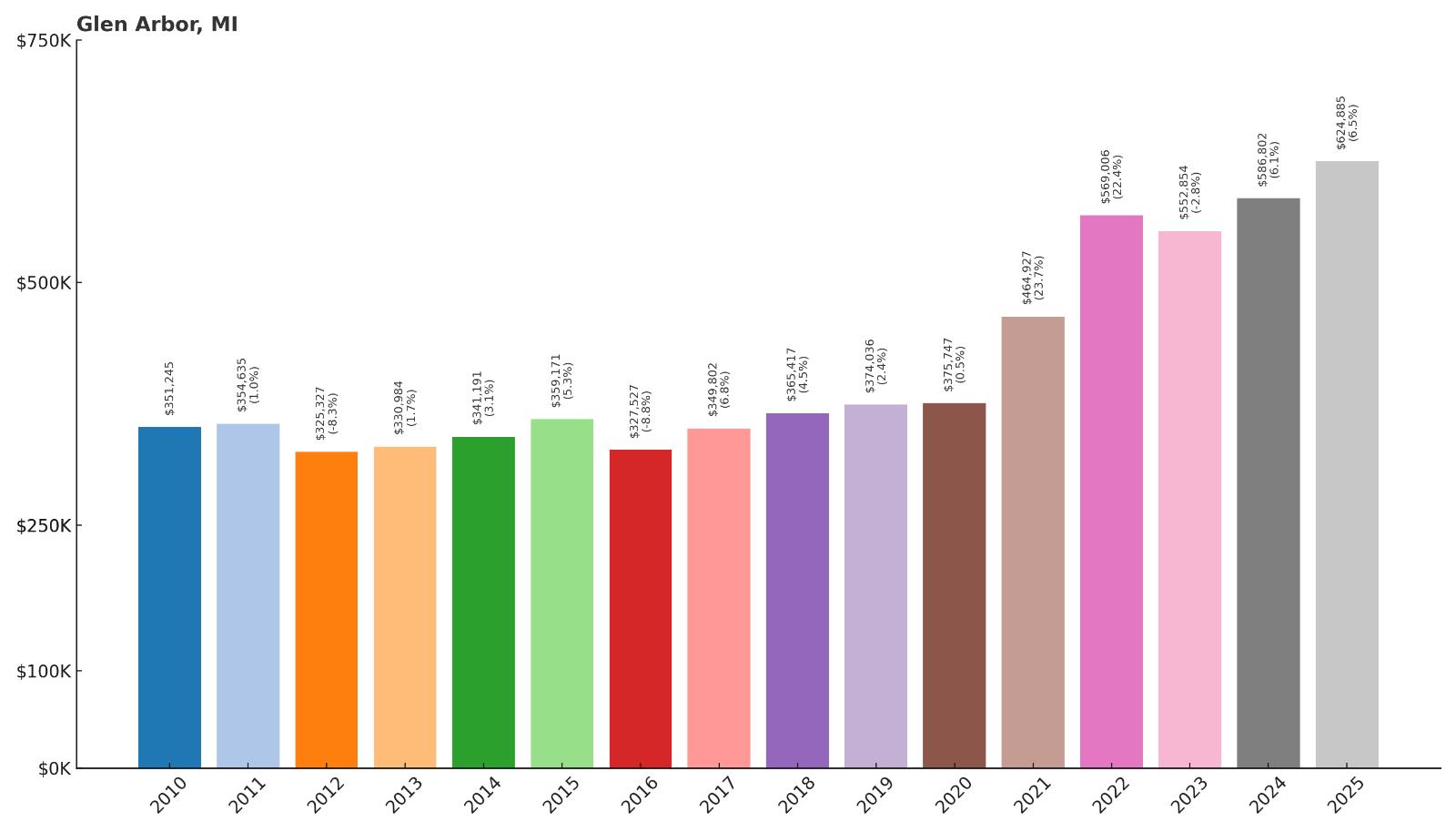
- 2010: $351,245
- 2011: $354,635
- 2012: $325,327
- 2013: $330,984
- 2014: $341,191
- 2015: $359,171
- 2016: $327,527
- 2017: $349,802
- 2018: $365,417
- 2019: $374,036
- 2020: $375,747
- 2021: $464,927
- 2022: $569,006
- 2023: $552,854
- 2024: $586,802
- 2025: $624,885
Glen Arbor started from the highest base price among towns with lower growth rates, beginning at over $351,000 in 2010. Despite some volatility in the mid-2010s, values surged during the pandemic and now exceed $624,000. This community’s position within Sleeping Bear Dunes National Lakeshore creates inherent scarcity that supports high values even with more modest percentage growth.
Why Glen Arbor?
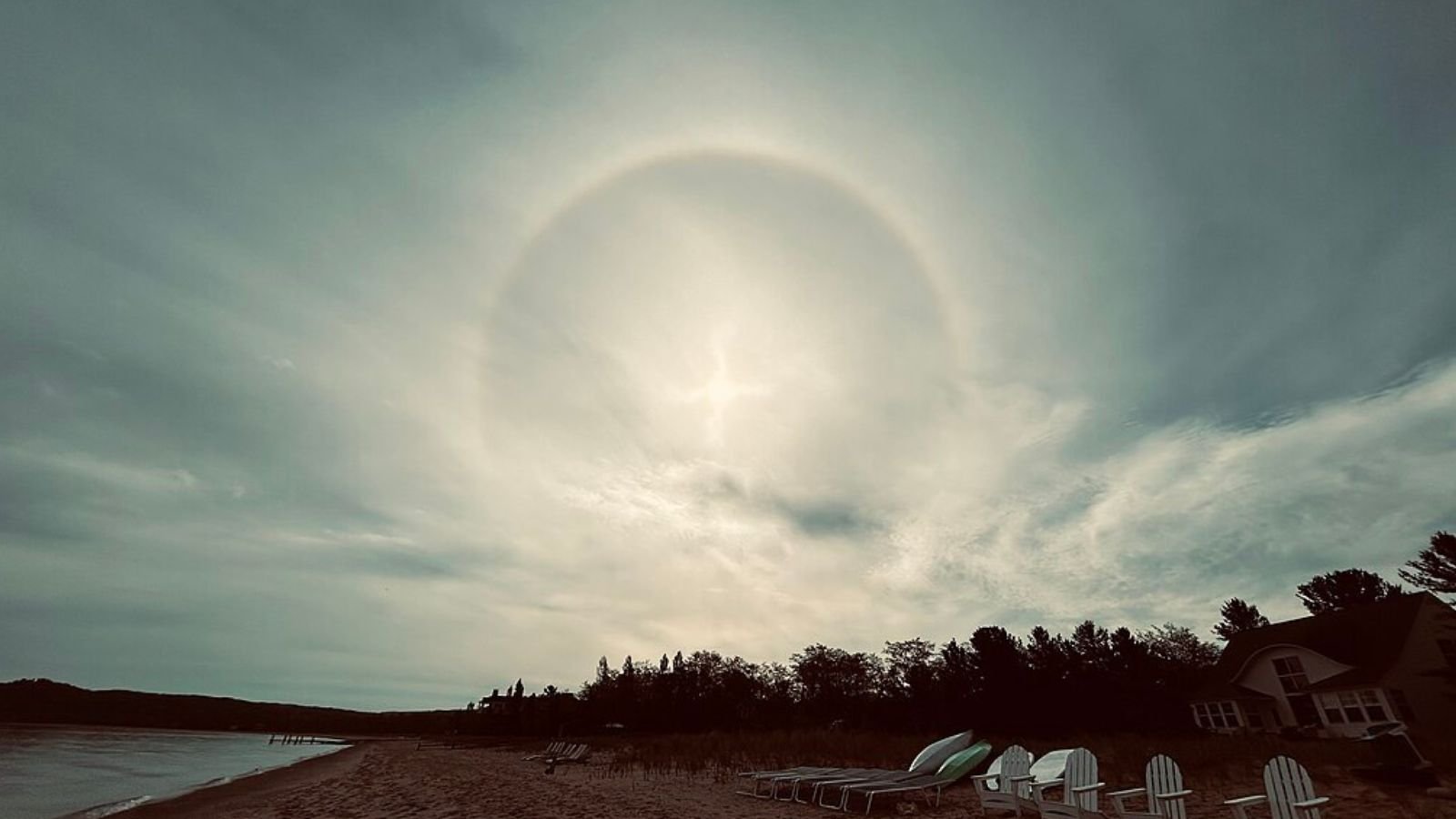
Why are people willing to pay so much to live here? What’s special about it?
Glen Arbor sits at the heart of Sleeping Bear Dunes National Lakeshore, offering residents unparalleled access to some of Michigan’s most spectacular natural scenery. The town provides a rare combination of protected wilderness areas, pristine Lake Michigan beaches, and a charming village atmosphere with quality dining and shopping. The location offers both seclusion and sophistication that appeals to affluent buyers seeking an authentic northern Michigan experience.
The community benefits from strict development limitations due to its national lakeshore location, creating scarcity that supports property values. Buyers appreciate the assurance that the natural character will be preserved, making Glen Arbor an attractive long-term investment for those who can afford the premium for protected lakefront living.
How Glen Arbor Rose to Prominence
Glen Arbor was established in the 1850s as a lumber town and later became a resort destination for wealthy families from Chicago and Detroit. The town’s location along scenic Glen Lake and near Lake Michigan beaches made it a natural choice for summer cottages and resorts. The completion of the railroad connections in the late 1800s made the area more accessible to visitors.
The designation of Sleeping Bear Dunes National Lakeshore in 1970 fundamentally changed Glen Arbor’s character and real estate dynamics. While limiting development, the federal protection increased the area’s profile and ensured that existing properties would maintain their scenic value, creating a unique market where scarcity drives premium pricing.
3 Interesting Tidbits
1. National Lakeshore Heart – Glen Arbor is the only incorporated community completely within Sleeping Bear Dunes National Lakeshore boundaries, making it truly unique among Michigan resort towns.
2. Dune Climb Fame – The famous Dune Climb, one of Michigan’s most popular tourist attractions, is located just outside town and draws hundreds of thousands of visitors annually.
3. Literary Legacy – The area has inspired numerous writers and artists, including being featured in several novels and serving as the setting for Michigan-themed literature celebrating the state’s natural beauty.
20. Ada – 5.8% Home Price Increase Since 2024
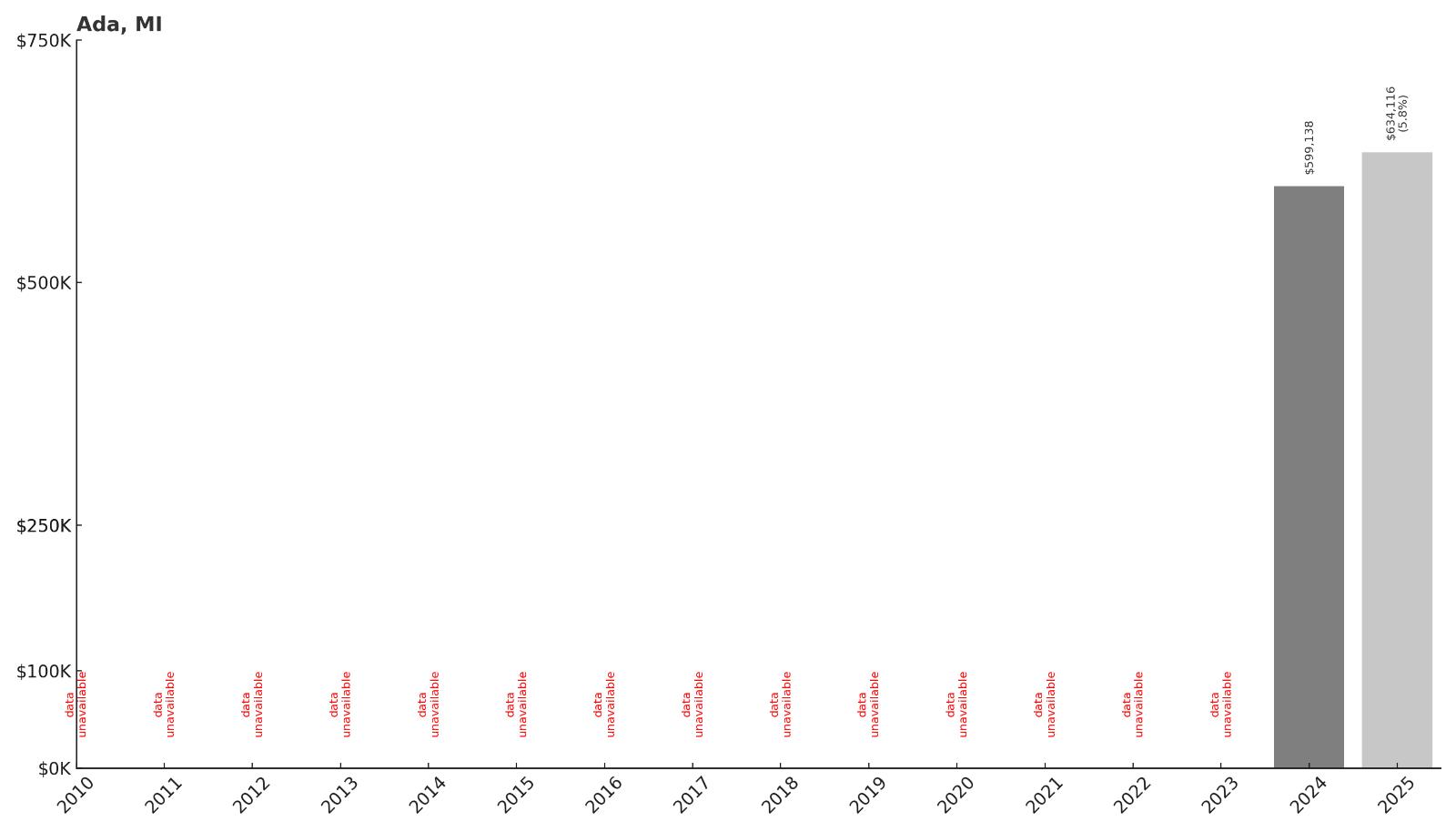
- 2010: N/A
- 2011: N/A
- 2012: N/A
- 2013: N/A
- 2014: N/A
- 2015: N/A
- 2016: N/A
- 2017: N/A
- 2018: N/A
- 2019: N/A
- 2020: N/A
- 2021: N/A
- 2022: N/A
- 2023: N/A
- 2024: $599,138
- 2025: $634,116
Ada shows limited data history but demonstrates continued growth with a 5.8% increase from 2024 to 2025. Starting from a high base of nearly $600,000, the community has maintained strong values that reflect its position as one of western Michigan’s most desirable suburbs. The lack of historical data suggests this area may have been recently incorporated or previously too small for separate tracking.
Why Ada?
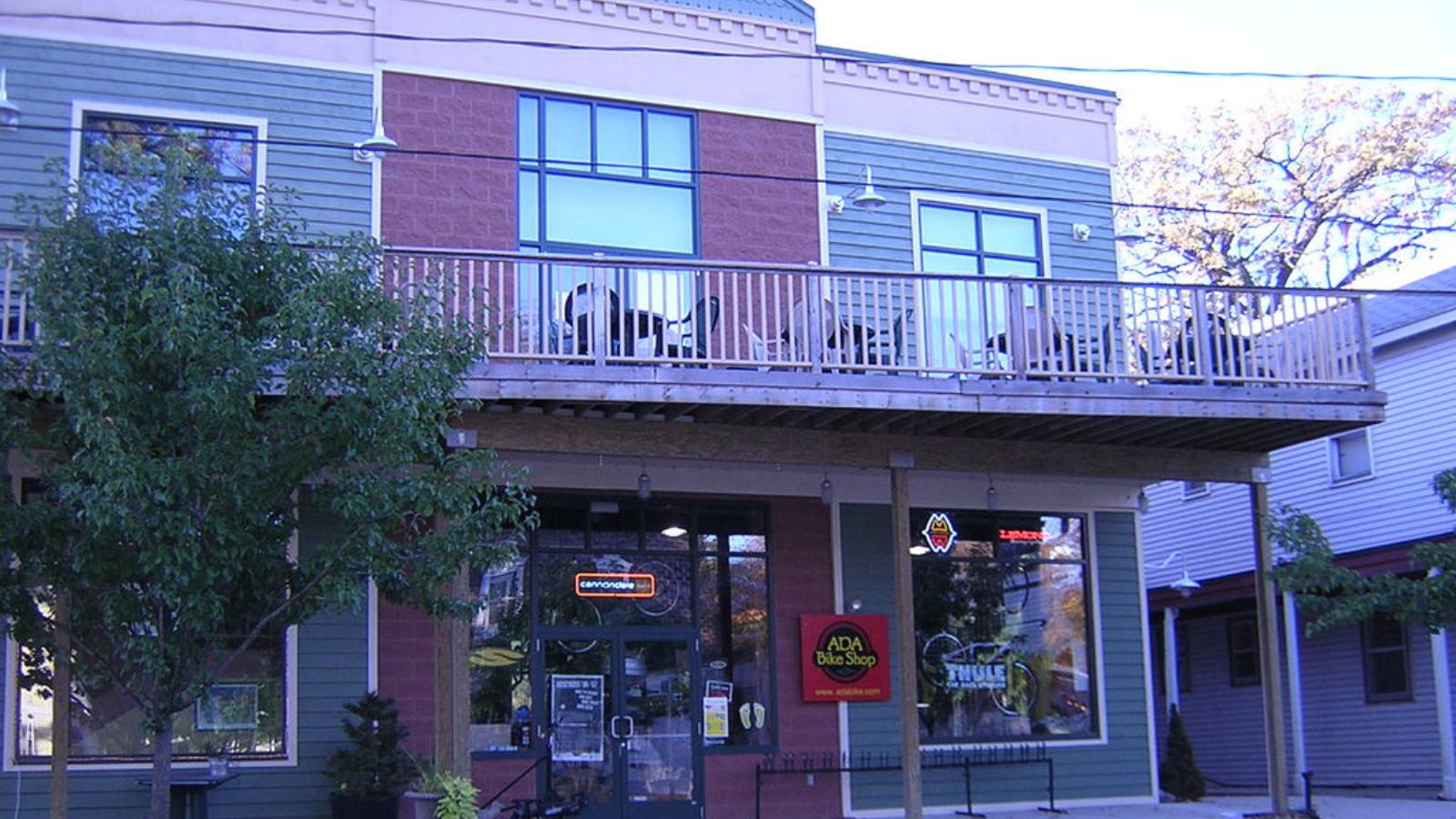
Why are people willing to pay so much to live here? What’s special about it?
Ada represents the pinnacle of Grand Rapids suburban living, offering expansive homes on large lots with easy access to the region’s employment centers. The community features rolling hills, mature trees, and newer construction that appeals to executives and professionals seeking luxury suburban living. Excellent schools and low crime rates make it particularly attractive to families willing to pay premium prices for quality and safety.
The town’s location along the Thornapple River provides scenic beauty and recreational opportunities while maintaining convenient access to Grand Rapids’ business district. Ada’s careful growth and high development standards have created a prestigious address that continues to attract affluent buyers throughout western Michigan.
How Ada Rose to Prominence
Ada Township was first settled in the 1830s but remained largely rural until the late 20th century when Grand Rapids’ economic expansion created demand for upscale suburban communities. The area’s natural beauty, including the Thornapple River valley and rolling terrain, made it attractive for higher-end residential development. Careful planning and zoning helped preserve the area’s character while accommodating growth.
The community’s development accelerated in the 1980s and 1990s as medical device companies, furniture manufacturers, and other industries brought high-paying jobs to the Grand Rapids area. Ada’s combination of scenic beauty, large lot sizes, and proximity to employment centers made it the natural choice for successful professionals seeking luxury suburban living.
3 Interesting Tidbits
1. River Recreation – The Thornapple River provides excellent canoeing and kayaking opportunities, with several access points throughout the community that residents use for recreation and relaxation.
2. Corporate Campus – Ada is home to Amway’s world headquarters, one of the largest corporate campuses in western Michigan, which has influenced the area’s upscale development.
3. Historic Preservation – Despite rapid growth, the community has preserved several historic sites including the Ada Covered Bridge, maintaining connections to its rural heritage.
19. Oakland – 120.4% Home Price Increase Since 2010
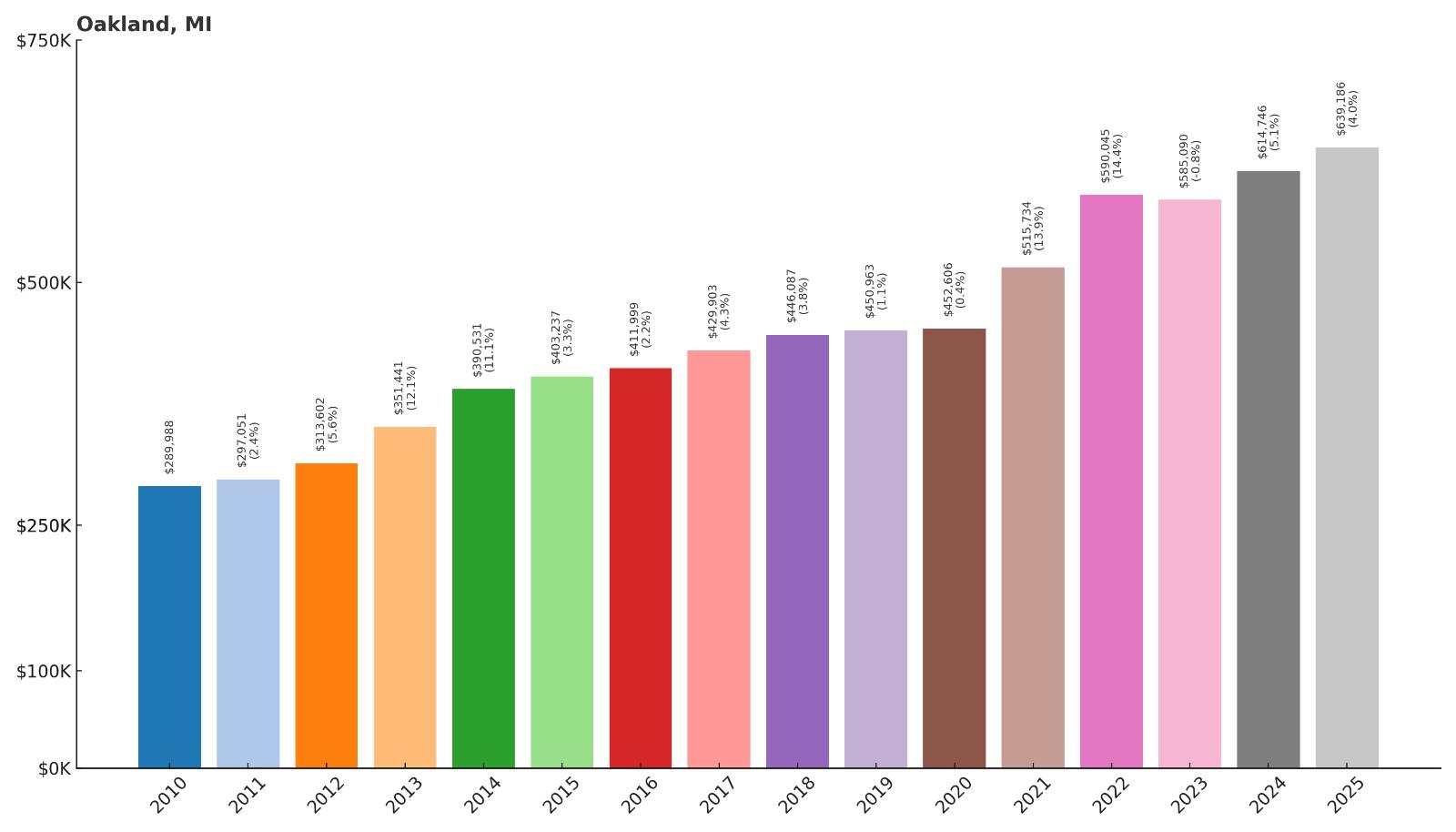
- 2010: $289,988
- 2011: $297,051
- 2012: $313,602
- 2013: $351,441
- 2014: $390,531
- 2015: $403,237
- 2016: $411,999
- 2017: $429,903
- 2018: $446,087
- 2019: $450,963
- 2020: $452,606
- 2021: $515,734
- 2022: $590,045
- 2023: $585,090
- 2024: $614,746
- 2025: $639,186
Oakland demonstrated consistent growth throughout the period, more than doubling in value since 2010. The community showed particularly strong appreciation from 2013-2015 and again during the pandemic years. At $639,186, this Oakland County suburb reflects the sustained demand for upscale communities with excellent amenities and strategic locations.
Why Oakland?
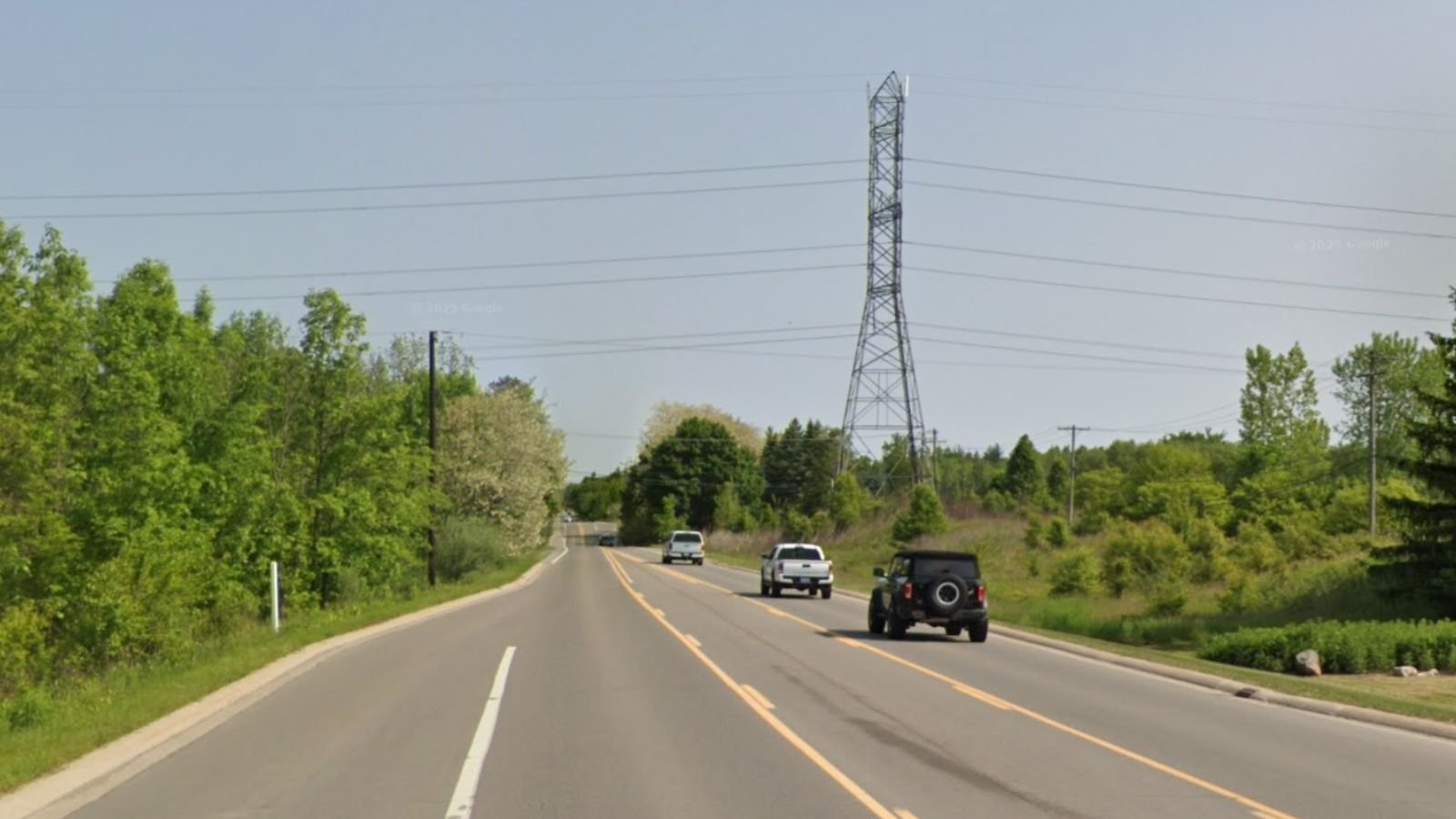
Why are people willing to pay so much to live here? What’s special about it?
Oakland offers the sophisticated suburban lifestyle that Oakland County is known for, with excellent schools, beautiful neighborhoods, and convenient access to major employment centers throughout the region. The community provides a perfect balance of residential tranquility and urban convenience, making it attractive to professionals and families seeking quality living without sacrificing career opportunities.
Residents enjoy well-maintained infrastructure, numerous parks and recreational facilities, and the prestige that comes with an Oakland County address. The community’s stability and continued investment in public services create an environment that supports long-term property value growth and appeals to buyers seeking both luxury and practicality.
How Oakland Rose to Prominence
Oakland developed as part of the broader Oakland County suburban expansion that accelerated after World War II. The area’s growth was driven by Detroit’s economic prosperity and the desire for newer, larger homes outside the city limits. Oakland’s location provided easy access to both Detroit and emerging suburban employment centers.
The community built its reputation through careful planning, investment in schools and infrastructure, and maintaining high development standards that attracted affluent residents. As Oakland County became synonymous with upscale suburban living, communities like Oakland benefited from the broader reputation while establishing their own identity as premium residential destinations.
3 Interesting Tidbits
1. County Connection – The community shares its name with Oakland County, reflecting its central role in the county’s identity and development patterns.
2. Corporate Proximity – Oakland’s location provides easy access to major corporate headquarters throughout Oakland County, making it attractive to executives and senior managers.
3. Educational Excellence – The area’s schools consistently rank among Michigan’s top performers, contributing significantly to property values and family attraction to the community.
18. Empire – 101.2% Home Price Increase Since 2010
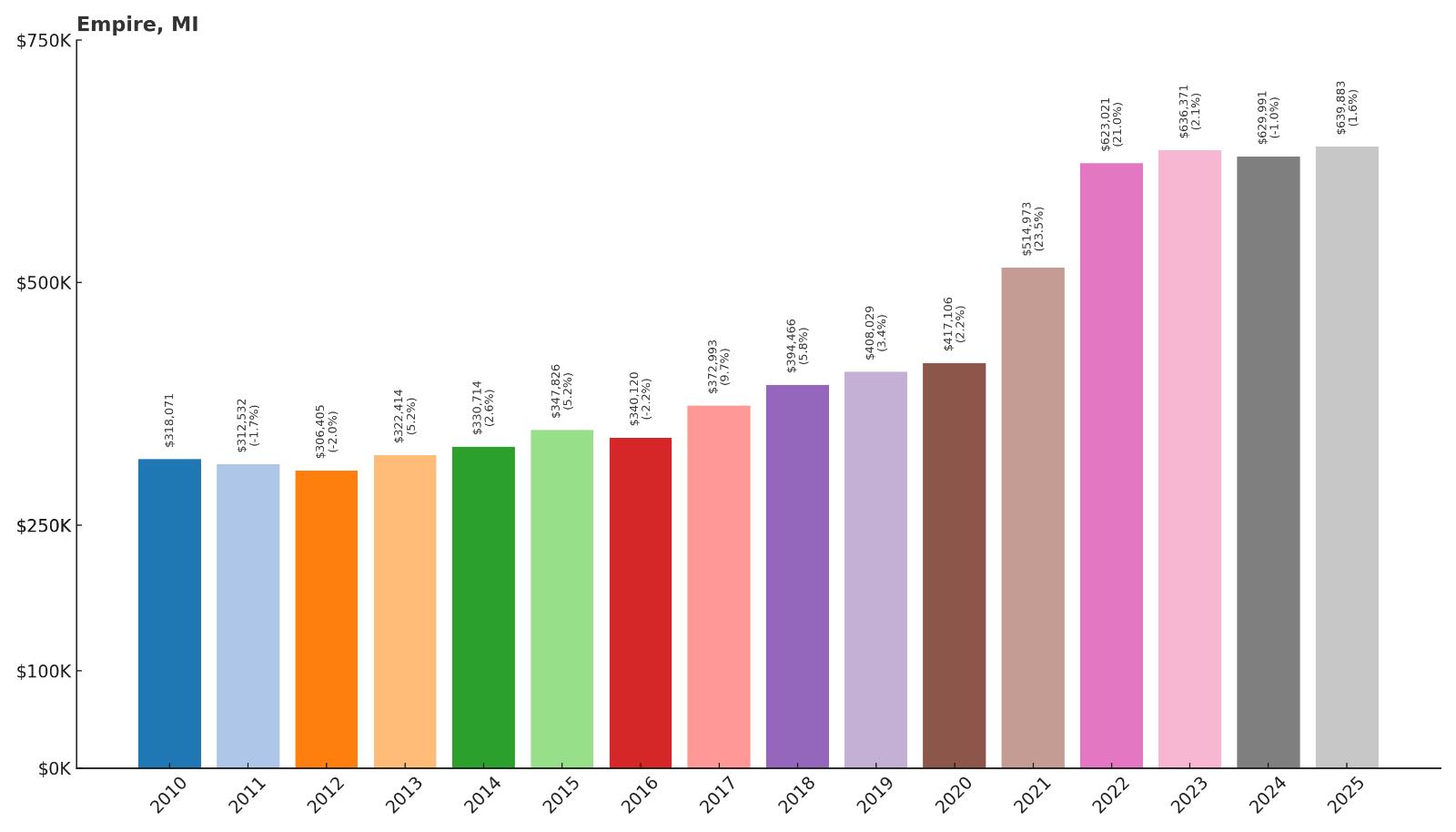
- 2010: $318,071
- 2011: $312,532
- 2012: $306,405
- 2013: $322,414
- 2014: $330,714
- 2015: $347,826
- 2016: $340,120
- 2017: $372,993
- 2018: $394,466
- 2019: $408,029
- 2020: $417,106
- 2021: $514,973
- 2022: $623,021
- 2023: $636,371
- 2024: $629,991
- 2025: $639,883
Empire started from a relatively high base of over $318,000 and doubled by 2025, though growth was more measured compared to other communities. The town experienced some volatility in the mid-2010s before significant gains during the pandemic years. Current values at nearly $640,000 reflect the premium for this Lake Michigan community within Sleeping Bear Dunes National Lakeshore.
Why Empire?
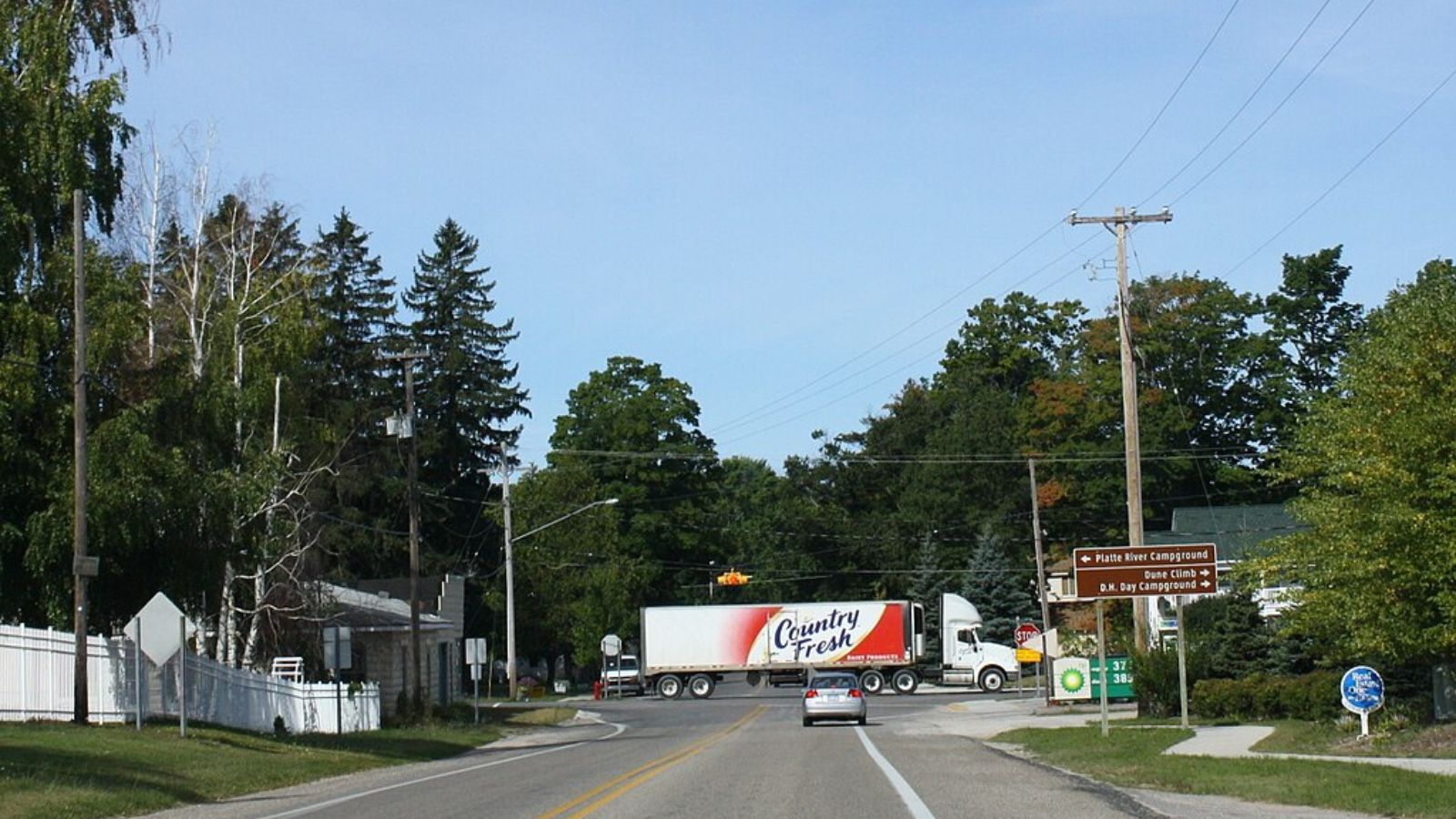
Why are people willing to pay so much to live here? What’s special about it?
Empire provides direct access to some of Michigan’s most spectacular natural attractions, including the Pierce Stocking Scenic Drive and the famous Sleeping Bear Dunes. The town offers a small, tight-knit community atmosphere with stunning Lake Michigan beaches just minutes away. Residents enjoy the rare combination of protected wilderness areas and modern amenities that create an exceptional quality of life.
The community’s location within the national lakeshore ensures that development is carefully controlled, maintaining the natural character that originally attracted residents and visitors. Empire appeals to buyers who prioritize outdoor recreation, natural beauty, and the assurance that their investment is protected by federal land designation.
How Empire Rose to Prominence
Empire was established in the 1860s as a lumber town, taking advantage of its location near vast forests and Lake Michigan transportation routes. The community grew around sawmills and lumber operations that shipped timber to Chicago and other Great Lakes ports. As logging declined, the area transitioned to farming and gradually began attracting summer visitors drawn to its scenic location.
The creation of Sleeping Bear Dunes National Lakeshore in 1970 marked a turning point for Empire, transforming it from a quiet rural community to a gateway destination for one of Michigan’s most popular natural attractions. This federal designation brought both opportunities and restrictions that have shaped the community’s development ever since.
3 Interesting Tidbits
1. Dunes Access – Empire is the primary gateway to the Sleeping Bear Dunes climbing area, one of Michigan’s most iconic outdoor experiences that draws visitors from around the world.
2. Lighthouse Legacy – The nearby South Manitou Island Lighthouse, accessible by ferry from the area, represents the region’s maritime heritage and continues to attract history enthusiasts.
3. Agricultural Transition – Empire retains some of its agricultural character with local farms and orchards that supply fresh produce and contribute to the area’s rural charm.
17. New Buffalo – 76.0% Home Price Increase Since 2014
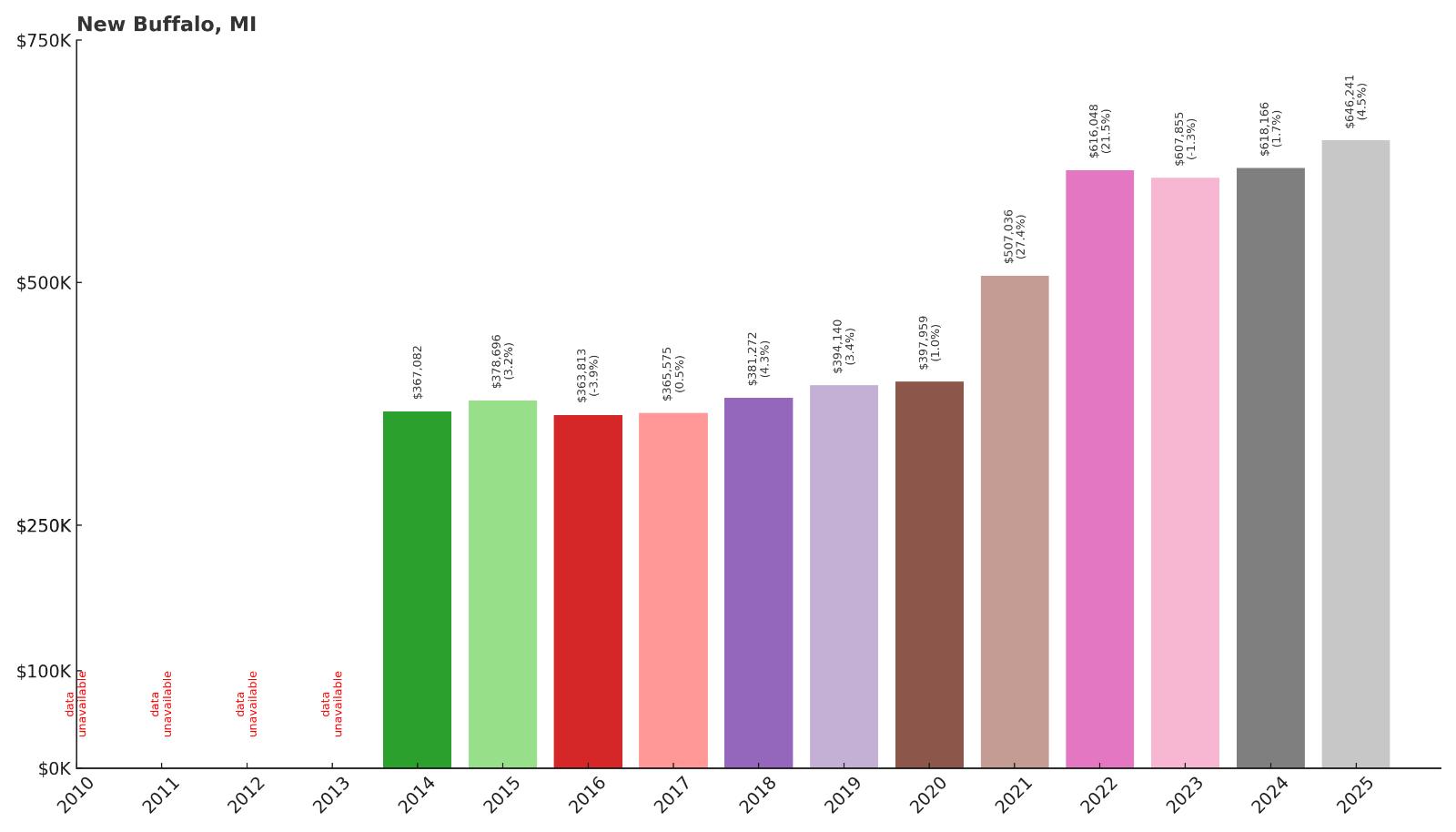
- 2010: N/A
- 2011: N/A
- 2012: N/A
- 2013: N/A
- 2014: $367,082
- 2015: $378,696
- 2016: $363,813
- 2017: $365,575
- 2018: $381,272
- 2019: $394,140
- 2020: $397,959
- 2021: $507,036
- 2022: $616,048
- 2023: $607,855
- 2024: $618,166
- 2025: $646,241
New Buffalo shows impressive growth of 76% since 2014, starting from an already substantial base near $367,000. The community experienced steady appreciation through 2020, then significant increases during the pandemic years. At $646,241, this southwestern Michigan lakefront community reflects its position as “Harbor Country’s” most developed resort destination.
Why New Buffalo?
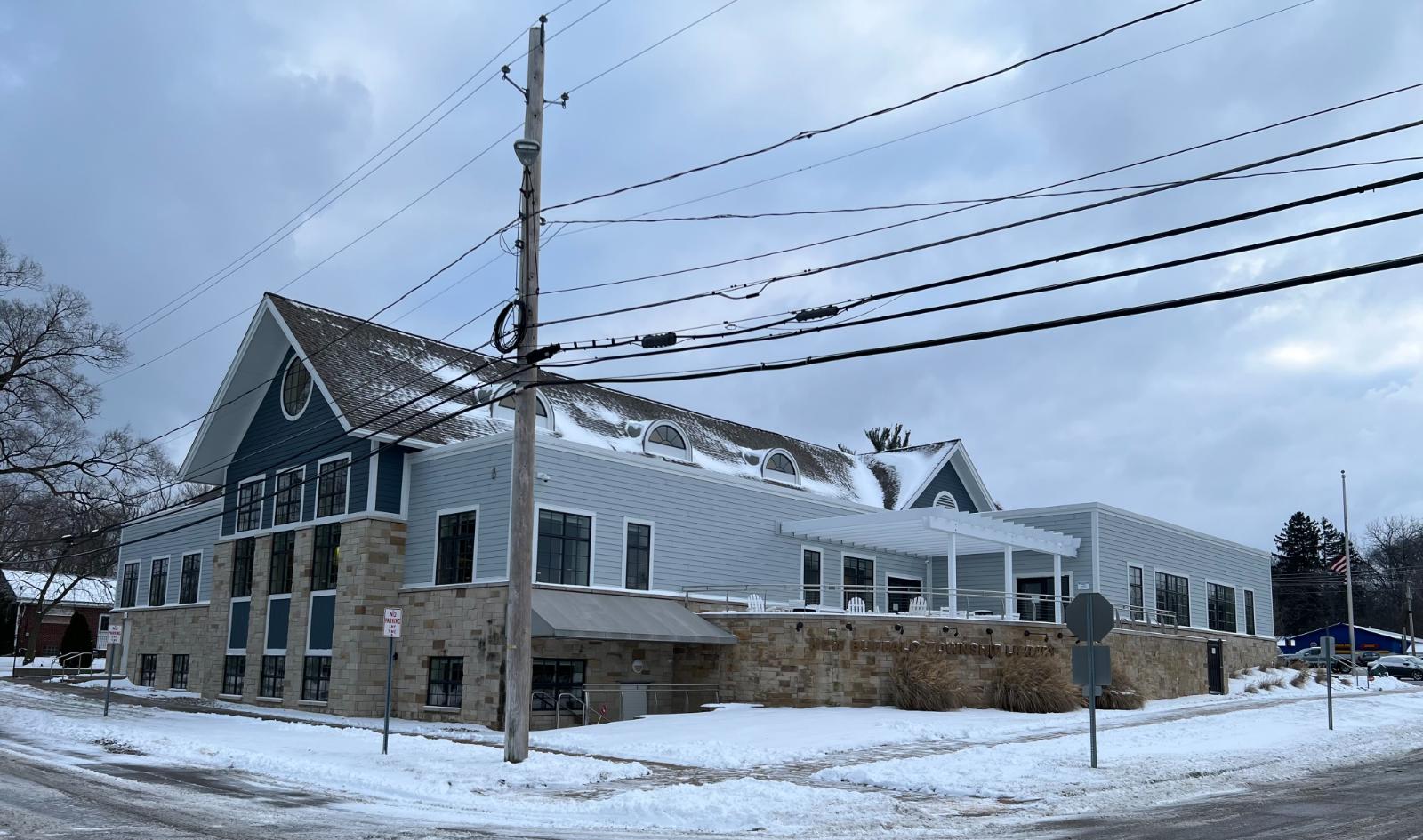
Why are people willing to pay so much to live here? What’s special about it?
New Buffalo serves as the crown jewel of Michigan’s Harbor Country, offering pristine Lake Michigan beaches combined with a sophisticated resort town atmosphere. The community features upscale restaurants, boutique shopping, and luxury accommodations that rival coastal destinations anywhere in the Midwest. Its proximity to Chicago makes it an attractive weekend retreat and second-home destination for affluent urban dwellers.
The town provides both public beaches and exclusive residential areas with direct lake access, creating options for different types of luxury living. New Buffalo’s four-season appeal, from summer beach activities to winter wine tastings and year-round cultural events, justifies premium pricing for buyers seeking a complete resort lifestyle experience.
How New Buffalo Rose to Prominence
New Buffalo began as a lumber town in the 1830s but transformed into a resort destination as Chicago residents discovered its beautiful beaches and convenient railroad access. The town became a popular summer retreat for wealthy families who built large cottages along the lakefront. The development of Harbor Country as a cohesive resort region elevated New Buffalo’s profile as the area’s most sophisticated destination.
Modern development has focused on balancing resort amenities with residential quality, attracting both permanent residents and second-home buyers. The town’s strategic marketing as a premium lakefront destination has successfully positioned it as the Harbor Country flagship, commanding prices that reflect its status and amenities.
3 Interesting Tidbits
1. Harbor Country Hub – New Buffalo anchors the Harbor Country region, a collection of southwestern Michigan lakefront communities that market themselves collectively as a premier resort destination.
2. Beach Rankings – Warren Dunes State Park, located just south of New Buffalo, features some of the highest sand dunes and most popular beaches on the eastern shore of Lake Michigan.
3. Chicago Connection – The town’s location just 90 minutes from Chicago has made it a favored retreat for city dwellers, leading to significant development of luxury homes and resort amenities.
16. Suttons Bay – 133.0% Home Price Increase Since 2010

- 2010: $277,826
- 2011: $276,559
- 2012: $281,093
- 2013: $278,469
- 2014: $296,638
- 2015: $316,018
- 2016: $323,669
- 2017: $355,277
- 2018: $380,584
- 2019: $403,799
- 2020: $429,015
- 2021: $542,091
- 2022: $666,968
- 2023: $652,600
- 2024: $651,990
- 2025: $647,388
Suttons Bay achieved substantial growth of 133% since 2010, with the most dramatic increases occurring during 2021-2022 when values jumped from around $429,000 to nearly $667,000. Values have stabilized around $647,000, reflecting this Leelanau Peninsula community’s strong appeal as both a resort destination and year-round residence.
Why Suttons Bay?

Why are people willing to pay so much to live here? What’s special about it?
Suttons Bay combines small-town charm with sophisticated amenities along the scenic shores of Grand Traverse Bay. The community serves as Leelanau County’s government center while maintaining a village atmosphere with quality restaurants, art galleries, and boutique shops. Residents enjoy easy access to both Traverse City’s amenities and the recreational opportunities throughout the Leelanau Peninsula.
The town’s location offers spectacular water views and convenient access to northern Michigan’s wine country, making it attractive to retirees and professionals seeking a refined but relaxed lifestyle. Suttons Bay provides the infrastructure and services of a county seat while maintaining the character and natural beauty that define northern Michigan living.
How Suttons Bay Rose to Prominence
Suttons Bay was settled in the 1850s and grew as a lumber and farming community along Grand Traverse Bay. The town became more prominent when it was selected as the new Leelanau County seat in 2004, moving from Leland to take advantage of more modern facilities and central location. This governmental role brought stability and recognition to the community.
The development of northern Michigan’s wine industry and tourism sector significantly benefited Suttons Bay, which positioned itself as a sophisticated base for exploring the region. The town’s combination of natural beauty, cultural amenities, and governmental services has created a unique identity that appeals to both residents and visitors.
3 Interesting Tidbits
1. County Seat Status – Suttons Bay became Leelanau County’s seat in 2004 after the county government moved from historic Leland, bringing jobs and stability to the community.
2. Wine Trail Gateway – The town serves as a central hub for the Leelanau Peninsula Wine Trail, with several award-winning wineries located nearby taking advantage of the area’s favorable growing conditions.
3. Marina Excellence – Suttons Bay Marina is considered one of the finest on Grand Traverse Bay, attracting boaters from throughout the Great Lakes region and supporting the town’s upscale tourism industry.
15. East Grand Rapids – 170.9% Home Price Increase Since 2010
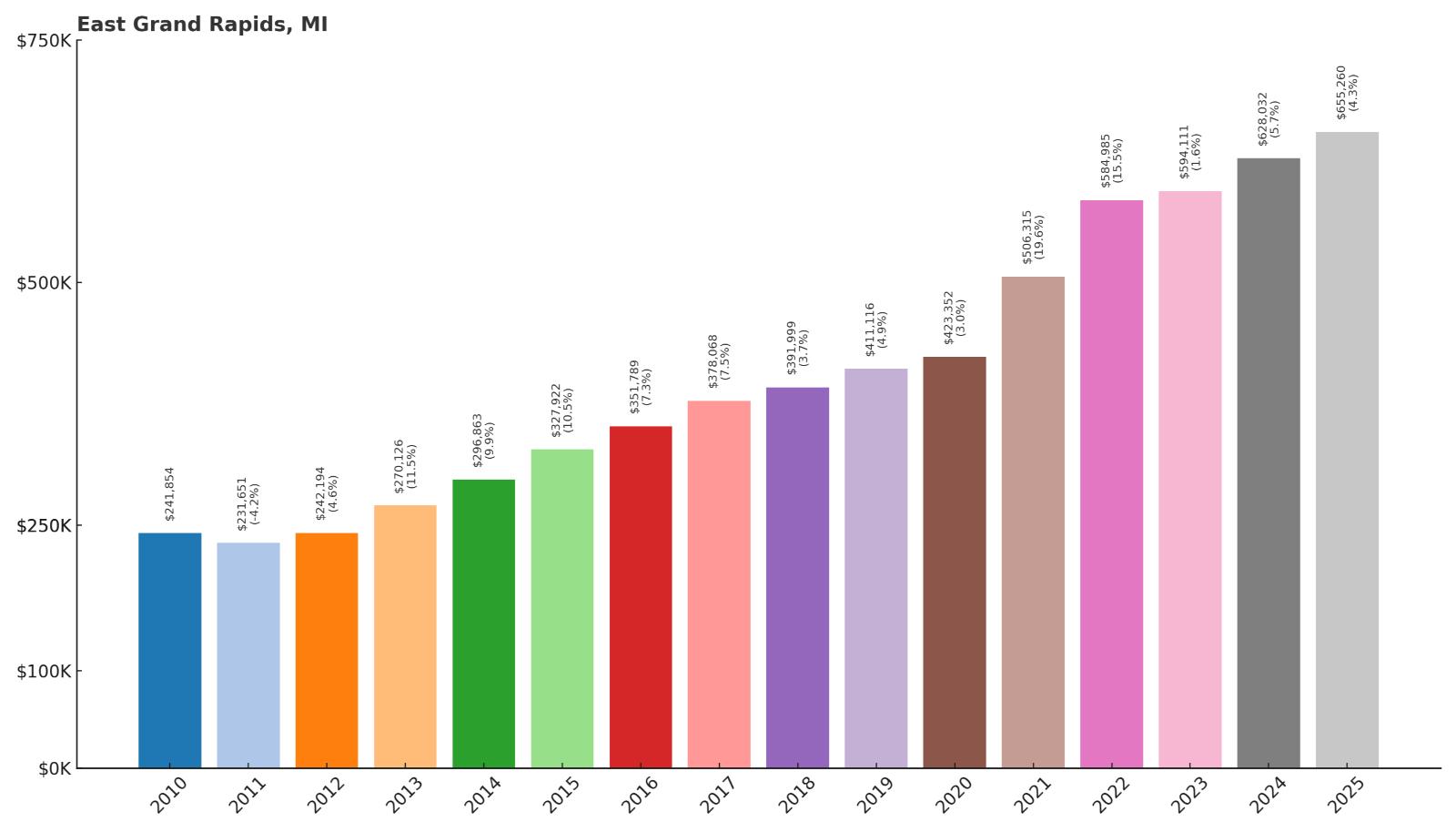
- 2010: $241,854
- 2011: $231,651
- 2012: $242,194
- 2013: $270,126
- 2014: $296,863
- 2015: $327,922
- 2016: $351,789
- 2017: $378,068
- 2018: $391,999
- 2019: $411,116
- 2020: $423,352
- 2021: $506,315
- 2022: $584,985
- 2023: $594,111
- 2024: $628,032
- 2025: $655,260
East Grand Rapids posted the highest growth rate among communities with complete data, increasing over 170% since 2010. The city showed steady gains throughout the period, with acceleration during 2013-2016 and again during the pandemic. Current values at $655,260 reflect this community’s status as western Michigan’s premier suburban address.
Why East Grand Rapids?
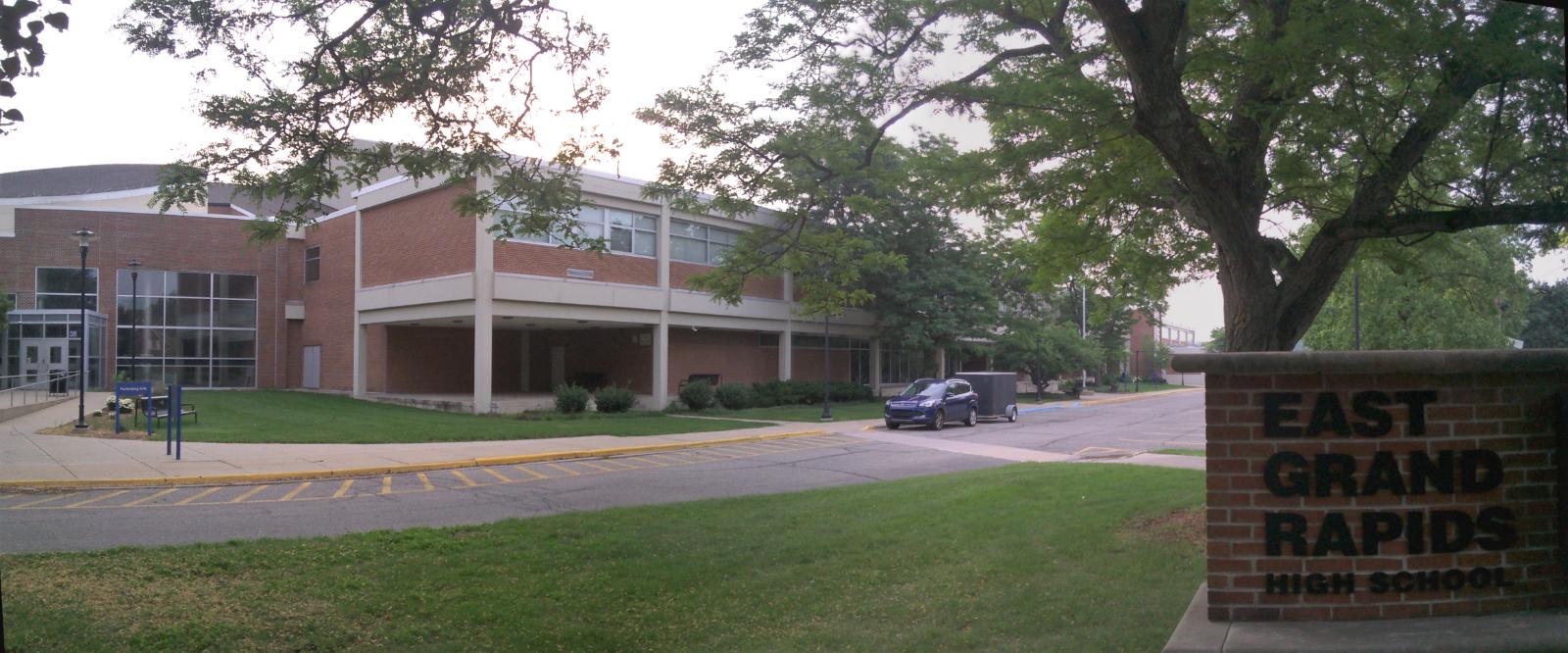
Why are people willing to pay so much to live here? What’s special about it?
East Grand Rapids represents the pinnacle of western Michigan suburban living, offering tree-lined neighborhoods, excellent schools, and a charming downtown area with local shops and restaurants. The community provides easy access to Grand Rapids’ employment centers and cultural amenities while maintaining a distinct small-town identity. Residents enjoy numerous lakes, parks, and recreational opportunities within the city limits.
The city’s reputation for excellent municipal services, low crime rates, and strong property values makes it particularly attractive to successful professionals and business leaders. East Grand Rapids provides the security and prestige of an established, affluent community while offering the personal touches and civic engagement that residents value.
How East Grand Rapids Rose to Prominence
East Grand Rapids was incorporated in 1926 as an exclusive residential community designed to attract wealthy Grand Rapids families seeking suburban living. The city was planned around several small lakes and emphasized large lots, quality homes, and extensive park space. This careful planning created a community character that has endured for nearly a century.
The city’s growth coincided with Grand Rapids’ development as a major furniture manufacturing center and later as a diversified business hub. East Grand Rapids became the preferred address for business leaders, professionals, and successful entrepreneurs who wanted the best suburban amenities while remaining close to the city’s economic opportunities.
3 Interesting Tidbits
1. Lake Community – East Grand Rapids encompasses several small lakes within its boundaries, creating a unique suburban environment with extensive waterfront living opportunities.
2. School Legacy – The East Grand Rapids school system has been consistently ranked among Michigan’s top districts, with high graduation rates and college acceptance rates that attract families from throughout the region.
3. Historic Preservation – The city has carefully preserved its original architectural character while accommodating growth, maintaining the tree-lined streets and varied home styles that define its identity.
14. Bloomfield Hills – 122.1% Home Price Increase Since 2010
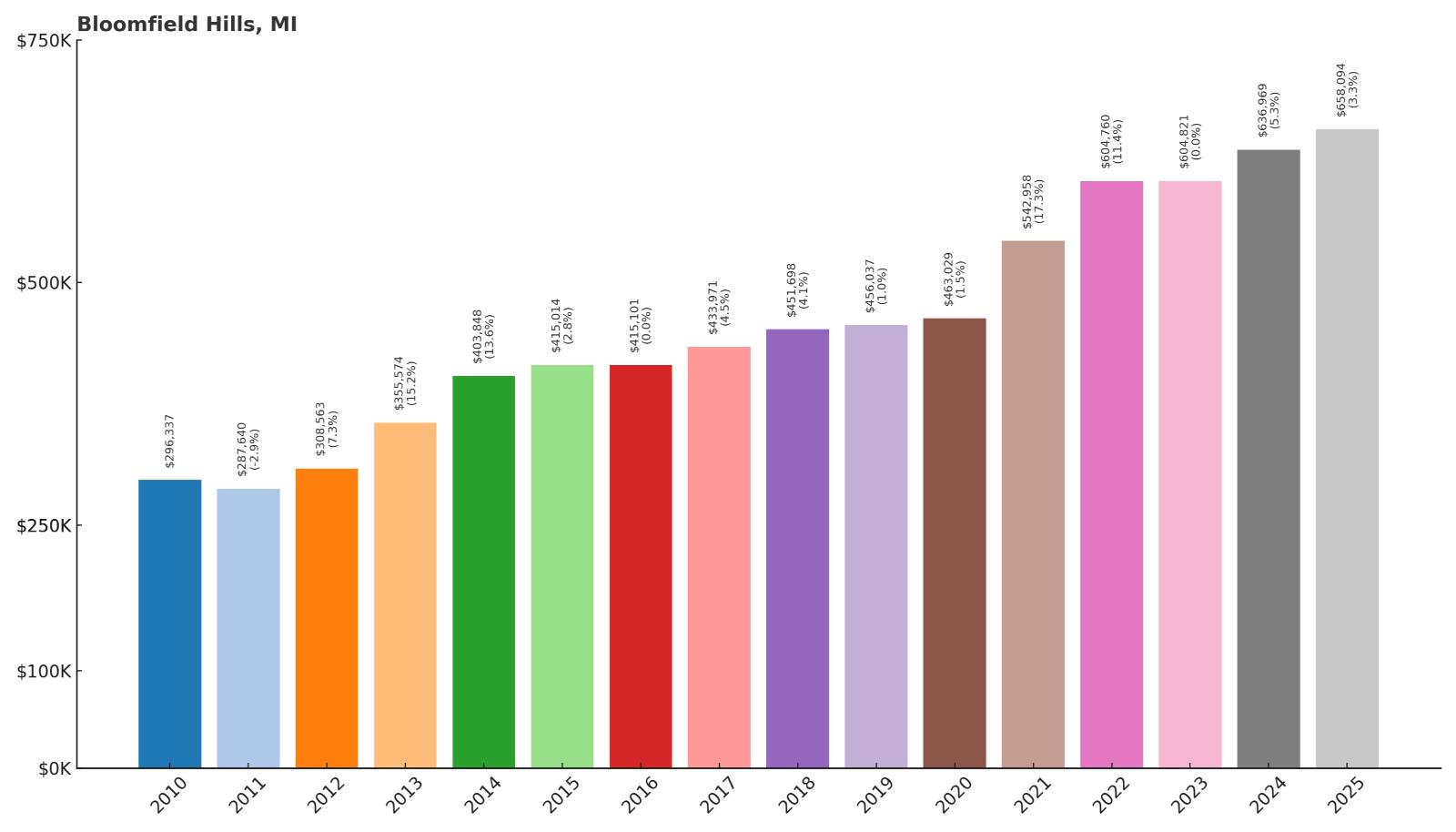
- 2010: $296,337
- 2011: $287,640
- 2012: $308,563
- 2013: $355,574
- 2014: $403,848
- 2015: $415,014
- 2016: $415,101
- 2017: $433,971
- 2018: $451,698
- 2019: $456,037
- 2020: $463,029
- 2021: $542,958
- 2022: $604,760
- 2023: $604,821
- 2024: $636,969
- 2025: $658,094
Bloomfield Hills more than doubled in value since 2010, starting from an already premium base near $296,000. The city experienced strong growth from 2012-2015 and steady appreciation throughout the period. At $658,094, this Oakland County community maintains its position as one of Michigan’s most prestigious suburban addresses, reflecting consistent demand from affluent buyers.
Why Bloomfield Hills?
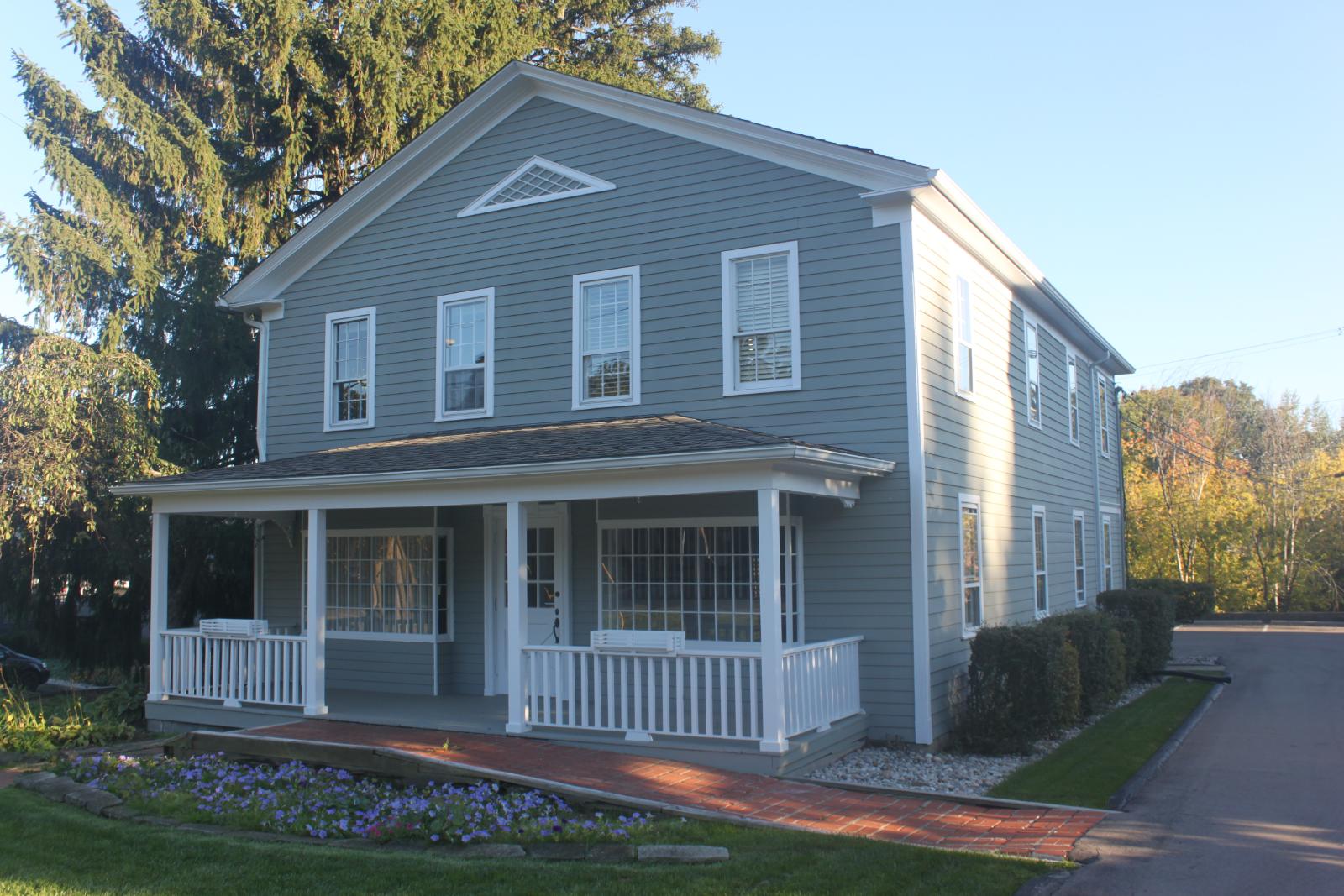
Why are people willing to pay so much to live here? What’s special about it?
Bloomfield Hills epitomizes luxury suburban living in Michigan, featuring sprawling estates, championship golf courses, and some of the state’s most expensive homes. The community offers privacy and exclusivity while remaining close to Detroit’s business centers and cultural attractions. Residents enjoy top-rated schools, extensive green space, and the prestige that comes with one of Michigan’s most recognizable addresses.
The city’s careful planning and large lot requirements have preserved its character as an exclusive enclave where successful business leaders, athletes, and entertainment figures choose to live. Bloomfield Hills provides the ultimate combination of luxury amenities, natural beauty, and convenient access to metropolitan Detroit’s opportunities.
How Bloomfield Hills Rose to Prominence
Bloomfield Hills was developed in the 1920s as an exclusive suburban community for Detroit’s growing wealthy class, particularly automotive industry leaders and other business magnates. The community was planned around golf courses and large estates, with curved roads and extensive landscaping that created a park-like atmosphere. Early residents included prominent families like the Fords and other industrial leaders.
The city’s reputation grew throughout the mid-20th century as Detroit’s economic power attracted national attention. Bloomfield Hills became synonymous with success and luxury living in the Midwest, attracting celebrities, sports figures, and business leaders who wanted the finest suburban lifestyle available in the region.
3 Interesting Tidbits
1. Cranbrook Connection – The city is home to Cranbrook Educational Community, including the renowned Cranbrook Academy of Art and Cranbrook Schools, which have educated numerous notable alumni including future leaders in business and the arts.
2. Golf Paradise – Bloomfield Hills features several world-class golf courses, including Oakland Hills Country Club, which has hosted multiple major championships and is considered one of America’s premier golf destinations.
3. Automotive Royalty – The city has been home to numerous automotive industry leaders and continues to attract successful business executives who appreciate its combination of luxury, privacy, and Detroit-area convenience.
13. Douglas – 126.1% Home Price Increase Since 2010
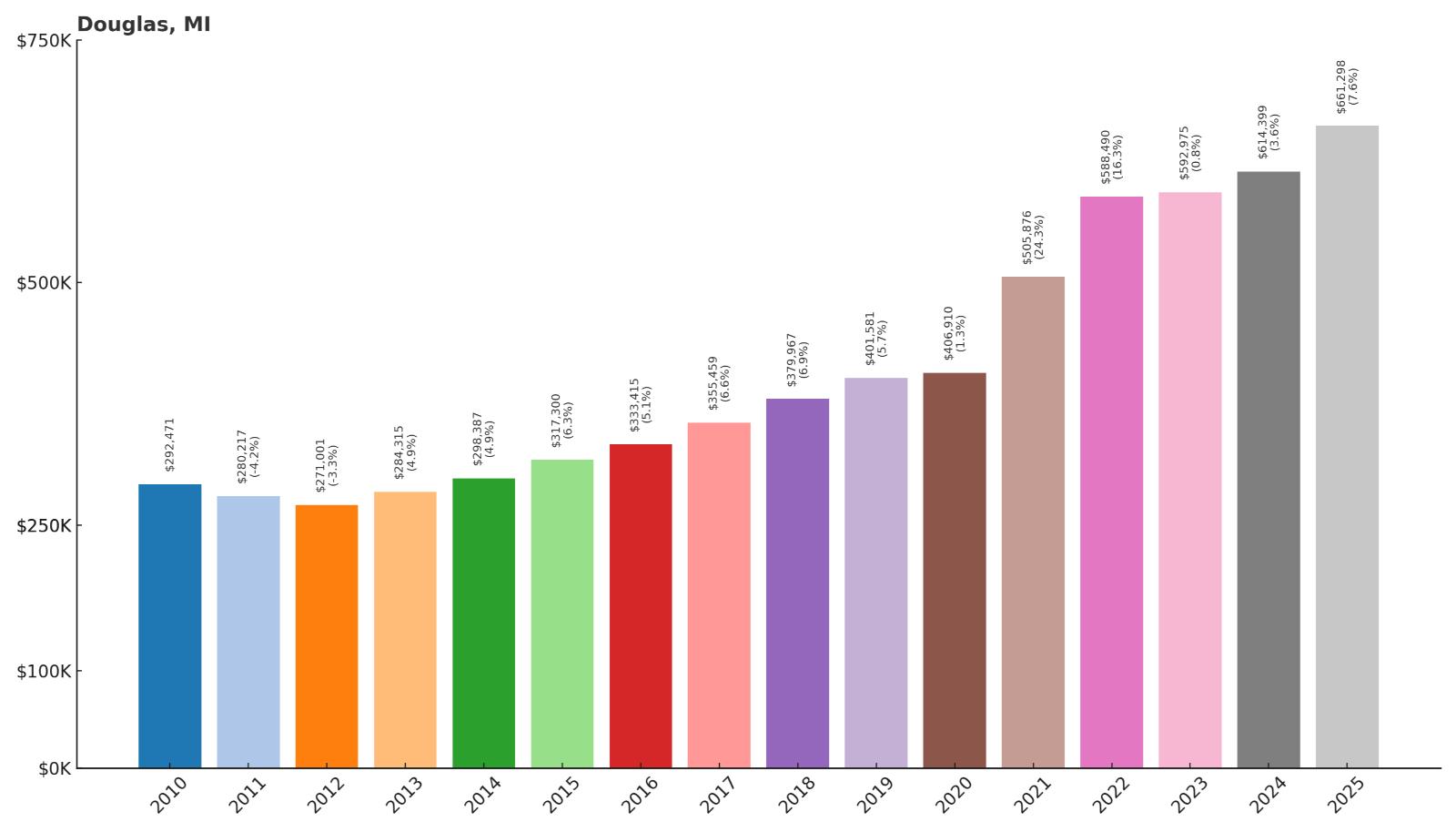
- 2010: $292,471
- 2011: $280,217
- 2012: $271,001
- 2013: $284,315
- 2014: $298,387
- 2015: $317,300
- 2016: $333,415
- 2017: $355,459
- 2018: $379,967
- 2019: $401,581
- 2020: $406,910
- 2021: $505,876
- 2022: $588,490
- 2023: $592,975
- 2024: $614,399
- 2025: $661,298
Douglas achieved strong growth of 126% since 2010, recovering from early-period lows to reach over $661,000 by 2025. The community experienced steady gains from 2013 onward, with dramatic acceleration during the pandemic years. This Lake Michigan resort town’s proximity to Saugatuck and its own distinct character have driven sustained demand and premium pricing.
Why Douglas?
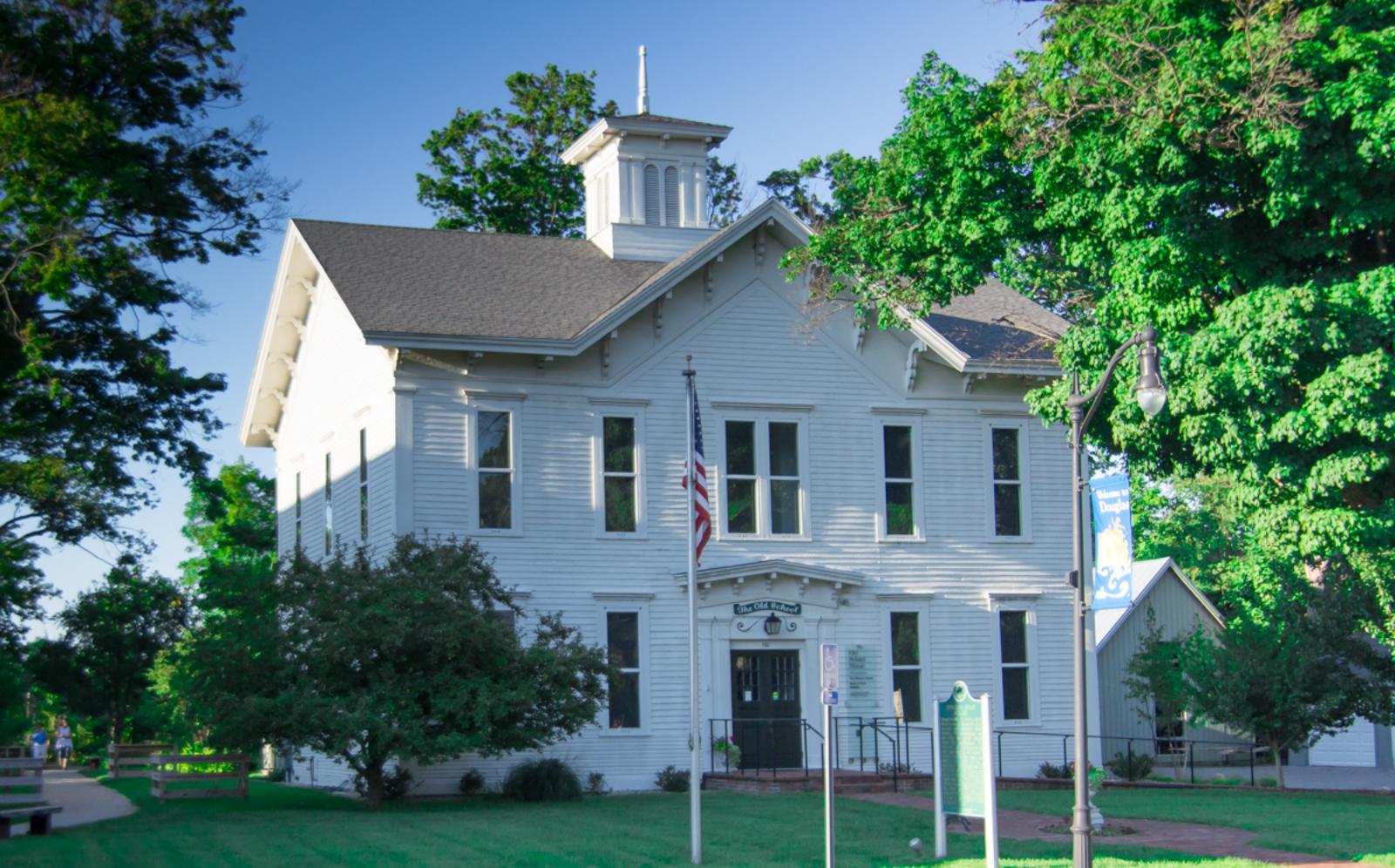
Why are people willing to pay so much to live here? What’s special about it?
Douglas offers a more residential, family-oriented atmosphere compared to nearby Saugatuck while sharing access to the same stunning Lake Michigan beaches and cultural attractions. The community features beautiful Victorian homes, tree-lined streets, and a quieter pace that appeals to buyers seeking the benefits of the Saugatuck area with more privacy and space. Excellent schools and safe neighborhoods make it particularly attractive to families.
The town provides easy walking access to Saugatuck’s galleries, restaurants, and entertainment while maintaining its own distinct identity and residential character. Douglas appeals to buyers who want the best of both worlds: proximity to a vibrant resort community and the tranquility of a more traditional neighborhood setting.
How Douglas Rose to Prominence
Douglas was founded in the 1860s as a lumber town, working in partnership with neighboring Saugatuck to process and ship timber from the vast forests of western Michigan. As the lumber industry declined, Douglas evolved alongside Saugatuck into a resort destination, but maintained more of a residential focus compared to its more tourism-oriented neighbor.
The town’s development emphasized quality housing and family-friendly amenities while benefiting from Saugatuck’s cultural attractions and economic activity. Douglas established itself as the ideal location for those who wanted to be part of the greater Saugatuck area while enjoying a more settled, residential lifestyle.
3 Interesting Tidbits
1. Twin City Connection – Douglas and Saugatuck function as twin cities separated only by the Kalamazoo River, with residents of both communities sharing beaches, schools, and many municipal services.
2. Victorian Heritage – Douglas contains numerous well-preserved Victorian-era homes that reflect the town’s prosperous lumber era and contribute to its distinctive architectural character.
3. School Excellence – The Saugatuck Public School District, which serves Douglas, consistently ranks among Michigan’s top small school systems, contributing significantly to the area’s family appeal.
12. Birmingham – 135.0% Home Price Increase Since 2010
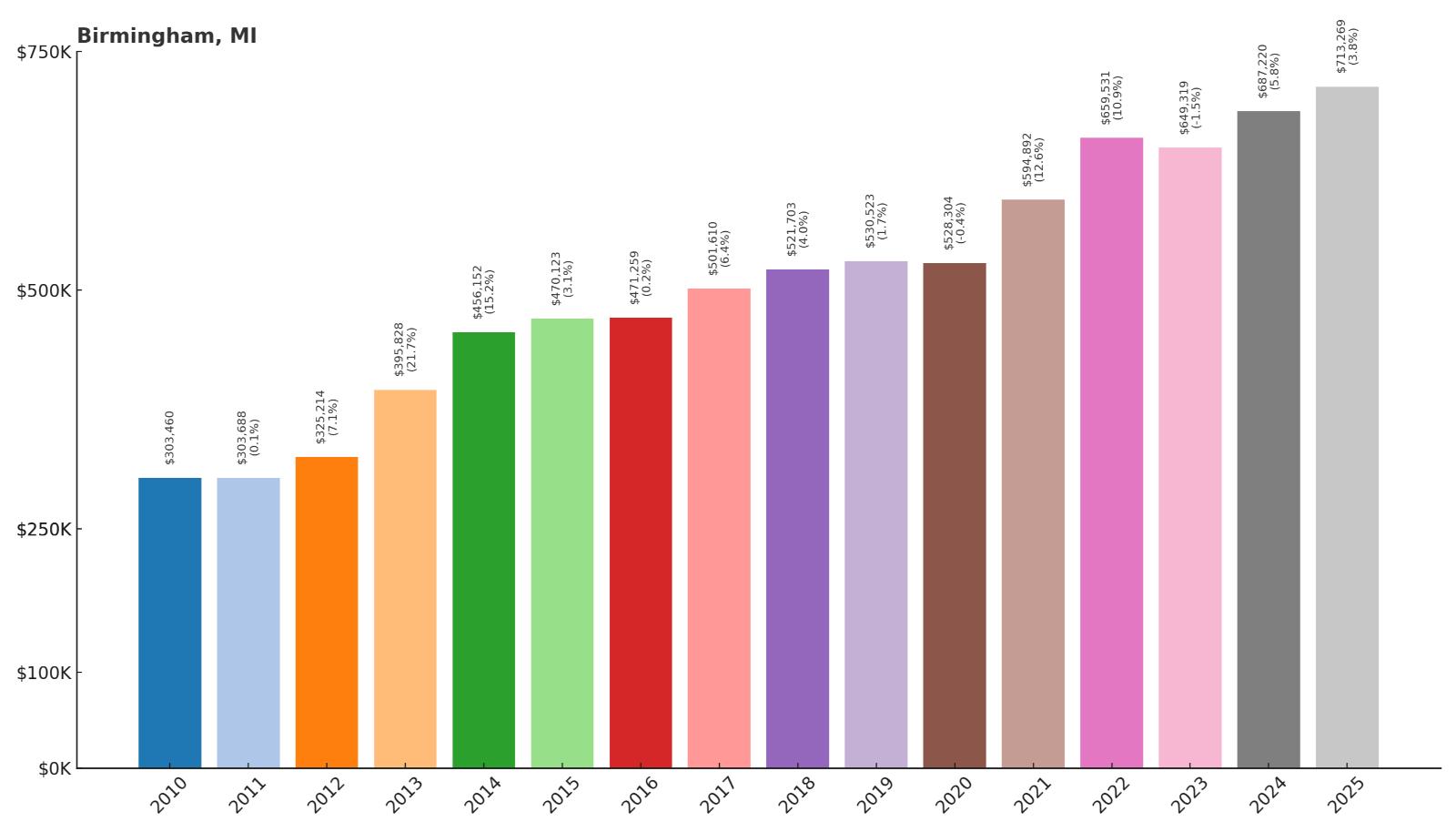
- 2010: $303,460
- 2011: $303,688
- 2012: $325,214
- 2013: $395,828
- 2014: $456,152
- 2015: $470,123
- 2016: $471,259
- 2017: $501,610
- 2018: $521,703
- 2019: $530,523
- 2020: $528,304
- 2021: $594,892
- 2022: $659,531
- 2023: $649,319
- 2024: $687,220
- 2025: $713,269
Birmingham showed exceptional growth of 135% since 2010, with particularly dramatic increases from 2013-2015 when values jumped from around $325,000 to over $470,000. The city continued steady appreciation throughout the period, reaching $713,269 by 2025. This Oakland County destination represents one of Michigan’s most successful downtown and residential combinations.
Why Birmingham?
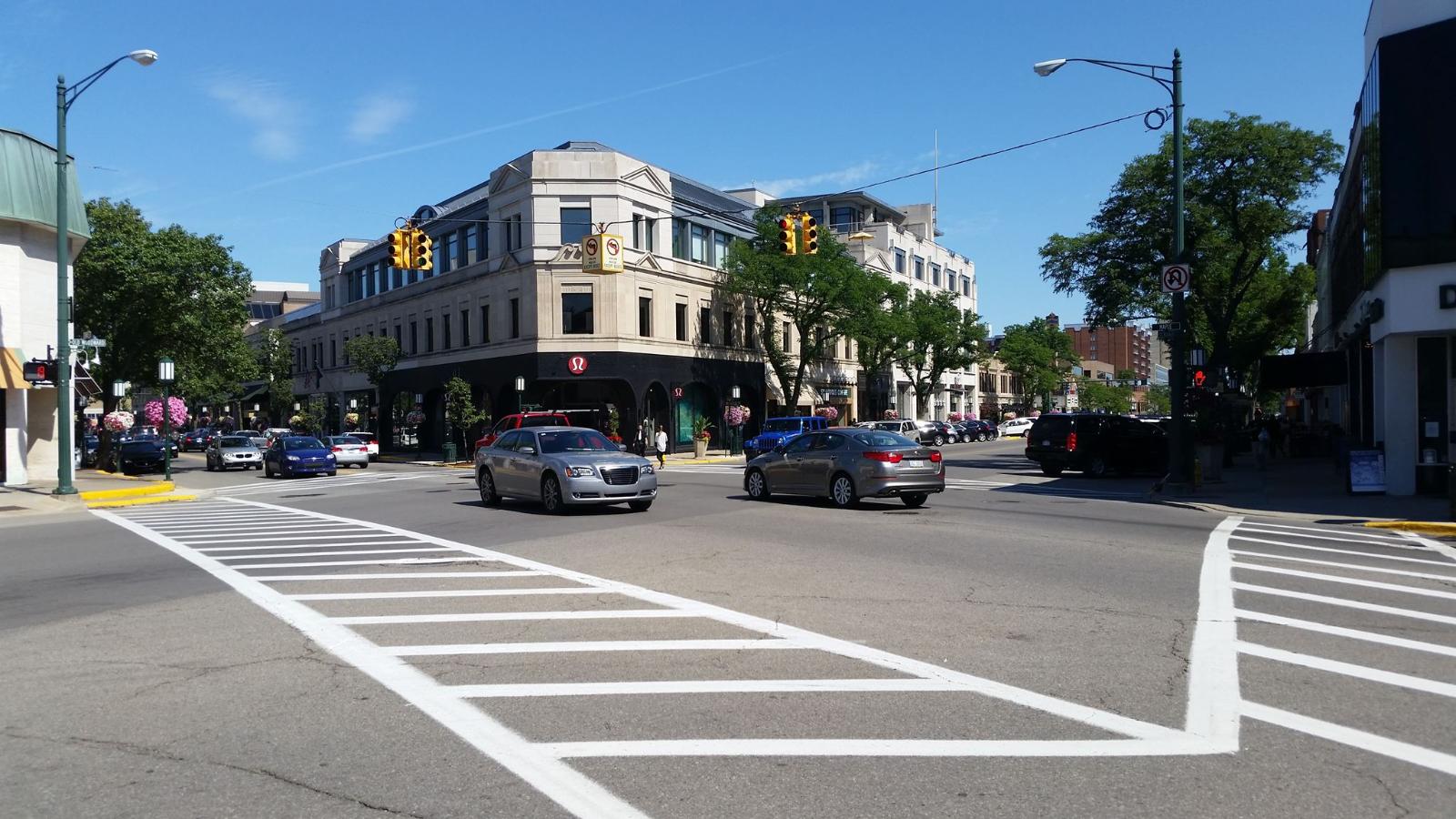
Why are people willing to pay so much to live here? What’s special about it?
Birmingham offers the rare combination of sophisticated urban amenities in a walkable downtown setting paired with beautiful residential neighborhoods just steps away. The city features upscale shopping, fine dining, and cultural events that rival much larger cities, all within a compact area that maintains small-town character. Excellent schools and convenient access to Detroit employment centers make it ideal for affluent families and professionals.
The downtown area buzzes with activity year-round, from outdoor festivals and farmers markets to holiday celebrations and art events. Birmingham provides the lifestyle benefits of urban living without the challenges of a large city, creating a unique environment that justifies premium housing costs for residents who value both convenience and community.
How Birmingham Rose to Prominence
Birmingham was established in 1838 but remained a small rural community until the early 20th century when improved transportation connections to Detroit sparked suburban development. The city’s growth accelerated after World War II as families sought newer homes with modern amenities outside Detroit. Birmingham’s downtown was carefully developed to serve both residents and visitors.
The city’s success came from balancing residential quality with commercial vitality, creating a downtown that serves as both a shopping destination and community gathering place. Birmingham’s commitment to architectural standards, public spaces, and cultural programming helped establish it as one of Oakland County’s most desirable addresses.
3 Interesting Tidbits
1. Shopping Destination – Birmingham’s downtown district is considered one of Michigan’s premier shopping areas, featuring both national brands and unique local boutiques that draw visitors from throughout the region.
2. Walkable Design – The city maintains one of Michigan’s most walkable downtown areas, with residential neighborhoods seamlessly connected to shopping, dining, and cultural attractions.
3. Cultural Hub – Birmingham hosts numerous festivals and events throughout the year, including art fairs, concerts, and community celebrations that create a vibrant atmosphere residents and visitors enjoy.
11. Harbert – 101.6% Home Price Increase Since 2014
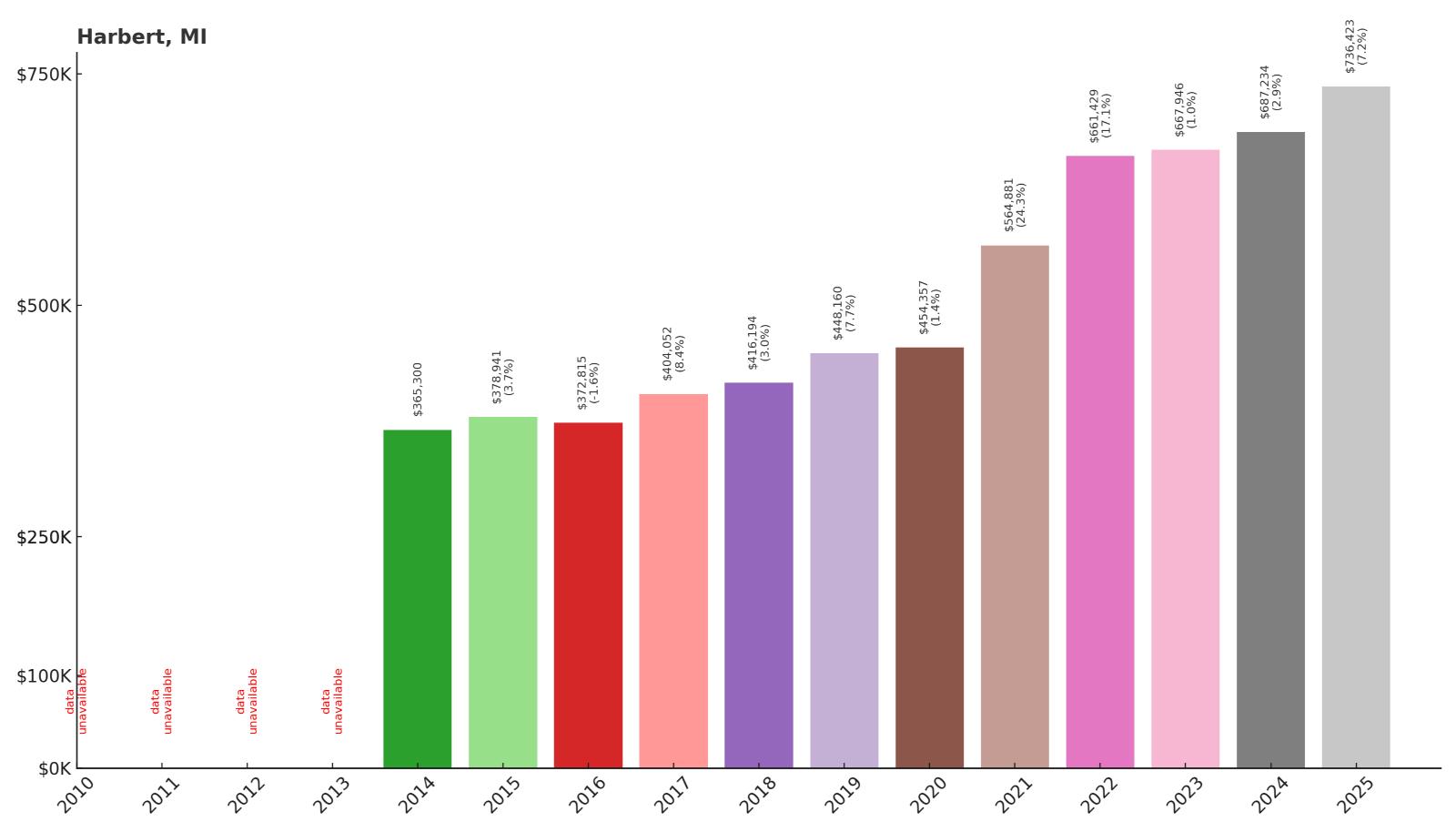
- 2010: N/A
- 2011: N/A
- 2012: N/A
- 2013: N/A
- 2014: $365,300
- 2015: $378,941
- 2016: $372,815
- 2017: $404,052
- 2018: $416,194
- 2019: $448,160
- 2020: $454,357
- 2021: $564,881
- 2022: $661,429
- 2023: $667,946
- 2024: $687,234
- 2025: $736,423
Harbert doubled in value since 2014, starting from an already substantial base of $365,300. The community showed steady growth through 2020, then explosive increases during the pandemic years that pushed values above $736,000. This Harbor Country community has clearly benefited from increased demand for premium lakefront properties in southwestern Michigan.
Why Harbert?

Why are people willing to pay so much to live here? What’s special about it?
Harbert represents the quieter, more residential side of Harbor Country, offering large properties and privacy while maintaining access to Lake Michigan beaches and the region’s resort amenities. The community appeals to buyers seeking a more exclusive, less commercial lakefront experience compared to busier resort towns. Beautiful homes on substantial lots provide the space and luxury that affluent buyers desire.
The area’s proximity to Chicago makes it an ideal retreat destination, while the lack of commercial development preserves the natural beauty and tranquil atmosphere that residents value. Harbert offers the prestige of Harbor Country living with the additional benefits of privacy and exclusivity.
How Harbert Rose to Prominence
Harbert developed as part of the broader Harbor Country region that began attracting Chicago visitors in the late 1800s. The area remained largely rural and undeveloped compared to nearby New Buffalo, creating opportunities for larger estate-style properties. As Harbor Country’s reputation grew, Harbert became known for offering more privacy and space than the busier resort communities.
Modern development has focused on preserving the area’s natural character while accommodating luxury homes and estates. Harbert’s appeal has grown as buyers have sought alternatives to more developed resort areas, appreciating the combination of Harbor Country amenities with rural tranquility and exclusivity.
3 Interesting Tidbits
1. Estate Living – Harbert features some of Harbor Country’s largest residential properties, with many homes situated on multi-acre lots that provide exceptional privacy and space.
2. Natural Preservation – The community has maintained extensive natural areas and woodlands that contribute to its exclusive, estate-like character and appeal to environmentally conscious buyers.
3. Chicago Weekend – Many Harbert properties serve as weekend and summer retreats for Chicago professionals and business leaders who appreciate the area’s accessibility and luxury.
10. Grosse Pointe Shores – 157.8% Home Price Increase Since 2010
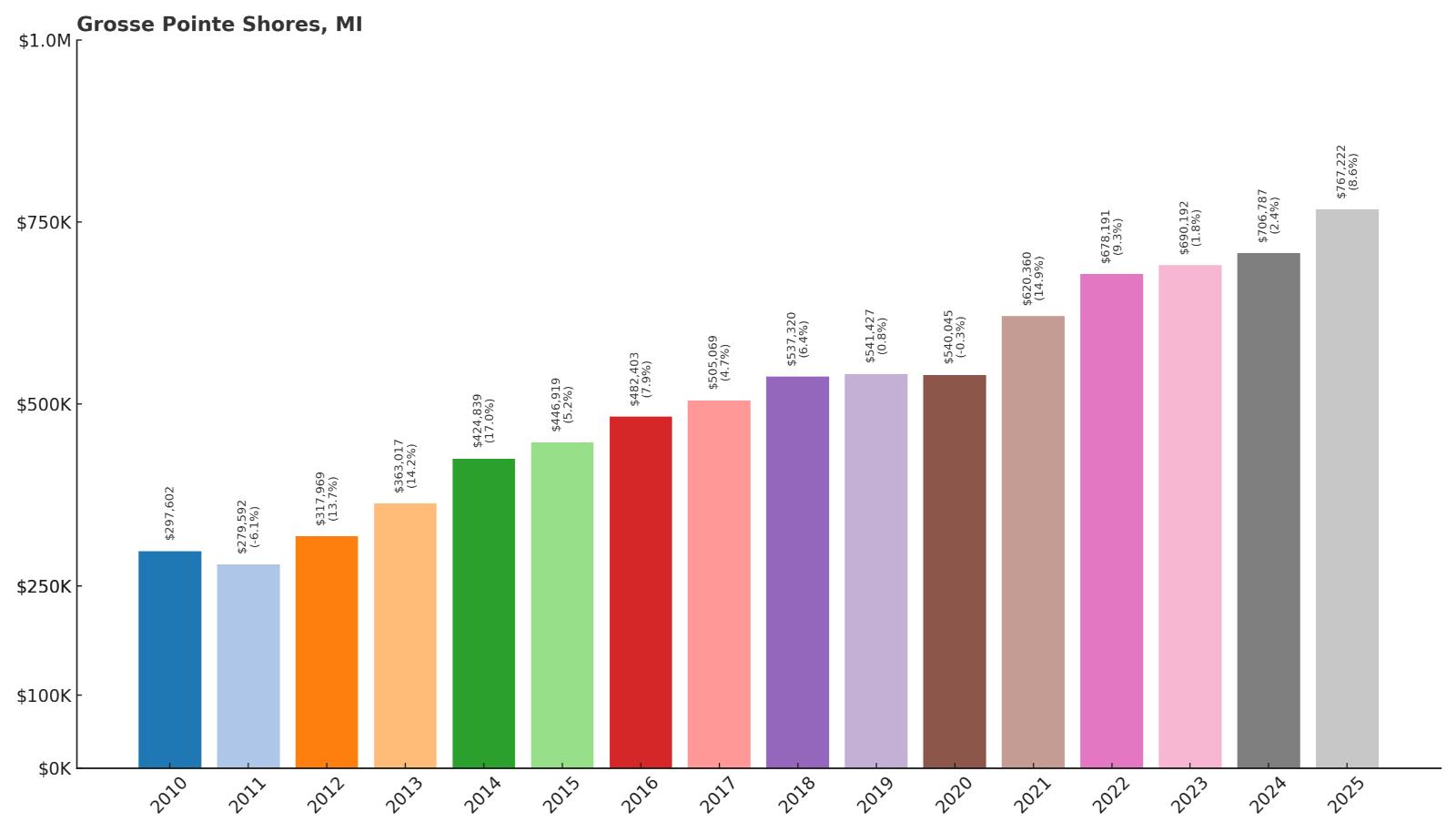
- 2010: $297,602
- 2011: $279,592
- 2012: $317,969
- 2013: $363,017
- 2014: $424,839
- 2015: $446,919
- 2016: $482,403
- 2017: $505,069
- 2018: $537,320
- 2019: $541,427
- 2020: $540,045
- 2021: $620,360
- 2022: $678,191
- 2023: $690,192
- 2024: $706,787
- 2025: $767,222
Grosse Pointe Shores achieved remarkable growth of nearly 158% since 2010, with particularly strong appreciation from 2013-2016 and continued gains throughout the period. Current values at over $767,000 reflect this community’s status as one of the Detroit area’s most prestigious lakefront addresses. The consistent upward trajectory demonstrates sustained demand for exclusive lakefront living.
Why Grosse Pointe Shores?
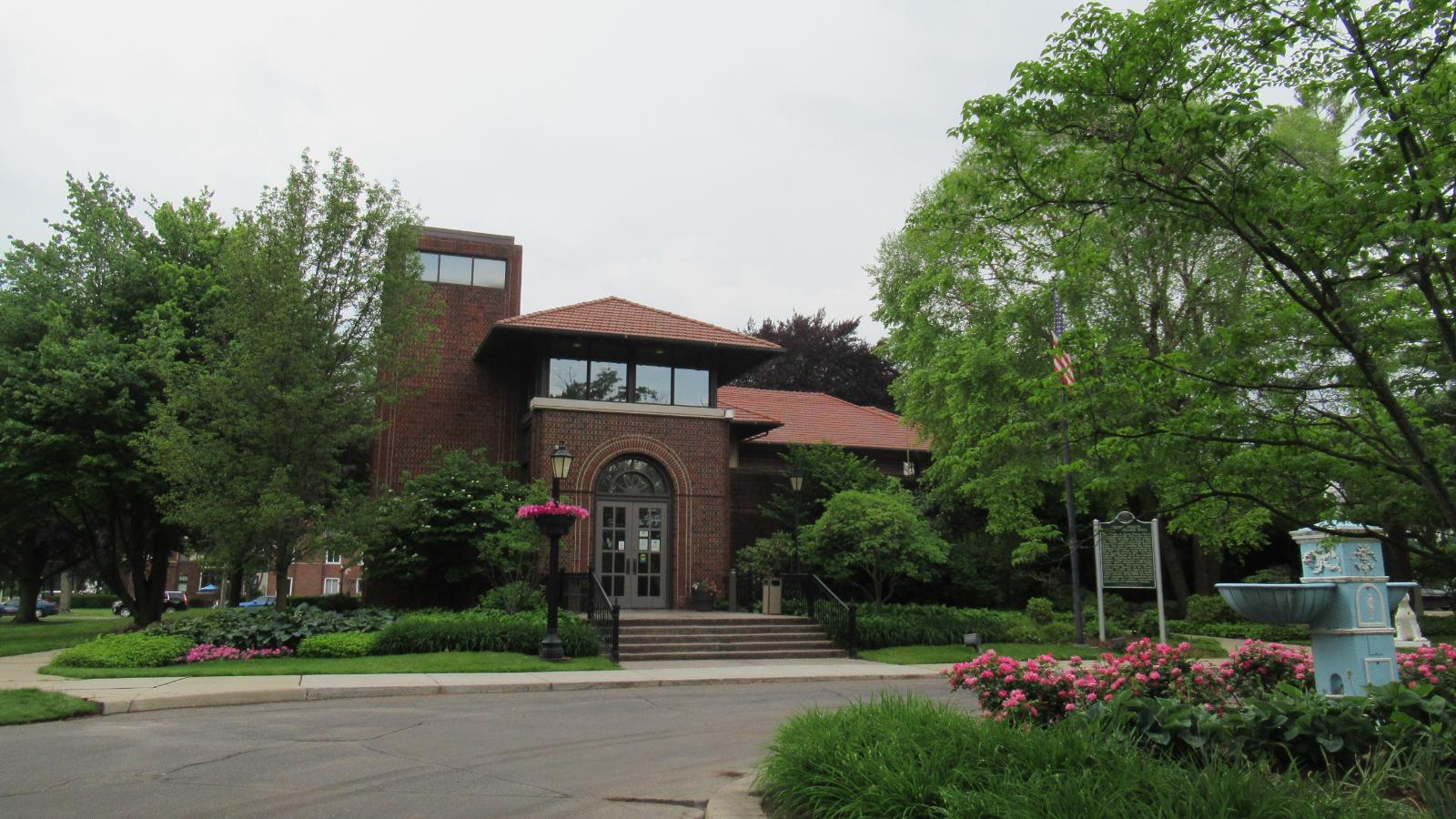
Why are people willing to pay so much to live here? What’s special about it?
Grosse Pointe Shores provides the ultimate in lakefront luxury living, with magnificent estates directly on Lake St. Clair offering private beaches, boat docks, and stunning water views. The community combines the prestige of the Grosse Pointe name with the exclusivity of waterfront living and easy access to downtown Detroit. Residents enjoy top-rated schools, beautiful parks, and the security of one of Michigan’s most affluent neighborhoods.
The lakefront location creates a resort-like atmosphere while maintaining proximity to Detroit’s business and cultural centers. Grosse Pointe Shores offers the rare combination of urban convenience and waterfront living that appeals to successful professionals, business leaders, and others who can afford Michigan’s most expensive residential real estate.
How Grosse Pointe Shores Rose to Prominence
Grosse Pointe Shores was incorporated in 1911 as the most exclusive of the Grosse Pointe communities, designed specifically for the wealthiest Detroit families who wanted lakefront estates. The community attracted automotive industry magnates, shipping executives, and other business leaders who built magnificent homes along Lake St. Clair. The area’s development coincided with Detroit’s emergence as a major industrial center.
The community maintained its exclusive character throughout the 20th century by carefully controlling development and preserving its lakefront character. Grosse Pointe Shores became synonymous with wealth and success in the Detroit area, attracting generations of prominent families who valued both luxury amenities and privacy.
3 Interesting Tidbits
1. Lakefront Legacy – Nearly every home in Grosse Pointe Shores has direct or nearby access to Lake St. Clair, making it one of the few communities where waterfront living is the norm rather than the exception.
2. Edsel Ford Estate – The community was home to Edsel Ford’s estate and continues to attract automotive industry leaders and other prominent Michigan families.
3. Exclusive Services – Grosse Pointe Shores maintains its own public safety services and municipal amenities that cater specifically to the needs of its affluent residents.
9. Union Pier – 102.7% Home Price Increase Since 2010
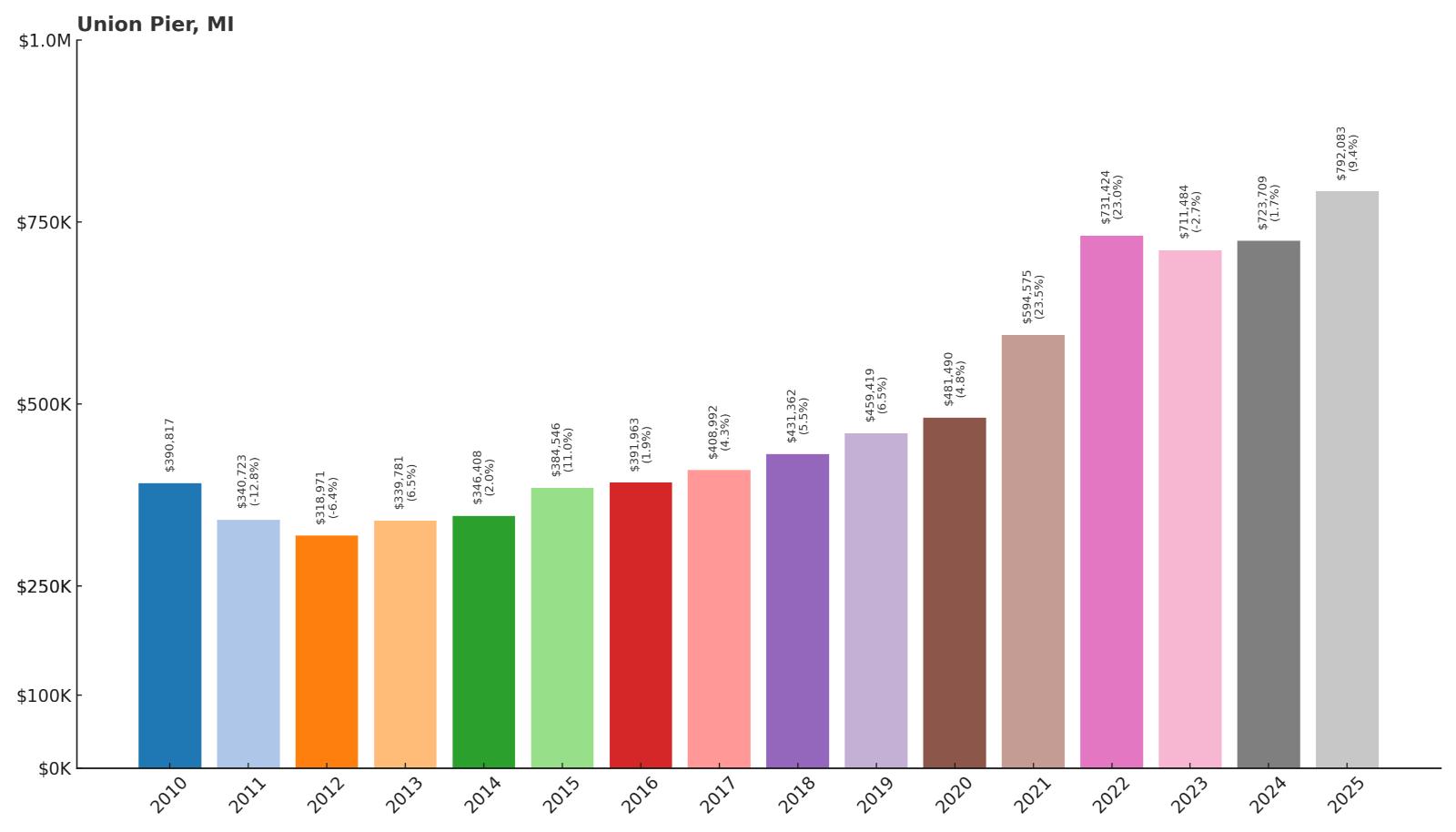
- 2010: $390,817
- 2011: $340,723
- 2012: $318,971
- 2013: $339,781
- 2014: $346,408
- 2015: $384,546
- 2016: $391,963
- 2017: $408,992
- 2018: $431,362
- 2019: $459,419
- 2020: $481,490
- 2021: $594,575
- 2022: $731,424
- 2023: $711,484
- 2024: $723,709
- 2025: $792,083
Union Pier started from the highest base among Harbor Country communities at nearly $391,000 in 2010. Despite some early volatility, values more than doubled to exceed $792,000 by 2025. The dramatic increases during 2021-2022 reflect this premium lakefront community’s appeal to affluent buyers seeking exclusive Lake Michigan access.
Why Union Pier?

Why are people willing to pay so much to live here? What’s special about it?
Union Pier offers some of Michigan’s most exclusive lakefront living, with private beaches, luxury homes, and a sophisticated resort atmosphere that attracts wealthy buyers from Chicago and throughout the Midwest. The community provides direct Lake Michigan access with beautiful sandy beaches and stunning sunset views that create a premium residential experience. Limited development preserves the area’s natural beauty and exclusivity.
Buyers are drawn to Union Pier’s combination of natural beauty, privacy, and proximity to Chicago, making it an ideal location for luxury second homes and primary residences. The community’s reputation for exclusivity and high property values attracts buyers who view their purchase as both a lifestyle investment and a financial asset.
How Union Pier Rose to Prominence
Union Pier began as a railroad town in the 1870s when the Michigan Central Railroad extended service to the lakefront area. The community quickly attracted visitors from Chicago who came by train to enjoy the beaches and cooler summer temperatures. Wealthy families began building summer cottages, establishing Union Pier as an exclusive retreat destination.
The town’s development focused on preserving its natural lakefront character while accommodating increasingly sophisticated amenities and homes. Union Pier’s strategic location and commitment to exclusivity helped it maintain its position as one of Harbor Country’s most prestigious communities throughout changing economic conditions.
3 Interesting Tidbits
1. Railroad Heritage – Union Pier was one of the first Harbor Country communities to benefit from direct railroad service from Chicago, establishing its early role as a premium resort destination.
2. Beach Quality – The community features some of Lake Michigan’s finest private beaches, with wide sandy shores and excellent swimming conditions that have attracted visitors for over 150 years.
3. Architecture Variety – Union Pier showcases diverse architectural styles from Victorian cottages to ultra-modern lakefront estates, reflecting different eras of development and varying buyer preferences.
8. Northport – 131.1% Home Price Increase Since 2010
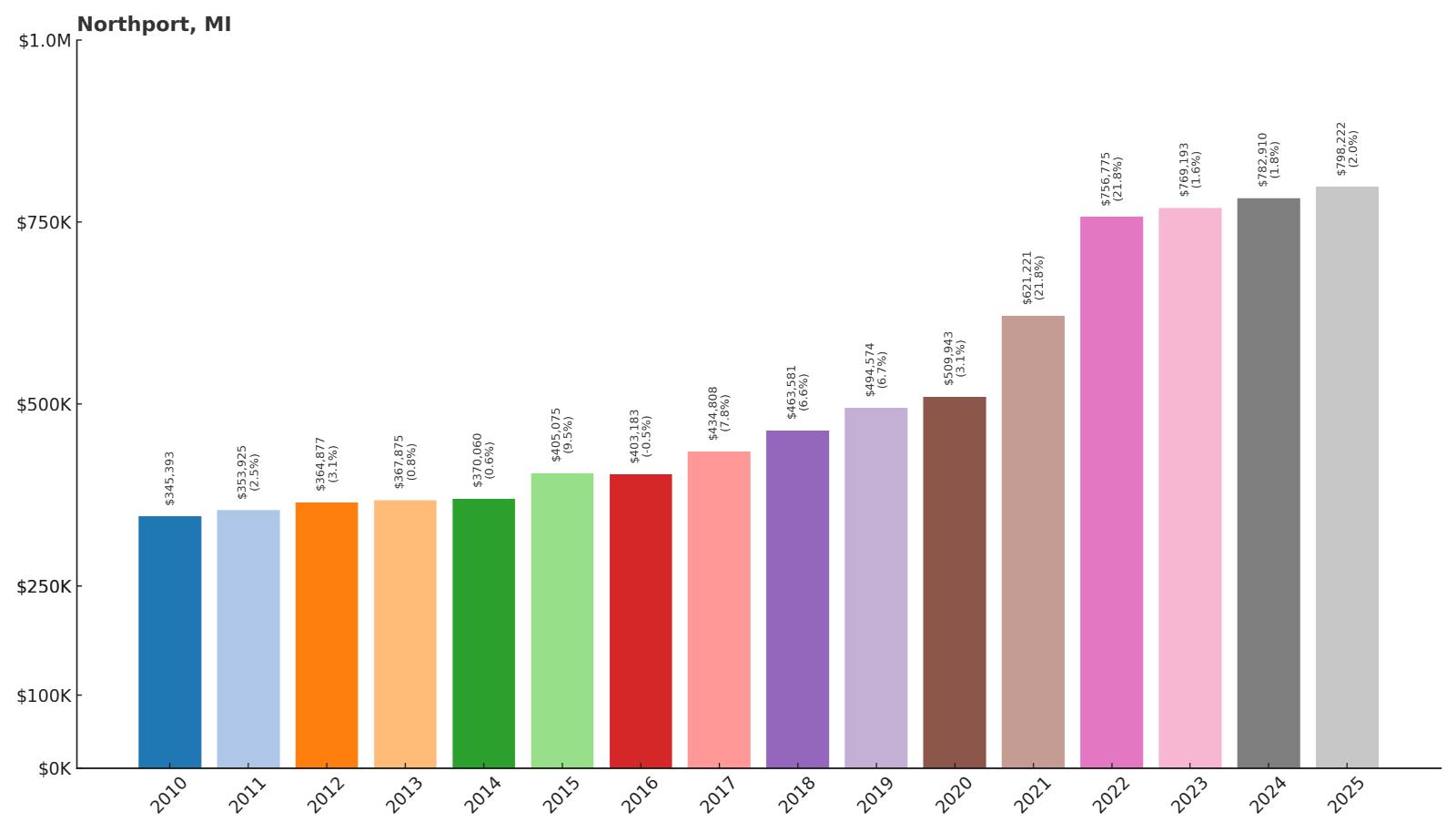
- 2010: $345,393
- 2011: $353,925
- 2012: $364,877
- 2013: $367,875
- 2014: $370,060
- 2015: $405,075
- 2016: $403,183
- 2017: $434,808
- 2018: $463,581
- 2019: $494,574
- 2020: $509,943
- 2021: $621,221
- 2022: $756,775
- 2023: $769,193
- 2024: $782,910
- 2025: $798,222
Northport demonstrated steady growth throughout the period, more than doubling from a substantial starting point of $345,393. The community experienced consistent appreciation with acceleration during the pandemic years that pushed values near $800,000. This Leelanau Peninsula community at the tip of the scenic M-22 corridor has benefited from its unique location and natural beauty.
Why Northport?
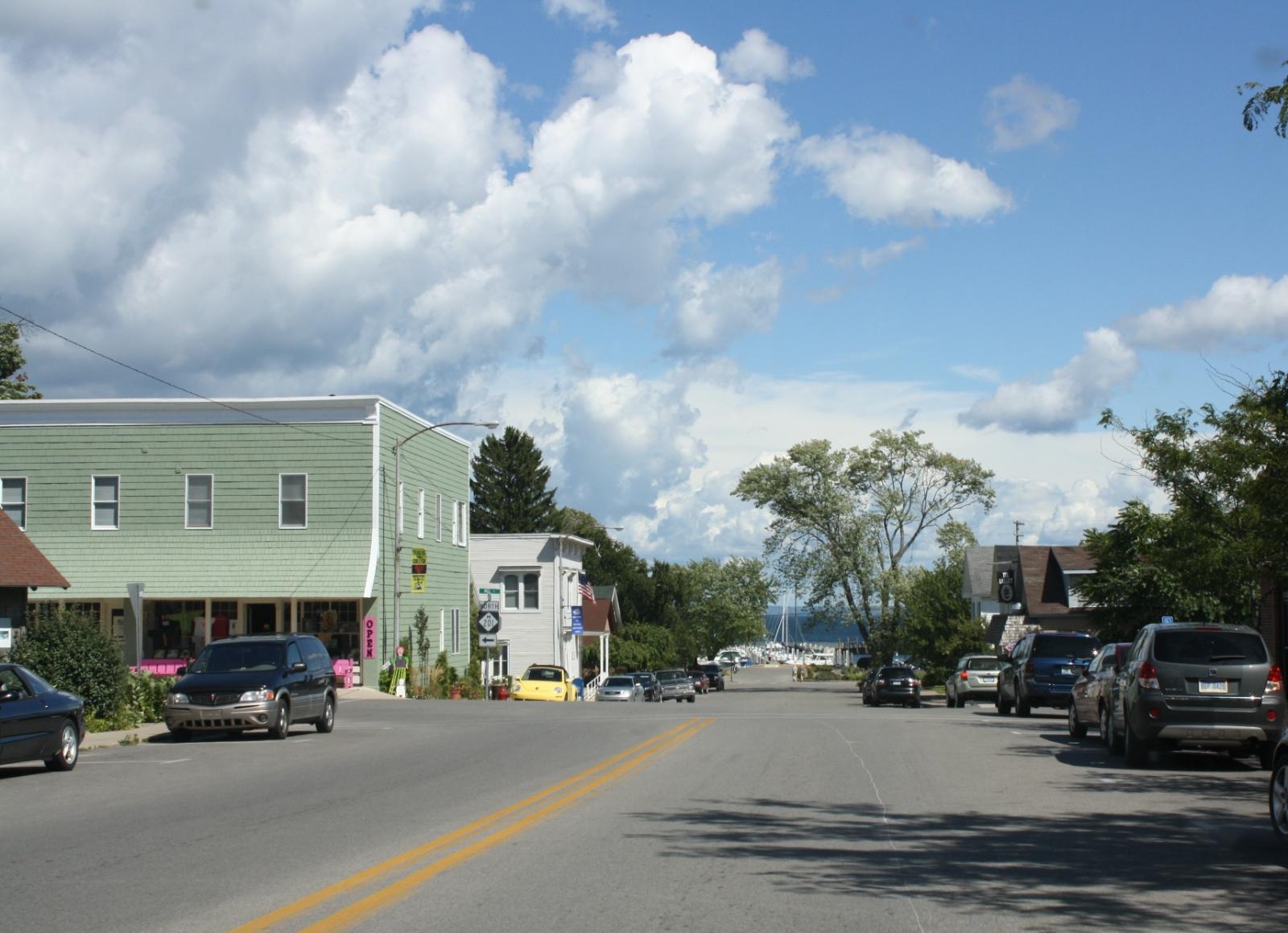
Why are people willing to pay so much to live here? What’s special about it?
Northport sits at the northern tip of the Leelanau Peninsula, offering breathtaking views of Grand Traverse Bay and access to some of Michigan’s most pristine natural areas. The town provides a charming harbor area, excellent marina facilities, and proximity to the Grand Traverse Lighthouse, creating a quintessential northern Michigan experience. Residents enjoy both the tranquility of a small lakefront community and easy access to Traverse City’s amenities.
The community’s location at the end of the scenic M-22 highway makes it feel like a special destination while still providing practical amenities and services. Northport appeals to buyers seeking the authentic northern Michigan lifestyle with quality infrastructure, recreational opportunities, and the natural beauty that makes the Leelanau Peninsula famous.
How Northport Rose to Prominence
Northport was established in the 1840s as a lumber town and port facility on Grand Traverse Bay. The community grew as a shipping point for timber and agricultural products from the Leelanau Peninsula. The town’s harbor provided shelter for vessels traveling the Great Lakes and became an important stop on shipping routes.
As the lumber industry declined, Northport evolved into a summer resort destination, capitalizing on its scenic location and harbor facilities. The development of the M-22 scenic highway and the area’s growing reputation for natural beauty helped transform Northport from a working port to one of northern Michigan’s most desirable residential communities.
3 Interesting Tidbits
1. Lighthouse Keeper – The Grand Traverse Lighthouse, located just north of Northport, is one of the oldest lighthouses on the Great Lakes and serves as a museum showcasing the area’s maritime heritage.
2. Marina Excellence – Northport’s marina is considered one of the finest on Grand Traverse Bay, offering full services and attracting boaters from throughout the Great Lakes region.
3. Peninsula Tip – As the northernmost community on the Leelanau Peninsula, Northport offers unique geographical positioning that provides spectacular views and a sense of being at the edge of the world.
7. Kewadin – 176.8% Home Price Increase Since 2010
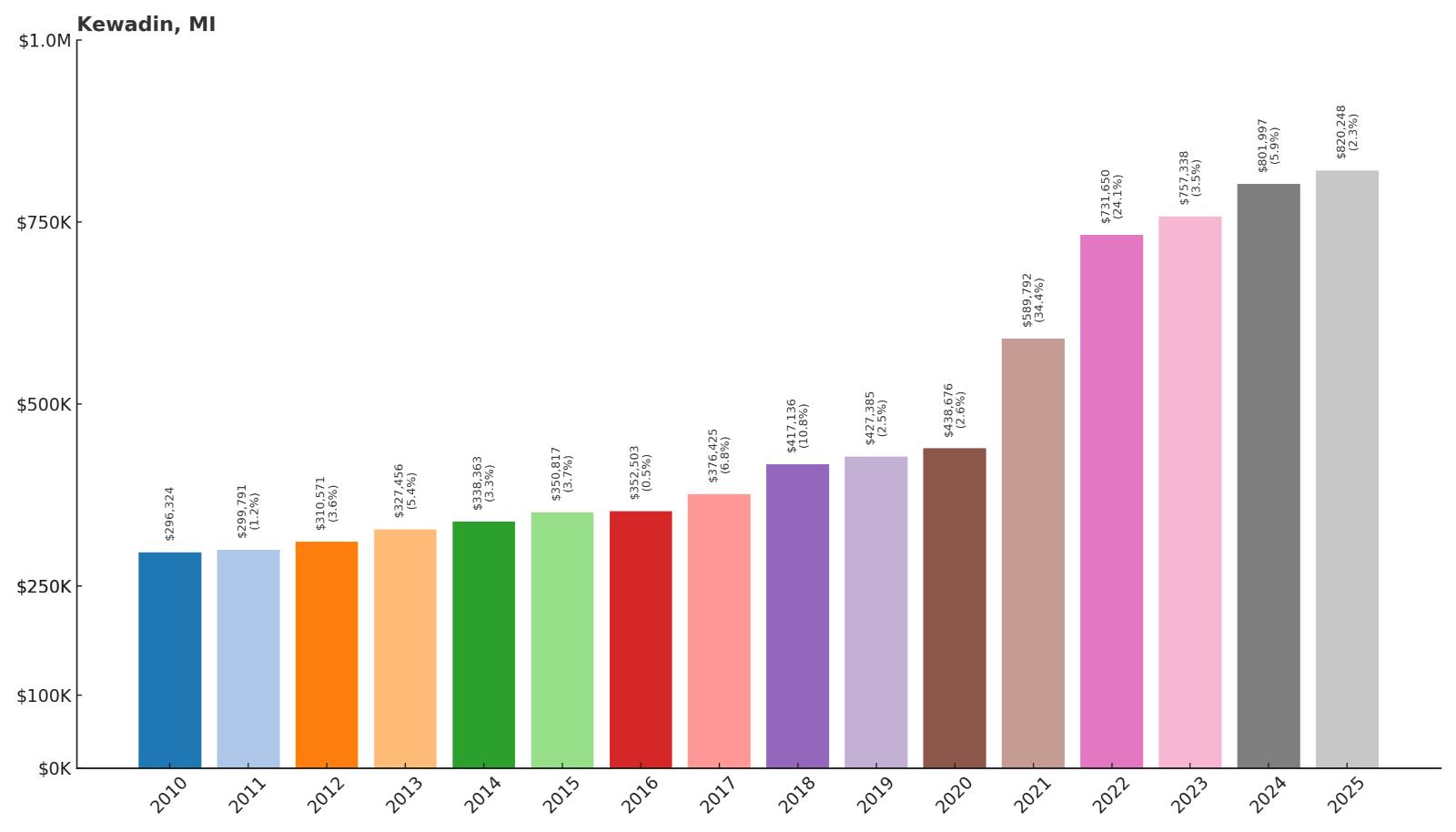
- 2010: $296,324
- 2011: $299,791
- 2012: $310,571
- 2013: $327,456
- 2014: $338,363
- 2015: $350,817
- 2016: $352,503
- 2017: $376,425
- 2018: $417,136
- 2019: $427,385
- 2020: $438,676
- 2021: $589,792
- 2022: $731,650
- 2023: $757,338
- 2024: $801,997
- 2025: $820,248
Kewadin achieved the third-highest growth rate at nearly 177% since 2010, with remarkable acceleration during the pandemic years. Values jumped from around $439,000 in 2020 to over $820,000 by 2025. This northern Michigan community has clearly benefited from the surge in demand for scenic, recreational properties in the Traverse City region.
Why Kewadin?
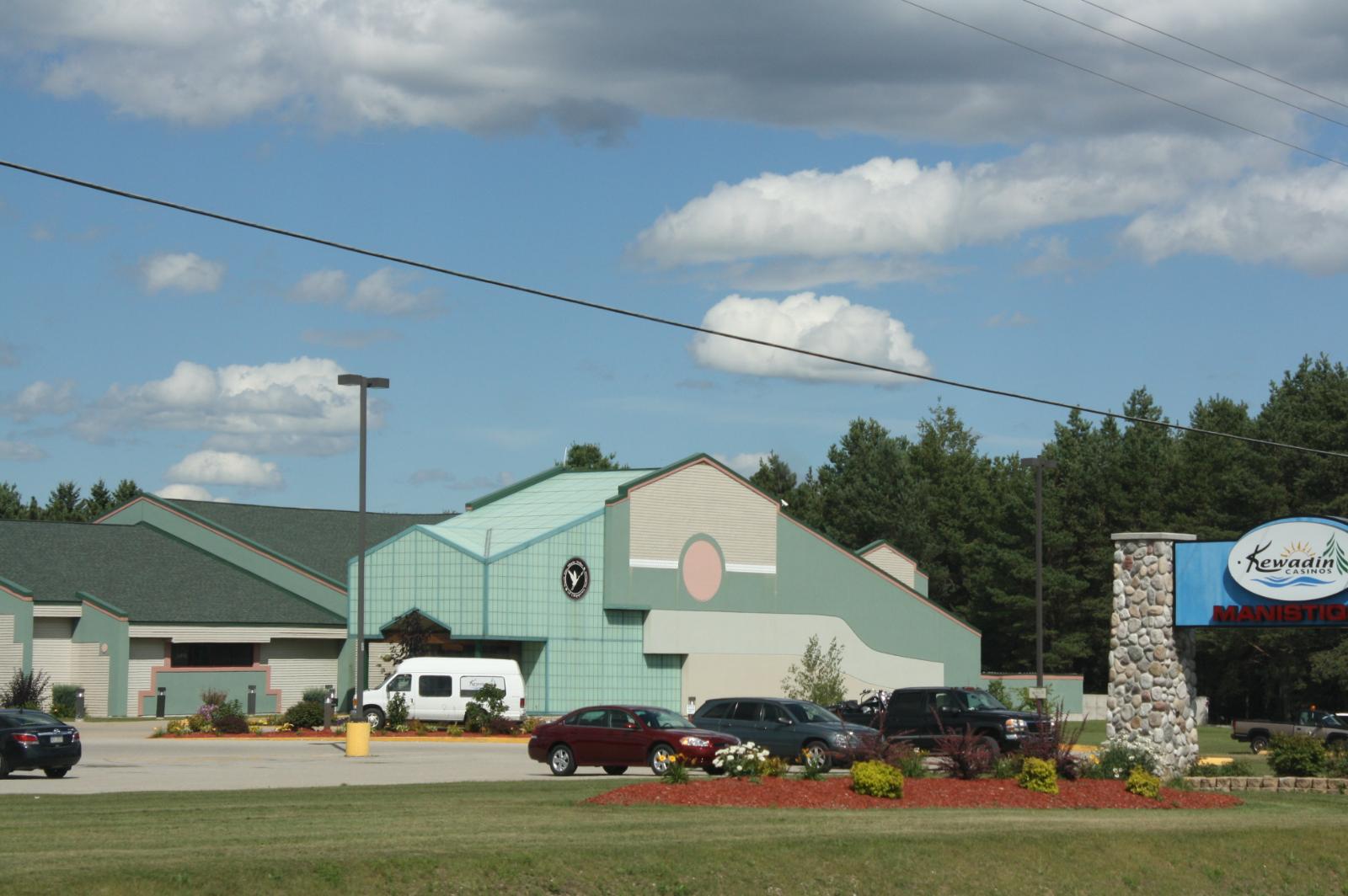
Why are people willing to pay so much to live here? What’s special about it?
Kewadin offers a perfect blend of northern Michigan natural beauty and convenient access to Traverse City’s amenities and employment opportunities. The community provides a rural, wooded setting with newer homes and larger lots while remaining close enough to the region’s cultural and commercial centers for daily convenience. Residents enjoy four-season recreational opportunities and the peaceful atmosphere that defines quality northern Michigan living.
The area appeals to buyers seeking the authentic northern Michigan experience without complete isolation from modern amenities. Kewadin’s growth reflects the broader trend of professionals and retirees choosing scenic, recreational areas as permanent residences rather than just vacation destinations.
How Kewadin Rose to Prominence
Kewadin began as a small farming and logging community in the late 1800s, serving the broader Grand Traverse region’s agricultural and timber industries. The area remained largely rural and undeveloped until recent decades when Traverse City’s growth and the region’s increasing appeal as a recreational destination began driving development pressure.
The community’s transformation accelerated with the development of the Kewadin Casino, which brought employment and attention to the area. However, the recent residential growth reflects broader trends toward northern Michigan living rather than casino-related development, as buyers have discovered the area’s combination of natural beauty and convenient location.
3 Interesting Tidbits
1. Casino Connection – The Kewadin Casino resort complex provides entertainment and employment opportunities that contribute to the area’s economic stability and appeal.
2. Native Heritage – The name Kewadin reflects the area’s Native American heritage, and the community maintains connections to the Grand Traverse Band of Ottawa and Chippewa Indians.
3. Recreational Access – Kewadin’s location provides easy access to multiple northern Michigan recreational destinations, from Sleeping Bear Dunes to Traverse City’s cultural attractions.
6. Lakeside – 120.0% Home Price Increase Since 2010
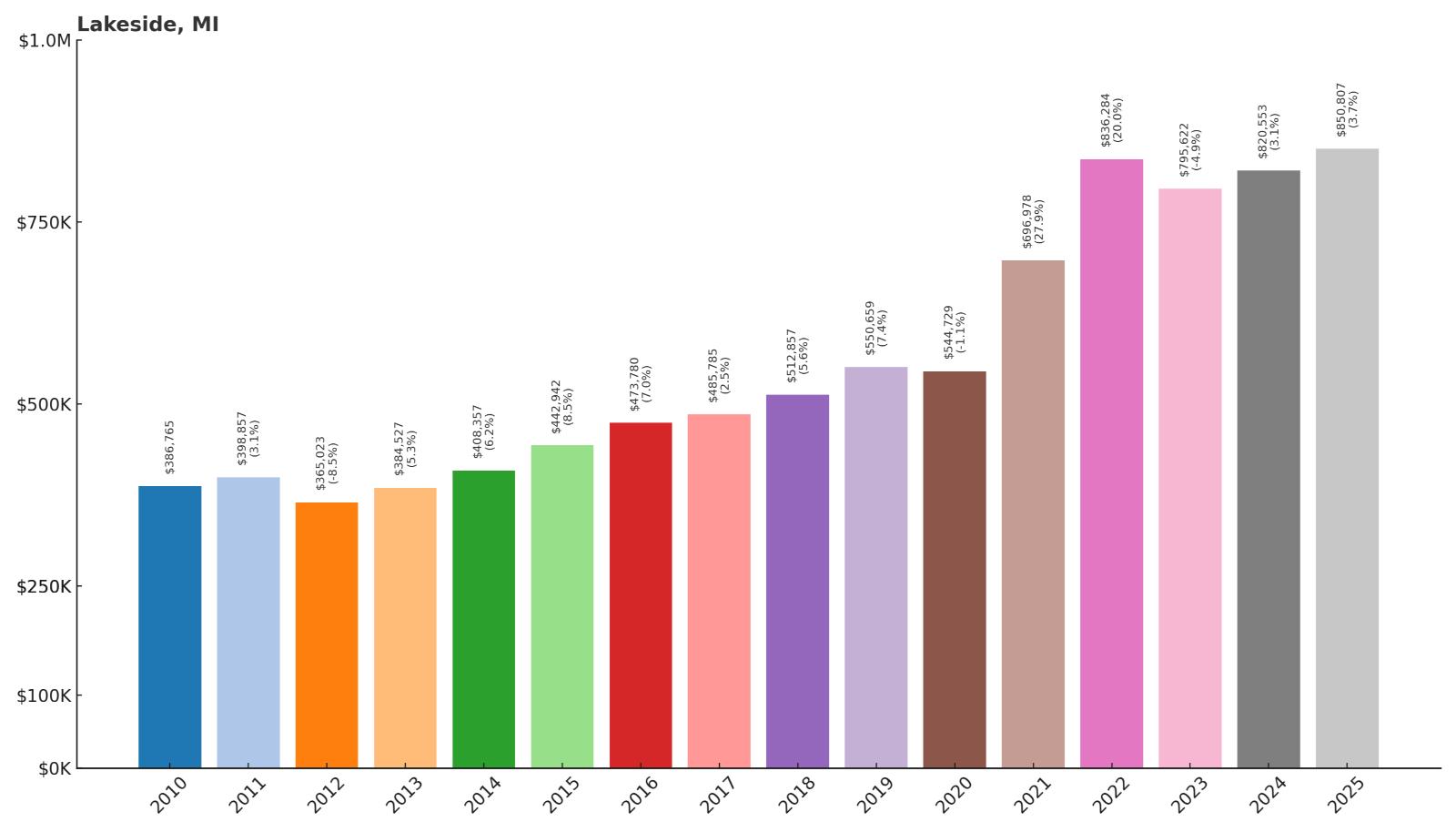
- 2010: $386,765
- 2011: $398,857
- 2012: $365,023
- 2013: $384,527
- 2014: $408,357
- 2015: $442,942
- 2016: $473,780
- 2017: $485,785
- 2018: $512,857
- 2019: $550,659
- 2020: $544,729
- 2021: $696,978
- 2022: $836,284
- 2023: $795,622
- 2024: $820,553
- 2025: $850,807
Lakeside started from a high base of nearly $387,000 and more than doubled to over $850,000 by 2025. The community experienced steady growth through 2020, followed by dramatic increases during the pandemic years. This Harbor Country community’s premium pricing reflects its position as one of southwestern Michigan’s most exclusive lakefront destinations.
Why Lakeside?
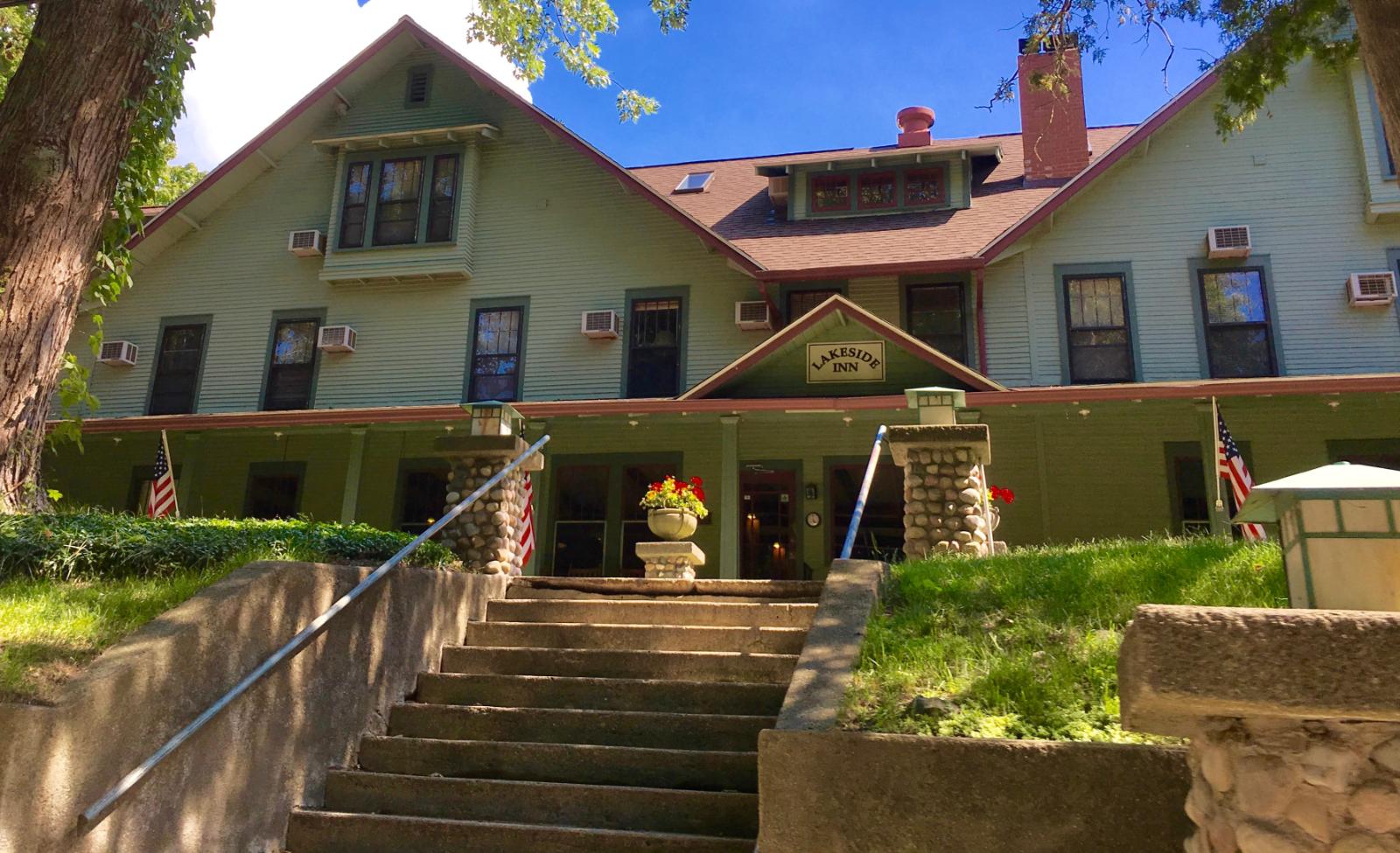
Why are people willing to pay so much to live here? What’s special about it?
Lakeside represents the epitome of Harbor Country luxury, offering exclusive lakefront properties with direct Lake Michigan access and sophisticated amenities. The community features beautiful beaches, upscale homes, and a refined atmosphere that attracts affluent buyers from Chicago and throughout the Midwest. Residents enjoy privacy and natural beauty while maintaining access to the broader Harbor Country resort amenities.
The area’s careful development has preserved its natural character while accommodating luxury homes and amenities that appeal to discerning buyers. Lakeside offers the ultimate lakefront lifestyle with the additional benefits of exclusivity and proximity to Chicago, making it a premier choice for luxury second homes and primary residences.
How Lakeside Rose to Prominence
Lakeside developed as part of the broader Harbor Country movement that began attracting wealthy Chicago families in the late 1800s. The area’s beautiful beaches and convenient rail access made it a natural choice for summer estates and resort development. Lakeside distinguished itself by focusing on more exclusive, residential development compared to the more commercial resort areas.
The community’s growth has emphasized luxury and exclusivity, attracting buyers who wanted the finest lakefront living available in the region. Lakeside’s reputation for quality development and natural beauty has made it one of Harbor Country’s most sought-after addresses for those who can afford premium lakefront real estate.
3 Interesting Tidbits
1. Exclusive Development – Lakeside features some of Harbor Country’s most expensive and exclusive residential developments, with many properties offering private beach access and luxury amenities.
2. Natural Preservation – The community has carefully preserved its natural lakefront character while accommodating luxury development, maintaining the balance between exclusivity and environmental stewardship.
3. Chicago Magnet – Many Lakeside properties are owned by Chicago-area professionals and business leaders who use them as weekend retreats and summer residences, contributing to the area’s upscale character.
5. Lake Leelanau – 133.9% Home Price Increase Since 2010
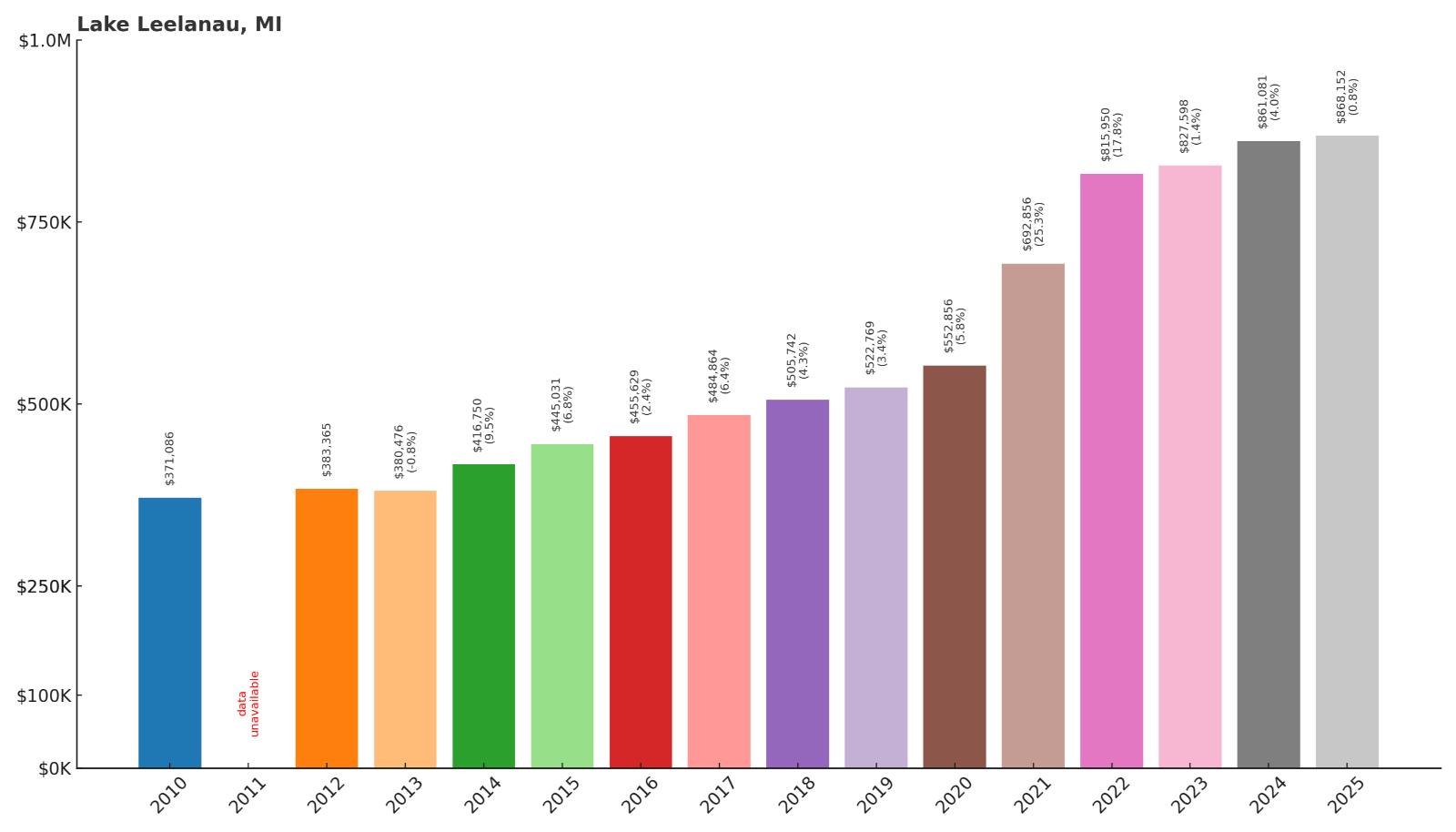
- 2010: $371,086
- 2011: N/A
- 2012: $383,365
- 2013: $380,476
- 2014: $416,750
- 2015: $445,031
- 2016: $455,629
- 2017: $484,864
- 2018: $505,742
- 2019: $522,769
- 2020: $552,856
- 2021: $692,856
- 2022: $815,950
- 2023: $827,598
- 2024: $861,081
- 2025: $868,152
Lake Leelanau achieved strong growth of nearly 134% since 2010, with steady appreciation throughout most of the period and dramatic increases during the pandemic years. Current values at over $868,000 reflect this community’s appeal as a premier destination within the famous Leelanau Peninsula wine and recreation region.
Why Lake Leelanau?
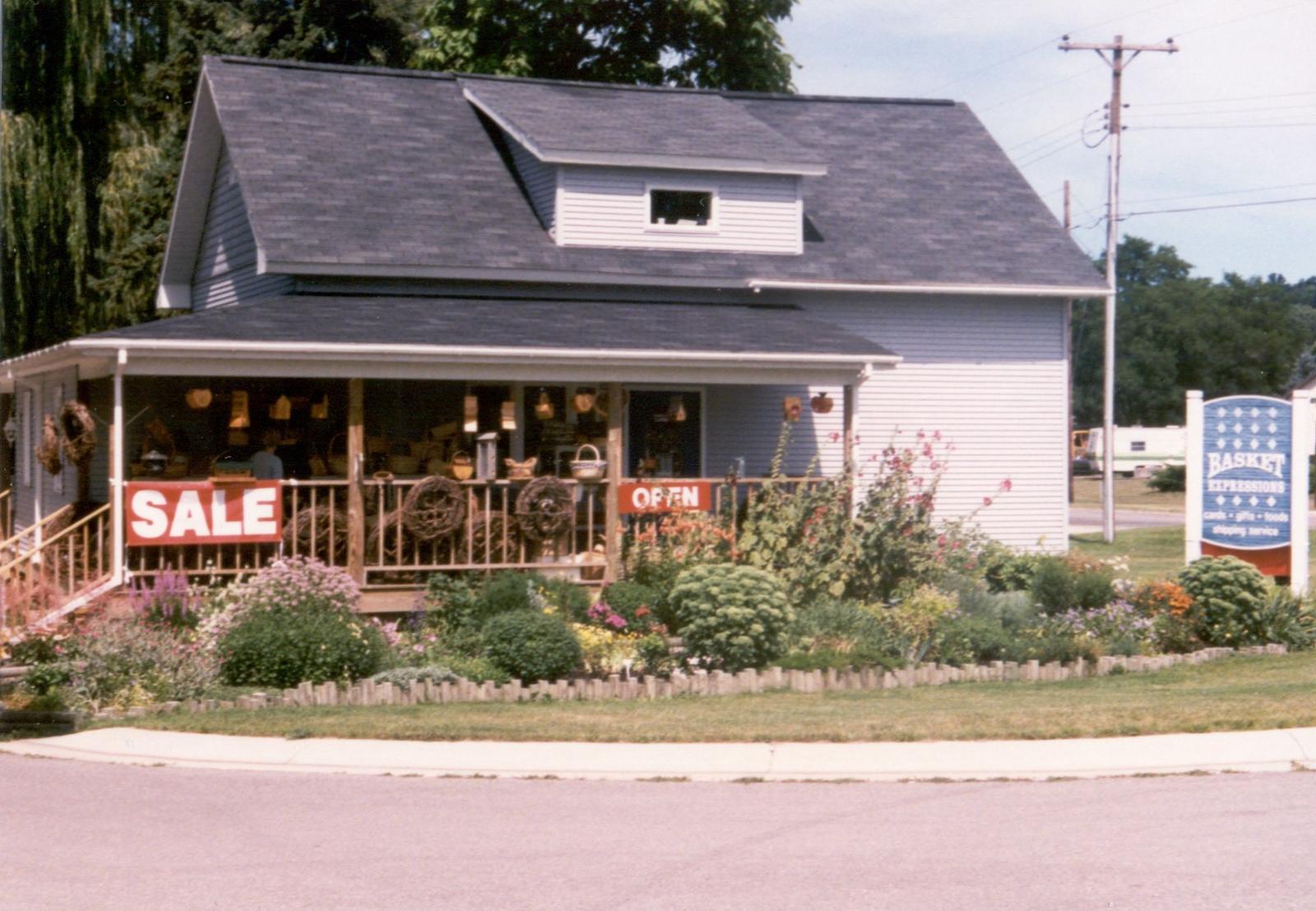
Why are people willing to pay so much to live here? What’s special about it?
Lake Leelanau offers the quintessential northern Michigan lakefront experience, with beautiful clear waters, scenic surroundings, and proximity to the region’s famous wineries and recreational attractions. The community provides a perfect balance of natural beauty and sophisticated amenities, appealing to buyers seeking luxury lakefront living in one of Michigan’s most celebrated destinations. Access to both lake activities and land-based recreation creates year-round appeal.
Residents enjoy the benefits of living within the broader Leelanau Peninsula’s wine country and tourist region while maintaining the exclusivity and tranquility of a smaller lakefront community. Lake Leelanau’s reputation for natural beauty and recreational opportunities attracts affluent buyers who value both lifestyle quality and investment potential.
How Lake Leelanau Rose to Prominence
Lake Leelanau developed around the long, narrow lake that gives the community its name, originally serving farming and timber industries in the 19th century. The area’s transformation began in the mid-20th century when visitors discovered the lake’s exceptional beauty and recreational opportunities. The development of the Leelanau Peninsula’s wine industry and tourism sector significantly elevated the area’s profile.
The community’s growth as a luxury destination accelerated with the broader recognition of northern Michigan as a premier recreational and retirement destination. Lake Leelanau’s combination of lakefront beauty, wine country atmosphere, and proximity to other Leelanau Peninsula attractions has made it one of the region’s most desirable addresses.
3 Interesting Tidbits
1. Wine Country Heart – Lake Leelanau sits at the center of the Leelanau Peninsula’s renowned wine region, with numerous award-winning wineries located along the lake’s shores and nearby hills.
2. Long Lake Living – The lake itself stretches over 20 miles through the peninsula’s center, providing extensive shoreline and diverse lakefront living opportunities from quiet coves to open water areas.
3. Four Season Appeal – The community offers year-round recreation, from summer boating and swimming to winter activities and the famous fall color tours that attract visitors from across the Midwest.
4. Franklin – 121.7% Home Price Increase Since 2010
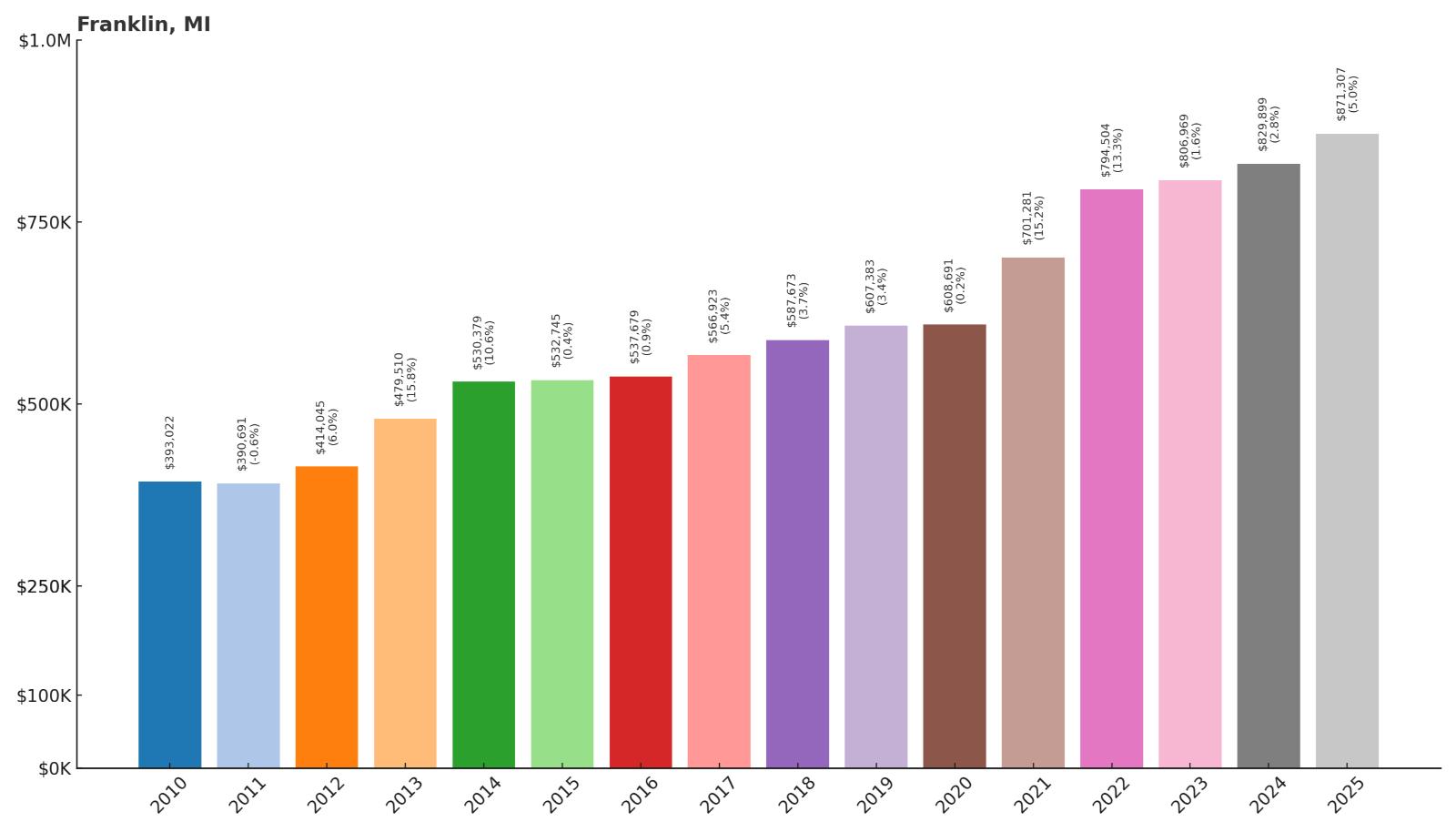
- 2010: $393,022
- 2011: $390,691
- 2012: $414,045
- 2013: $479,510
- 2014: $530,379
- 2015: $532,745
- 2016: $537,679
- 2017: $566,923
- 2018: $587,673
- 2019: $607,383
- 2020: $608,691
- 2021: $701,281
- 2022: $794,504
- 2023: $806,969
- 2024: $829,899
- 2025: $871,307
Franklin more than doubled in value since 2010, starting from a substantial base of $393,022. The village experienced particularly strong growth from 2012-2014 and steady appreciation throughout the period, reaching over $871,000 by 2025. This Oakland County community represents one of Michigan’s most prestigious small-town addresses, combining historic charm with modern luxury.
Why Franklin?
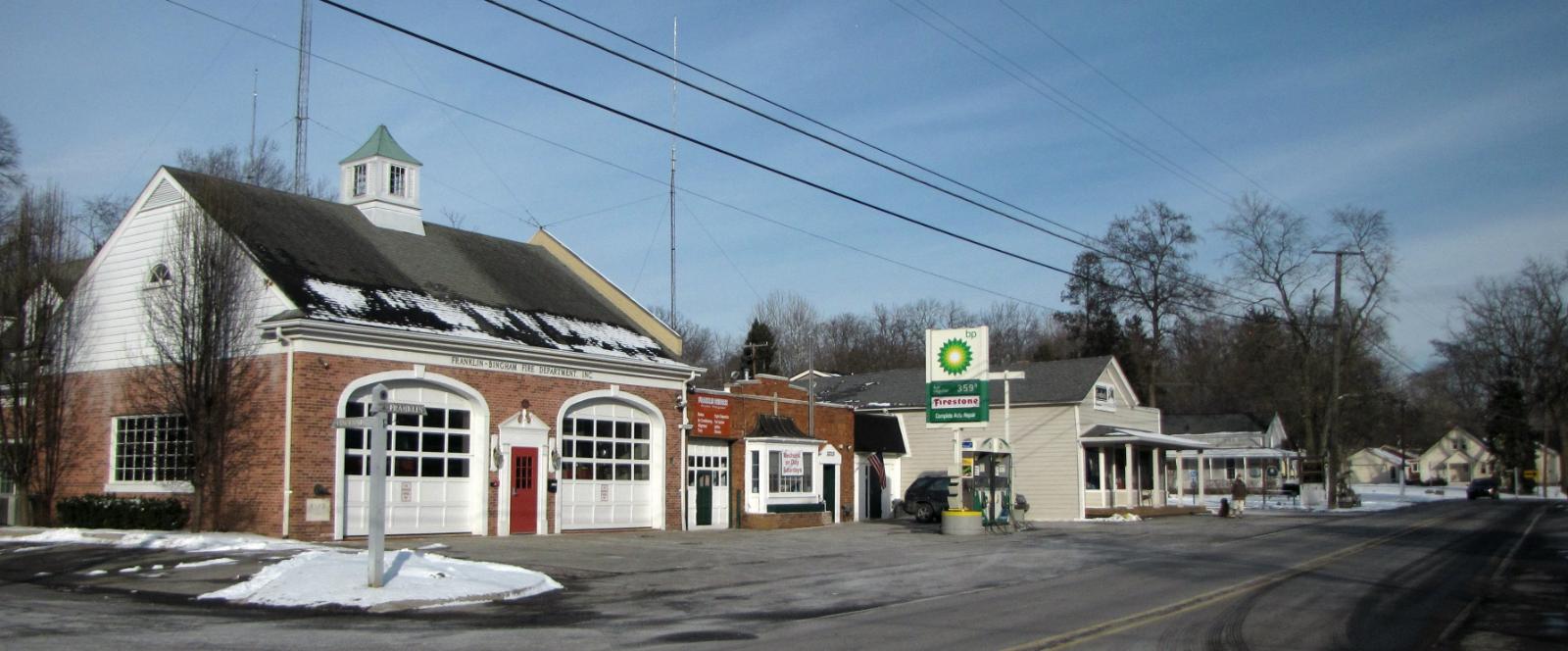
Why are people willing to pay so much to live here? What’s special about it?
Franklin offers the unique charm of a historic village setting within one of Michigan’s most affluent areas, featuring tree-lined streets, historic homes, and a genuine small-town atmosphere despite its proximity to major urban centers. The village maintains strict zoning that preserves its character while accommodating luxury homes that appeal to buyers seeking authenticity and exclusivity. Residents enjoy excellent schools, beautiful parks, and the prestige of a Franklin address.
The community provides an escape from suburban uniformity, offering varied architecture, mature landscapes, and a walkable village center that creates genuine community connections. Franklin appeals to affluent buyers who value character, history, and the rare opportunity to live in a true village setting without sacrificing modern amenities or convenience.
How Franklin Rose to Prominence
Franklin was founded in 1824 and incorporated as a village in 1953, making it one of Oakland County’s oldest communities. The village grew around mills and agricultural activities along the Franklin Creek, developing the compact, walkable character that defines it today. Unlike many suburban developments, Franklin preserved its original village layout and historic buildings.
The community’s appeal grew as suburban development surrounded it, making Franklin’s historic character increasingly rare and valuable. The village’s commitment to preserving its unique identity while accommodating quality development has created one of Michigan’s most distinctive and desirable residential environments.
3 Interesting Tidbits
1. Historic Preservation – Franklin maintains numerous 19th-century buildings and has been recognized for its commitment to historic preservation while accommodating modern residential needs.
2. Village Life – Despite being surrounded by larger communities, Franklin operates as a true village with its own government, creating an intimate civic environment where residents actively participate in community decisions.
3. Natural Features – The village encompasses Franklin Creek and significant wooded areas that provide natural beauty and recreational opportunities within its compact boundaries.
3. Orchard Lake – 85.0% Home Price Increase Since 2010

- 2010: $504,143
- 2011: $483,629
- 2012: $506,485
- 2013: $553,563
- 2014: $622,537
- 2015: $614,297
- 2016: $602,343
- 2017: $648,694
- 2018: $667,891
- 2019: $666,715
- 2020: $661,391
- 2021: $782,818
- 2022: $897,952
- 2023: $899,708
- 2024: $910,771
- 2025: $932,734
Orchard Lake started from the highest base price at over $504,000 in 2010 and increased 85% to reach nearly $933,000 by 2025. While showing the lowest percentage growth among the top communities, the village maintained consistently high values throughout the period with significant increases during the pandemic years. The premium pricing reflects Orchard Lake’s long-established reputation as one of Michigan’s most exclusive addresses.
Why Orchard Lake?
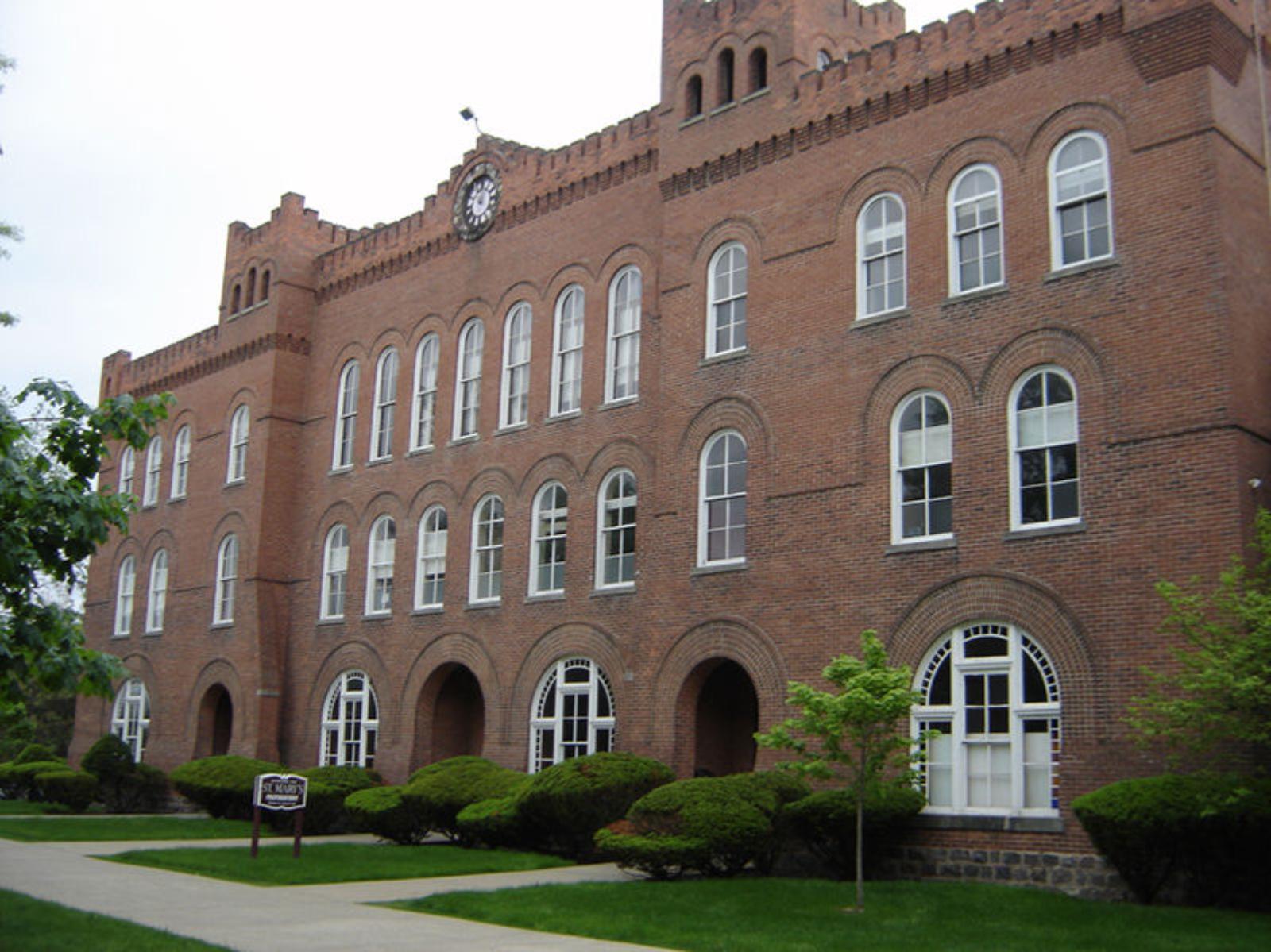
Why are people willing to pay so much to live here? What’s special about it?
Orchard Lake represents the pinnacle of Michigan luxury living, featuring spectacular lakefront estates, pristine recreational facilities, and an exclusive community atmosphere that has attracted prominent families for generations. The village provides private lake access, beautiful beaches, and some of Michigan’s most expensive homes in a setting that combines natural beauty with sophisticated amenities. Residents enjoy world-class boating, swimming, and recreational opportunities on one of the state’s most beautiful inland lakes.
The community’s exclusivity and natural beauty create a resort-like environment for year-round living, appealing to successful business leaders, professional athletes, and other high-net-worth individuals who value privacy and prestige. Orchard Lake offers the ultimate combination of luxury amenities, natural beauty, and convenient access to Detroit area opportunities.
How Orchard Lake Rose to Prominence
Orchard Lake was established in the early 1900s as an exclusive summer retreat for Detroit’s wealthy families, particularly automotive industry leaders who built magnificent estates around the lake. The community was designed from the beginning as a luxury destination, with large lots, private lake access, and amenities that catered to affluent residents. The village incorporated in 1973 to maintain control over its exclusive character.
Throughout the 20th century, Orchard Lake maintained its reputation as Michigan’s most prestigious lakefront community, attracting celebrities, business magnates, and other prominent individuals who valued the combination of luxury, privacy, and natural beauty. The village’s continued exclusivity has sustained its position at the top of Michigan’s residential real estate market.
3 Interesting Tidbits
1. Celebrity Haven – Orchard Lake has been home to numerous professional athletes, entertainment figures, and business leaders who appreciate the privacy and luxury the community provides.
2. Lake Paradise – The lake itself covers 795 acres and offers some of Michigan’s finest inland water recreation, with crystal-clear waters and excellent fishing and boating opportunities.
3. Architectural Showcase – The village features some of Michigan’s most spectacular homes, from historic estates to ultra-modern architectural masterpieces that showcase the owners’ success and taste.
2. Leland – 179.5% Home Price Increase Since 2010
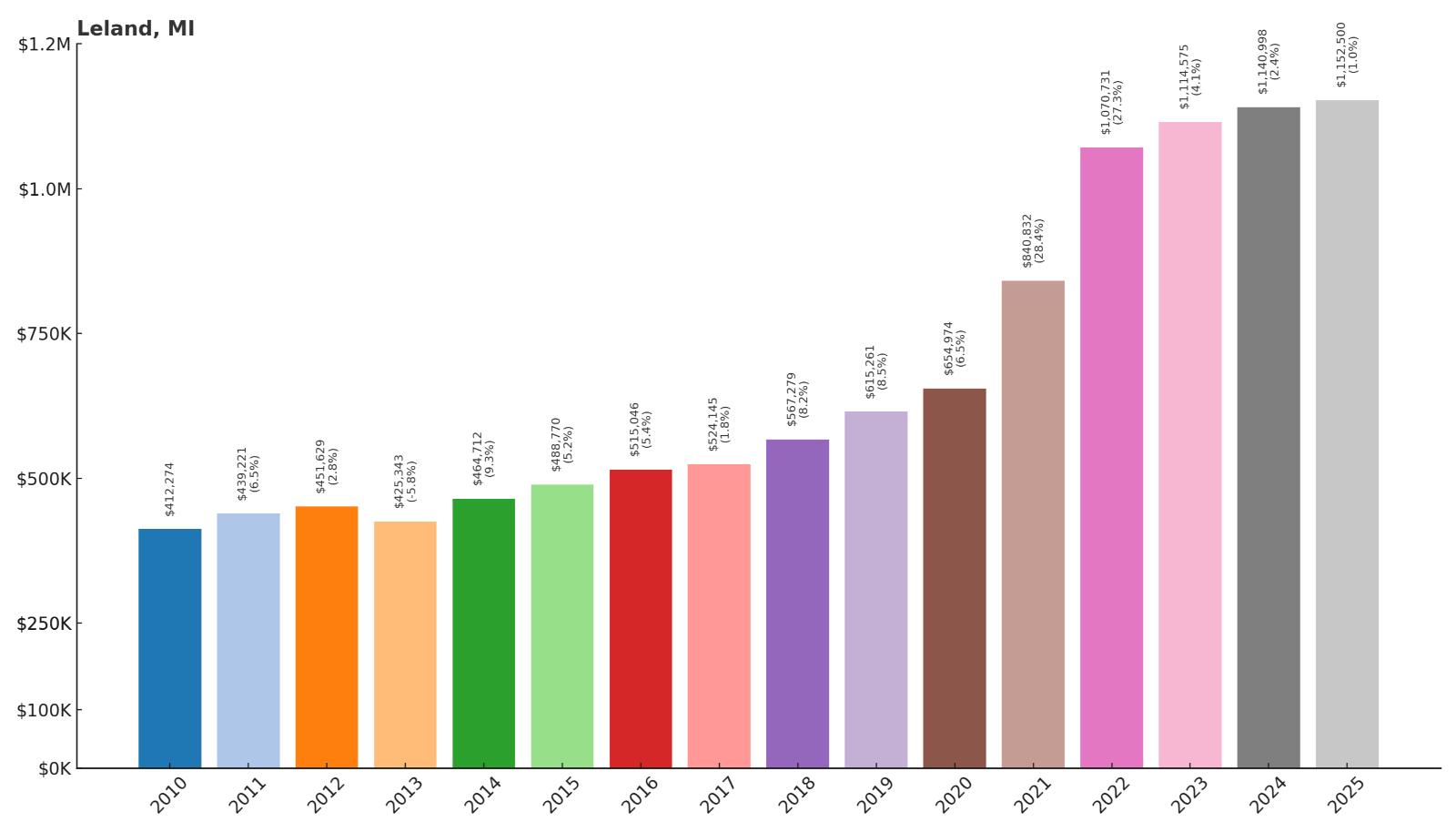
- 2010: $412,274
- 2011: $439,221
- 2012: $451,629
- 2013: $425,343
- 2014: $464,712
- 2015: $488,770
- 2016: $515,046
- 2017: $524,145
- 2018: $567,279
- 2019: $615,261
- 2020: $654,974
- 2021: $840,832
- 2022: $1,070,731
- 2023: $1,114,575
- 2024: $1,140,998
- 2025: $1,152,500
Leland achieved the second-highest growth rate at nearly 180% since 2010, with explosive increases during the pandemic years that pushed values above $1.15 million. The community showed steady appreciation through 2020, then dramatic jumps that reflect its position as one of northern Michigan’s most desirable destinations. Historic Fishtown and the town’s unique character have created exceptional demand among affluent buyers.
Why Leland?
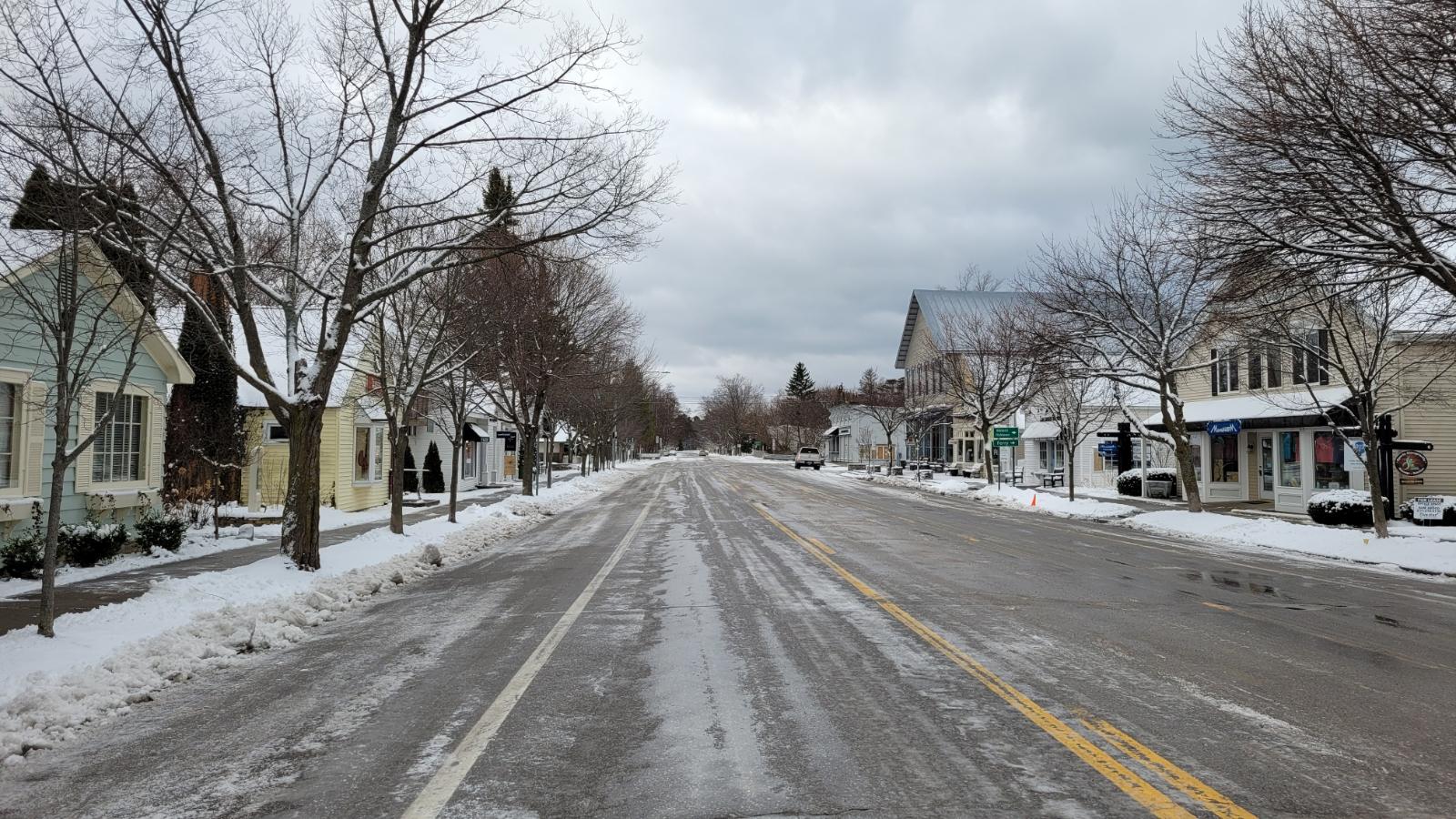
Why are people willing to pay so much to live here? What’s special about it?
Leland offers one of Michigan’s most unique residential experiences, centered around the historic Fishtown district with its authentic working fishing village atmosphere and stunning Lake Michigan access. The community provides a rare combination of maritime heritage, natural beauty, and sophisticated amenities that create an unmatched lifestyle experience. Residents enjoy direct access to pristine beaches, world-class fishing, and ferry service to the Manitou Islands within Sleeping Bear Dunes National Lakeshore.
The town’s authentic character and limited development opportunities create scarcity that drives premium pricing among buyers seeking genuine northern Michigan living. Leland appeals to affluent individuals who value authenticity, natural beauty, and the prestige of owning property in one of Michigan’s most photographed and celebrated communities.
How Leland Rose to Prominence
Leland was established in the 1850s on the site of a historic Ottawa village, taking advantage of the natural harbor where the Leland River meets Lake Michigan. The town grew as a lumber port and fishing village, with commercial fishing operations that created the weathered shanties and docks that now form the famous Fishtown district. The decline of commercial fishing in the mid-20th century threatened the area’s character.
The transformation came with the recognition of Fishtown’s unique historical value and its designation as a historic site. The Fishtown Preservation Society has maintained the working fishing village character while adapting buildings for shops and restaurants, creating a tourist destination that supports the local economy while preserving authentic maritime heritage.
3 Interesting Tidbits
1. Fishtown Legacy – The historic Fishtown district remains one of the last working commercial fishing villages on the Great Lakes, with authentic shanties, smokehouses, and fishing boats that continue operating today.
2. Island Gateway – Leland serves as the departure point for ferry service to North and South Manitou Islands, making it the gateway to some of Michigan’s most pristine wilderness areas.
3. County Heritage – Leland served as the Leelanau County seat from 1883 to 2004, giving it governmental importance and infrastructure that supported its development as a regional center.
1. Lake Angelus – 108.8% Home Price Increase Since 2013
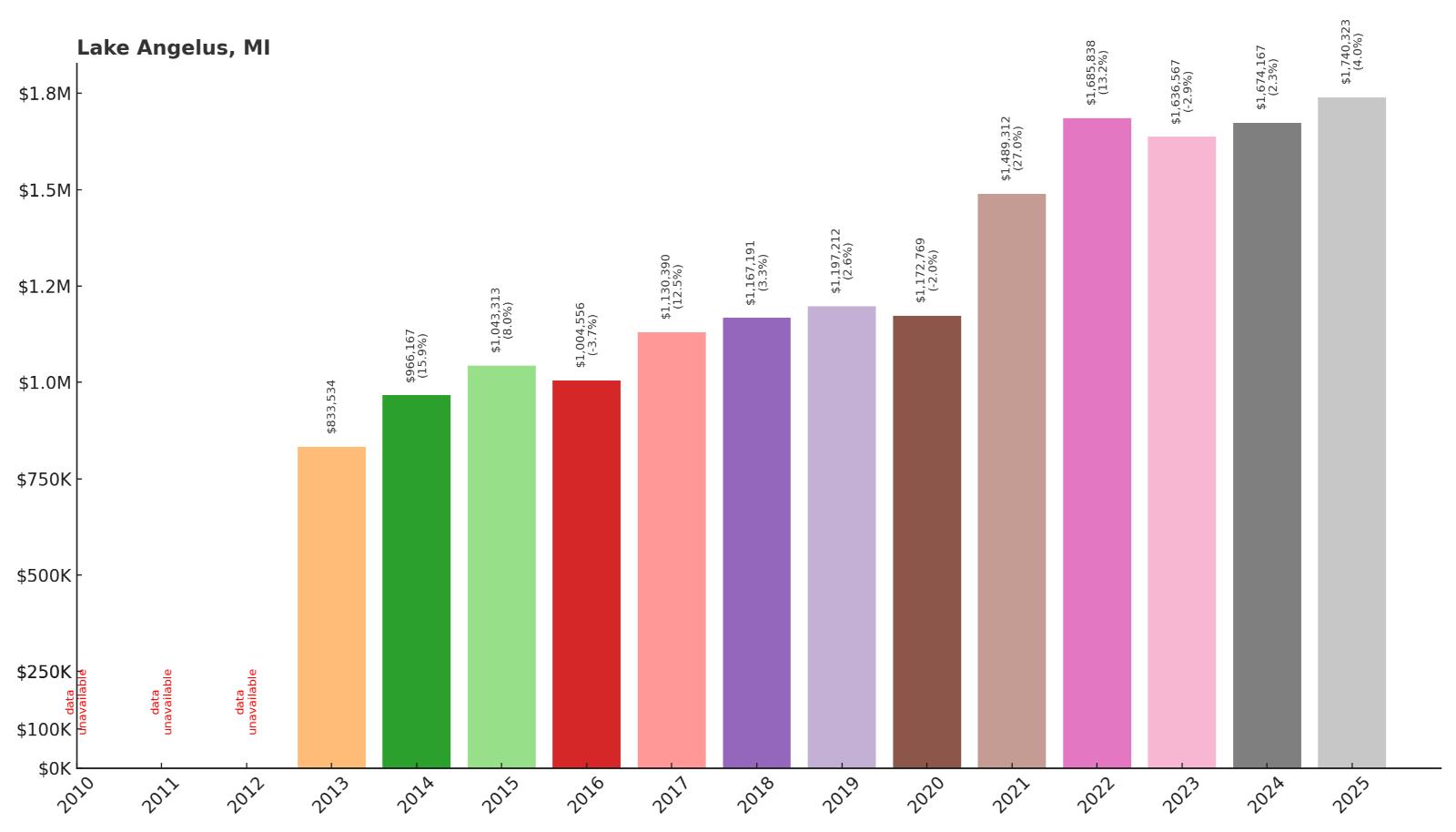
- 2010: N/A
- 2011: N/A
- 2012: N/A
- 2013: $833,534
- 2014: $966,167
- 2015: $1,043,313
- 2016: $1,004,556
- 2017: $1,130,390
- 2018: $1,167,191
- 2019: $1,197,212
- 2020: $1,172,769
- 2021: $1,489,312
- 2022: $1,685,838
- 2023: $1,636,567
- 2024: $1,674,167
- 2025: $1,740,323
Lake Angelus tops Michigan’s most expensive communities with median values exceeding $1.74 million in 2025. Starting from over $833,000 in 2013, the community achieved strong growth with dramatic increases during the pandemic years. The limited data history reflects the exclusive nature of this private lake community where few properties change hands, but those that do command premium prices that reflect ultimate luxury living in Michigan.
Why Lake Angelus?
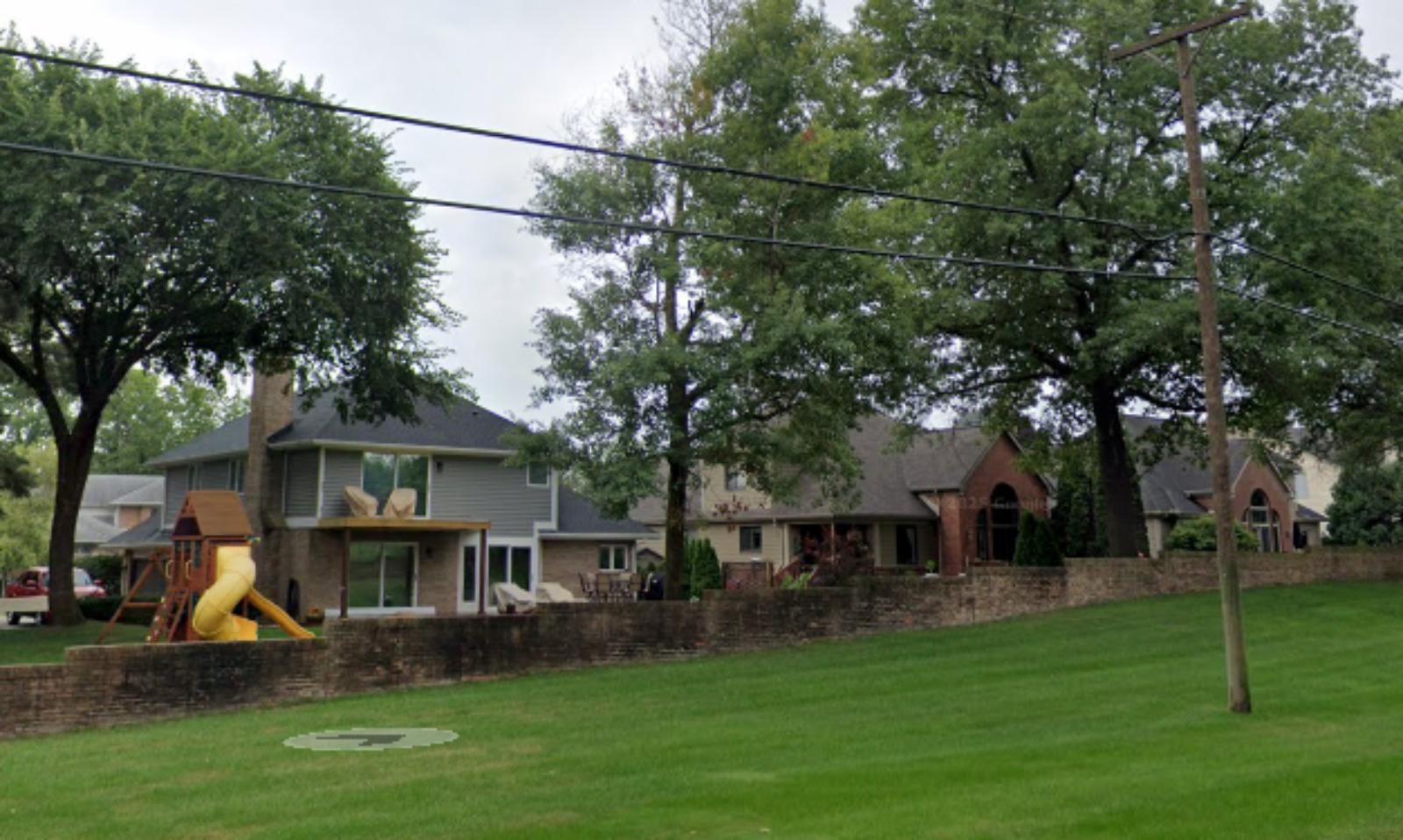
Why are people willing to pay so much to live here? What’s special about it?
Lake Angelus represents the absolute pinnacle of Michigan luxury living, featuring exclusive lakefront estates on a private, all-sports lake with restricted access and unparalleled privacy. The community offers the ultimate in waterfront luxury with custom-built homes on substantial lots, private beaches, and boat docks that create a resort-like environment for year-round living. Residents enjoy complete privacy and security while remaining conveniently located near Detroit’s business and cultural centers.
The combination of exclusivity, natural beauty, and luxury amenities attracts the state’s most successful individuals, including business leaders, professional athletes, and entertainment figures who value privacy above all else. Lake Angelus provides the rare opportunity to own property on a completely private lake where access is controlled and the lifestyle is unmatched anywhere in Michigan.
How Lake Angelus Rose to Prominence
Lake Angelus was originally called Three Mile Lake and was renamed in 1920 by early developer Mrs. Sollace B. Collidge, who envisioned it as an exclusive residential community. The lake and surrounding area were developed specifically for wealthy individuals seeking privacy and luxury in a controlled environment. The community’s exclusivity was established from the beginning with restricted access and carefully planned development.
The area’s development coincided with Detroit’s emergence as the automotive capital, attracting industry leaders and successful entrepreneurs who built magnificent estates around the private lake. Lake Angelus maintained its exclusive character throughout changing economic conditions by limiting access and preserving the natural beauty that makes it Michigan’s most prestigious address.
3 Interesting Tidbits
1. Private Paradise – Lake Angelus is a completely private, 477-acre all-sports lake where access is restricted to property owners and their guests, creating an exclusive aquatic playground.
2. Automotive Elite – The community has been home to numerous automotive industry executives and continues to attract Michigan’s business elite who value the ultimate in privacy and luxury.
3. Controlled Environment – Special permits are required to use the lake, and strict regulations govern everything from boat types to noise levels, ensuring that the exclusive character is maintained for all residents.






